
Decorative Arts: Design since 1860 | 616
Live Online | Viewing in Edinburgh
PAST AUCTION
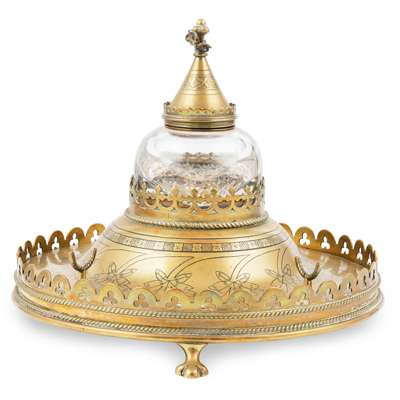
LOT 1
ATTRIBUTED TO HART, SON, PEARD & CO.
GOTHIC REVIVAL BRASS INKSTAND, CIRCA 1880
SOLD FOR £325

LOT 2
ENGLISH SCHOOL
GOTHIC REVIVAL BRASS CHANDELIER, CIRCA 1870
SOLD FOR £575

LOT 3
ATTRIBUTED TO HART, SON, PEARD & CO.
PAIR OF GOTHIC REVIVAL BRASS CANDELABRA, CIRCA 1870
SOLD FOR £450

LOT 4
A.W.N. PUGIN (1812-1952) FOR THE HOUSES OF PARLIAMENT
PENNANT & FINIAL, CIRCA 1850
SOLD FOR £1,125

LOT 5
ENGLISH SCHOOL
PAIR OF GOTHIC REVIVAL BRASS PRICKET CANDLESTICKS, CIRCA 1870
SOLD FOR £350
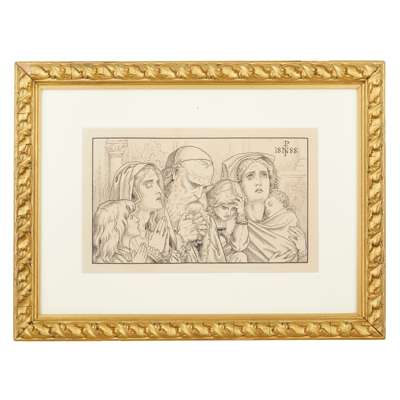
LOT 6
SIR JOSEPH NOEL PATON (1821-1901)
FAMILY AT PRAYER
SOLD FOR £750
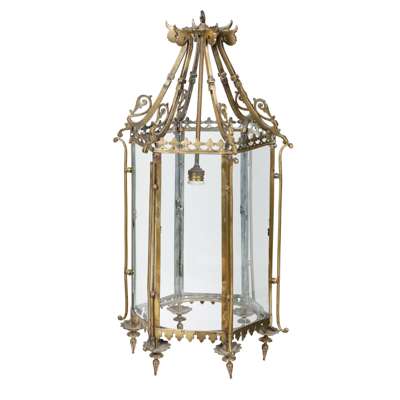
LOT 7
ENGLISH SCHOOL, MANNER OF A.W.N. PUGIN
GOTHIC REVIVAL HALL LANTERN, CIRCA 1880
SOLD FOR £400
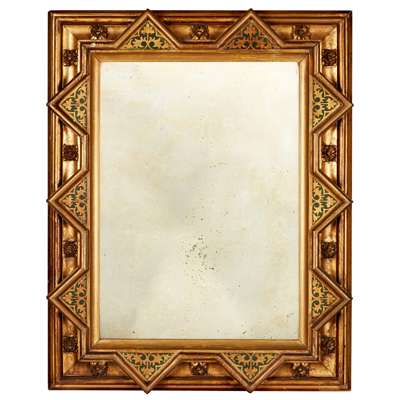
LOT 8
MANNER OF E. W. PUGIN
GOTHIC REVIVAL CARVED GILTWOOD WALL MIRROR, CIRCA 1870
SOLD FOR £2,375
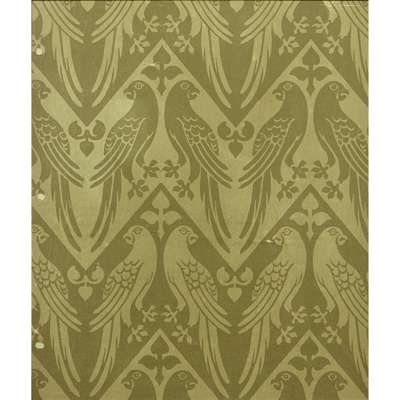
LOT 9
A.W.N. PUGIN (1812-1852), PROBABLY FOR CRACE & SON
FRAMED OIL CLOTH SAMPLE, CIRCA 1900
SOLD FOR £1,000
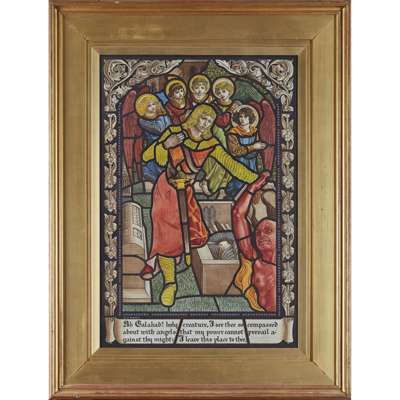
LOT 10
HENRY J. HUNT (1867-1951)
'AH GALAHAD!', A LARGE CARTOON FOR STAINED GLASS, CIRCA 1920
SOLD FOR £750
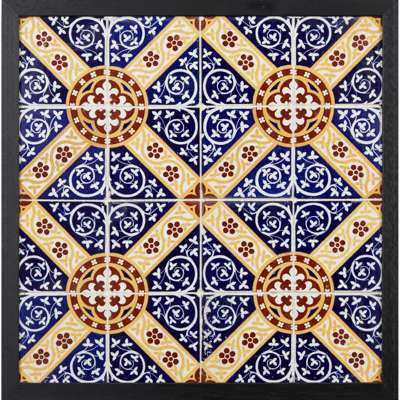
LOT 11
A.W.N. PUGIN (1812-1852) FOR MINTON & CO.
SIXTEEN-TILE PANEL, CIRCA 1860
SOLD FOR £425
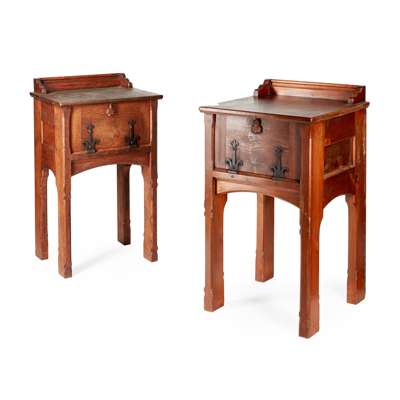
LOT 12
WILLIAM WHITE (1825–1900) FOR QUY HALL, CAMBRIDGESHIRE
NEAR PAIR OF GOTHIC REVIVAL BEDSIDE CABINETS, CIRCA 1860
SOLD FOR £1,375
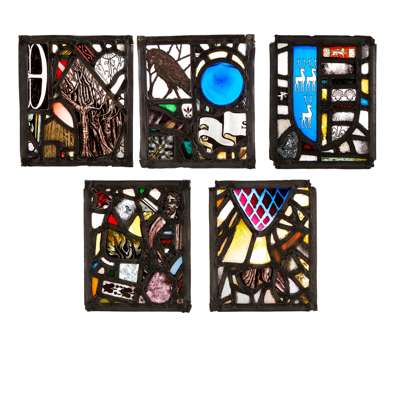
LOT 14
FLORENCE CAMM (1874 – 1960) AND CAMM STUDIOS, SMETHWICK
FIVE ARTS & CRAFTS STAINED GLASS PANELS, CIRCA 1928
SOLD FOR £750
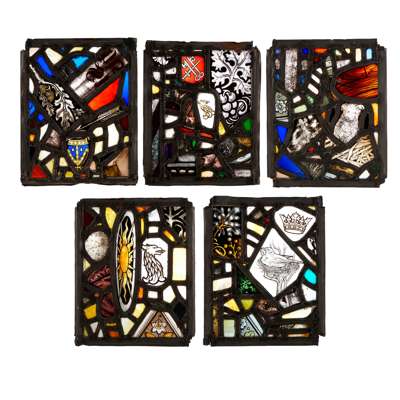
LOT 15
FLORENCE CAMM (1874 – 1960) AND CAMM STUDIOS, SMETHWICK
FIVE ARTS & CRAFTS STAINED GLASS PANELS, CIRCA 1928
SOLD FOR £625
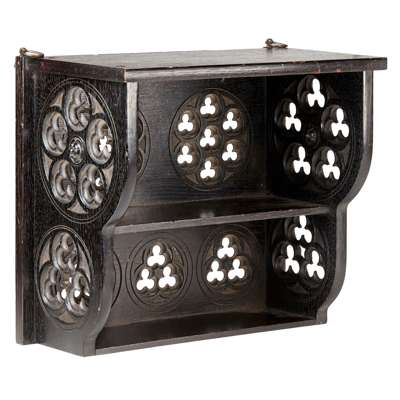
LOT 19
ENGLISH SCHOOL
SET OF GOTHIC REVIVAL OAK HANGING SHELVES, CIRCA 1880
SOLD FOR £275
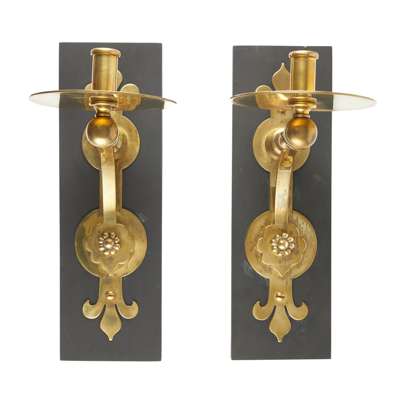
LOT 20
JOHN HARDMAN & CO., BIRMINGHAM
PAIR OF GOTHIC REVIVAL BRASS WALL SCONCES, CIRCA 1870
SOLD FOR £450
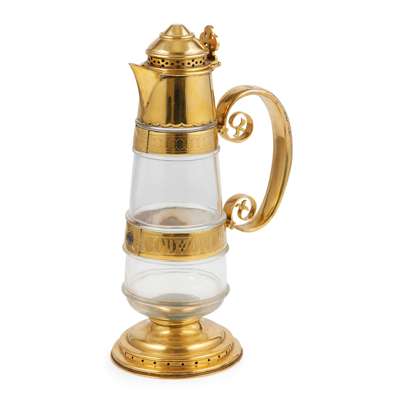
LOT 21
WILLIAM BUTTERFIELD (1814-1900)
GOTHIC REVIVAL GILTMETAL-MOUNTED LIDDED WINE JUG, CIRCA 1860
SOLD FOR £450
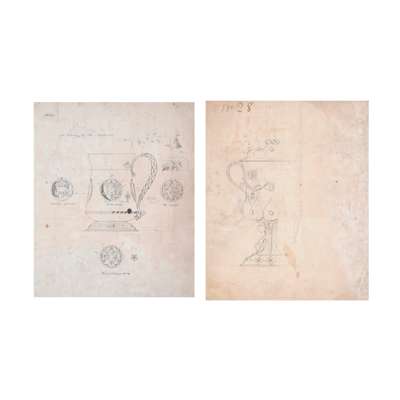
LOT 22
JOHN HARDMAN POWELL (1827-1895) FOR HARDMAN & CO.
ORIGINAL DRAWINGS FOR COVERED CUP AND A TANKARD
SOLD FOR £275
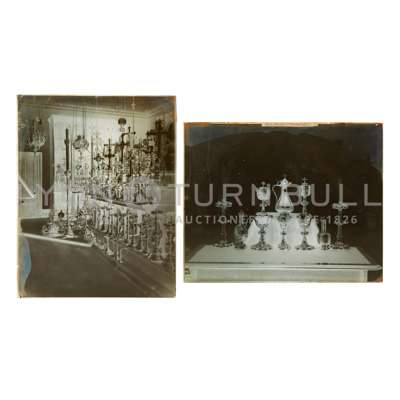
LOT 28
JOHN HARDMAN POWELL (1827-1895) INTEREST
TWO ORIGINAL PHOTOGRAPHIC PLATES OF THE HARMAN'S SHOWROOM, CIRCA 1880
SOLD FOR £325
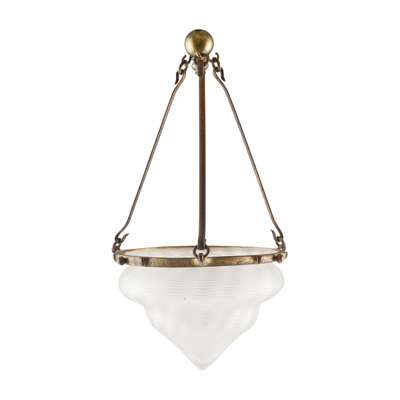
LOT 30
W.A.S. BENSON (1854-1924) AND JAMES POWELL & SONS
BRASS AND GLASS PENDANT LIGHT, CIRCA 1890
SOLD FOR £1,000
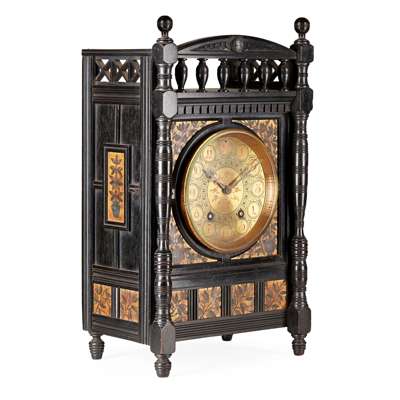
LOT 31
ENGLISH SCHOOL
AESTHETIC MOVEMENT EBONISED MANTEL CLOCK, CIRCA 1880
SOLD FOR £350
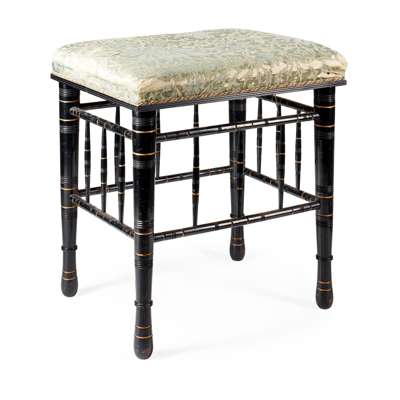
LOT 32
MANNER OF E.W. GODWIN
AESTHETIC MOVEMENT EBONISED STOOL, CIRCA 1880
SOLD FOR £550
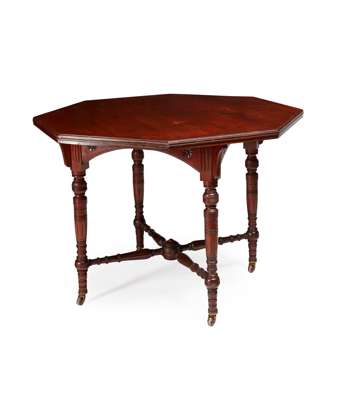
LOT 33
ENGLISH SCHOOL, MANNER OF E. W. GODWIN
AESTHETIC MOVEMENT WALNUT CENTRE TABLE, CIRCA 1880
SOLD FOR £938
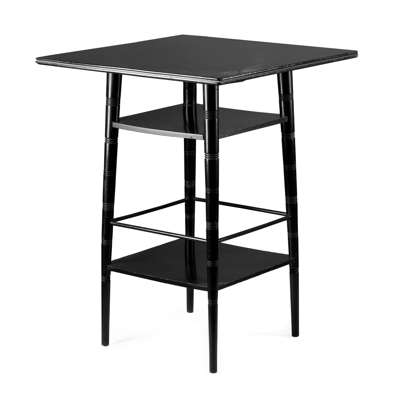
LOT 34
MANNER OF E. W. GODWIN
AESTHETIC MOVEMENT EBONISED OCCASIONAL TABLE, CIRCA 1880
SOLD FOR £938
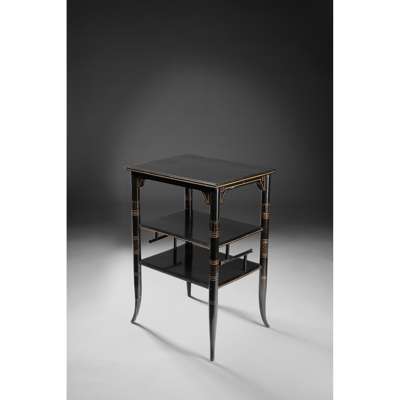
LOT 35
E. W. GODWIN (1833-1886), PROBABLY FOR GILLOW & CO.
AESTHETIC MOVEMENT ‘COFFEE TABLE’, CIRCA 1880
SOLD FOR £17,500
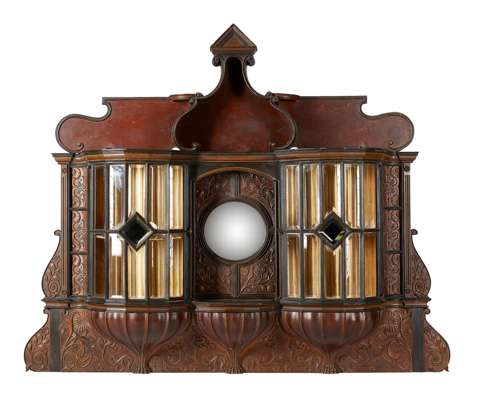
LOT 36
THE COALBOOKDALE COMPANY
AESTHETIC MOVEMENT CAST IRON OVERMANTEL MIRROR/ CABINET, CIRCA 1885
SOLD FOR £875
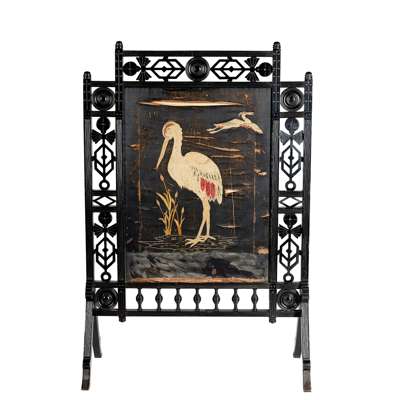
LOT 38
ENGLISH SCHOOL, ATTRIBUTED TO COX & SONS, LONDON
AESTHETIC MOVEMENT EBONISED FIRESCREEN, CIRCA 1880
SOLD FOR £375
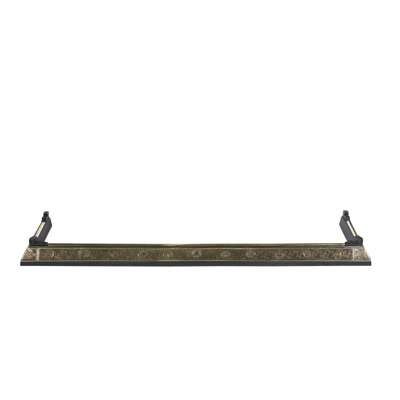
LOT 39
THOMAS JECKYLL (1827-1881) FOR BARNARD, BISHOP AND BARNARDS
AESTHETIC MOVEMENT BRASS AND CAST IRON FENDER, CIRCA 1880
SOLD FOR £688
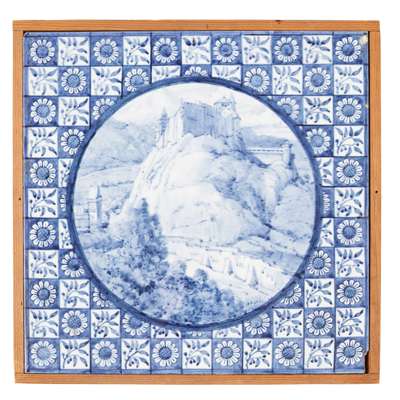
LOT 40
E.J. POYNTER (1836-1919) FOR MINTON'S ART POTTERY STUDIO
GLAZED TILE, CIRCA 1868
SOLD FOR £938
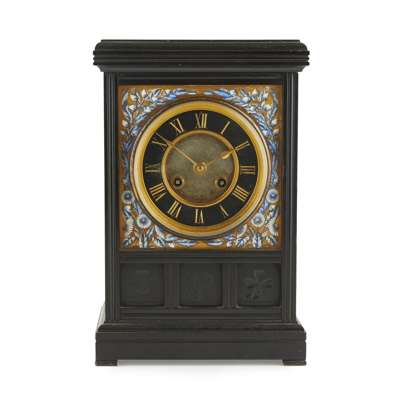
LOT 42
ENGLISH SCHOOL
AESTHETIC MOVEMENT SLATE MANTEL CLOCK, CIRCA 1890
SOLD FOR £400
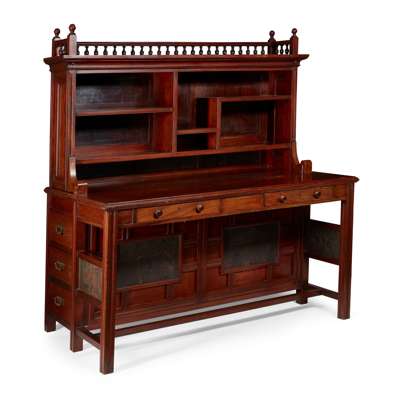
LOT 43
ENGLISH SCHOOL, MANNER OF THOMAS JECKYLL
ANGLO-JAPANESE MAHOGANY DESK, CIRCA 1880
SOLD FOR £2,375
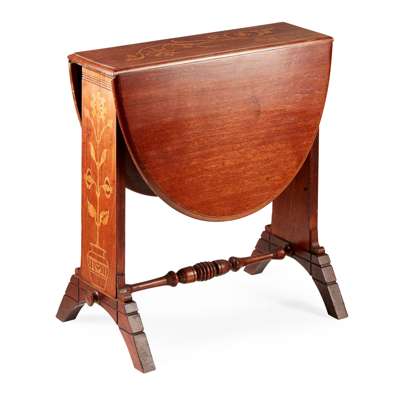
LOT 44
ATTRIBUTED TO THOMAS JECKYLL
AESTHETIC MOVEMENT DROP-LEAF OCCASIONAL TABLE, CIRCA 1900
SOLD FOR £675
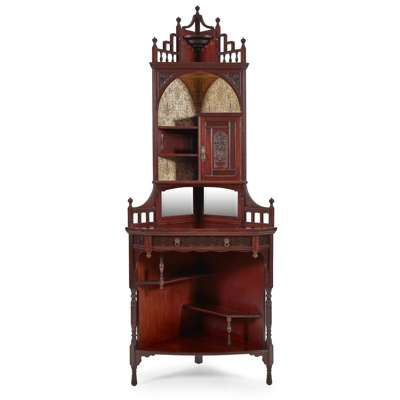
LOT 45
H. W. BATLEY (1846-1932) FOR GILLOW & CO., LANCASTER
AESTHETIC MOVEMENT MAHOGANY CORNER CABINET, CIRCA 1875
SOLD FOR £450
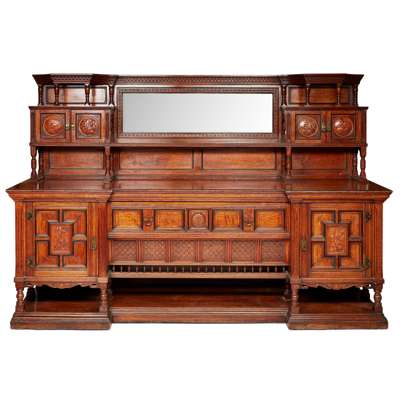
LOT 48
ENGLISH SCHOOL, MANNER OF BRUCE TALBERT
LARGE AESTHETIC MOVEMENT OAK SIDEBOARD, CIRCA 1880
SOLD FOR £2,750
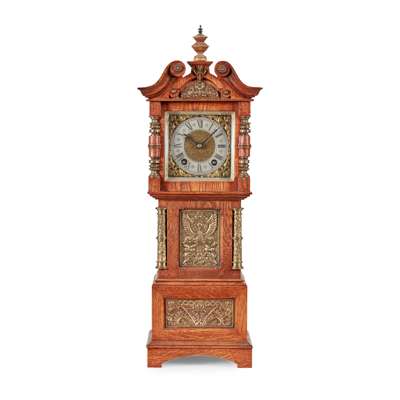
LOT 52
ENGLISH SCHOOL
AESTHETIC MOVEMENT OAK CASED MANTEL CLOCK, CIRCA 1880
SOLD FOR £500
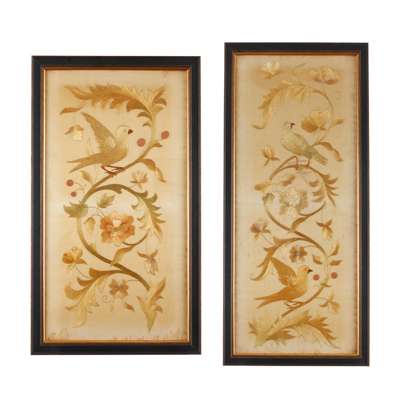
LOT 53
ENGLISH SCHOOL
TWO ARTS & CRAFTS EMBROIDERED PANELS, CIRCA 1900
SOLD FOR £350
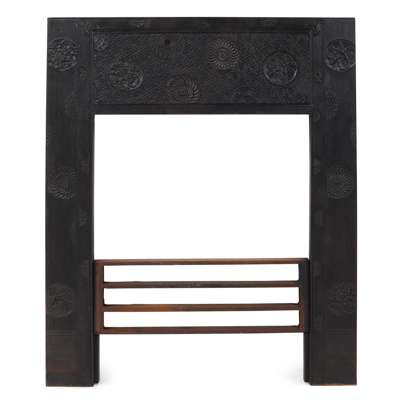
LOT 54
THOMAS JECKYLL (1827-1881) FOR BARNARD, BISHOP AND BARNARDS
AESTHETIC MOVEMENT CAST IRON FIRE INSERT, CIRCA 1880
SOLD FOR £575
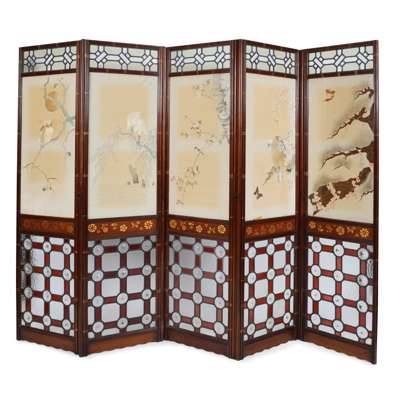
LOT 55
ENGLISH SCHOOL, MANNER OF E.W. GODWIN
AESTHETIC MOVEMENT FIVE-FOLD SCREEN, CIRCA 1885
SOLD FOR £3,250
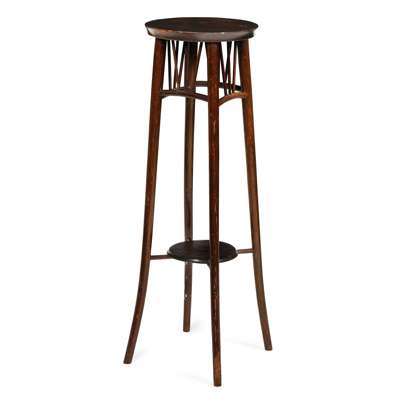
LOT 58
ENGLISH SCHOOL, AFTER E.W. GODWIN
AESTHETIC MOVEMENT STAINED BEECH JARDINIÈRE STAND, CIRCA 1880
SOLD FOR £425
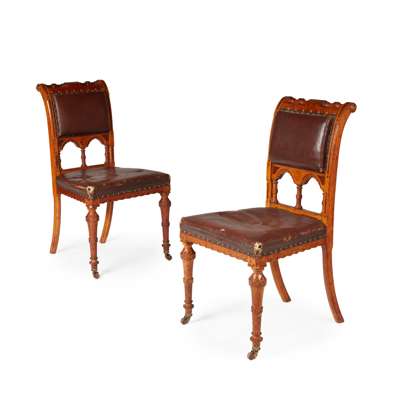
LOT 59
ENGLISH SCHOOL, MANNER OF CHARLES BEVAN
PAIR OF INLAID OAK SIDE CHAIRS, CIRCA 1870
SOLD FOR £300
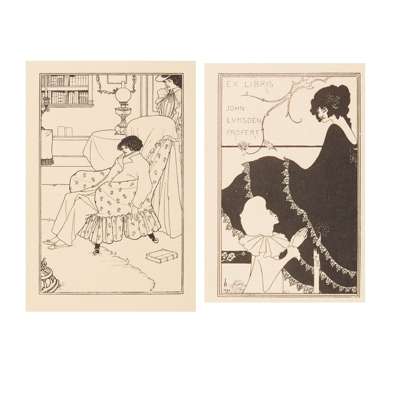
LOT 60
AUBREY BEARDSLEY (1872-1898)
TWO PRINTED BOOKPLATE DESIGNS, PROOF COPIES
SOLD FOR £625

LOT 62
S. GIBBS & MOORE, LONDON
RARE GROUP OF FOUR 6-INCH AESTHETIC MOVEMENT TILES, CIRCA 1880
SOLD FOR £1,000
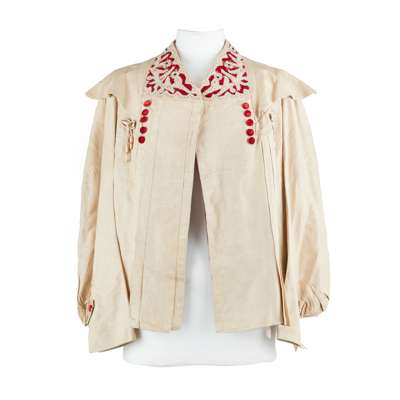
LOT 63
ARTISTIC DRESS: JAMES SHOOLBRED & CO., LONDON
EMBROIDERED LADIES JACKET, CIRCA 1900
SOLD FOR £525
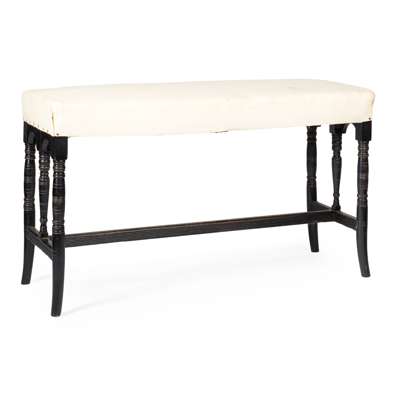
LOT 65
MANNER OF E. W. GODWIN
AESTHETIC MOVEMENT EBONISED CENTRE STOOL, CIRCA 1880
SOLD FOR £575
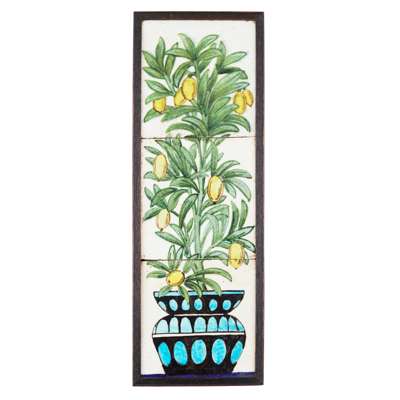
LOT 66
WILLIAM DE MORGAN (1839-1917)
'FRUIT TREE IN ORNAMENTAL POT' THREE-TILE PANEL, CIRCA 1875
SOLD FOR £1,875
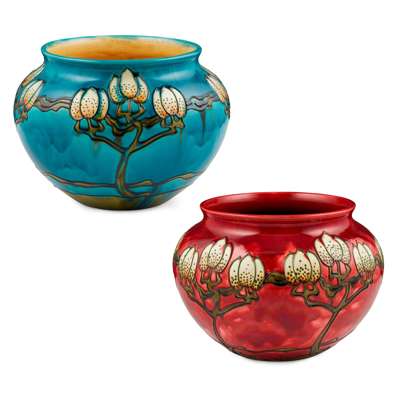
LOT 67
MINTON'S LTD
TWO SECESSIONIST JARDINIÈRES, CIRCA 1900
SOLD FOR £525
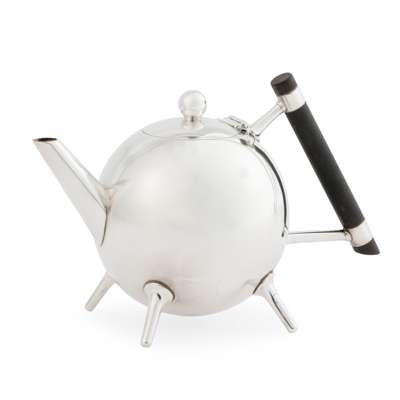
LOT 69
CHRISTOPHER DRESSER (1834-1904) FOR JAMES DIXON & SON, SHEFFIELD
ELECTROPLATED TEAPOT, 1880
SOLD FOR £12,500
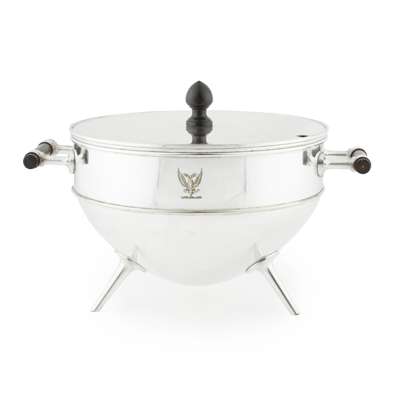
LOT 70
CHRISTOPHER DRESSER (1834-1904) FOR HUKIN & HEATH
ELECTROPLATED SOUP TUREEN AND COVER, CIRCA 1880
SOLD FOR £2,500
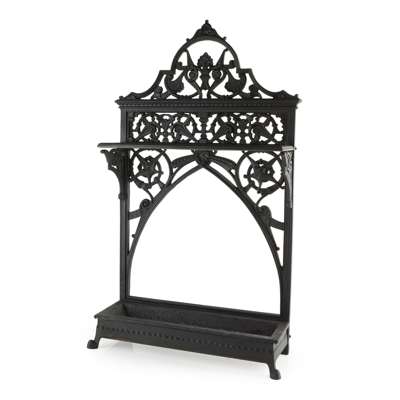
LOT 71
CHRISTOPHER DRESSER (1834-1904) FOR THE COALBROOKDALE COMPANY
CAST IRON UMBRELLA STAND, CIRCA 1875
SOLD FOR £1,063
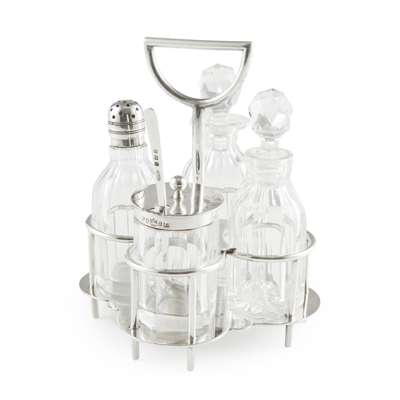
LOT 73
CHRISTOPHER DRESSER (1834-1904) FOR ELKINGTON & CO.
SILVER PLATE FOUR-PIECE CRUET SET, CIRCA 1880
SOLD FOR £525
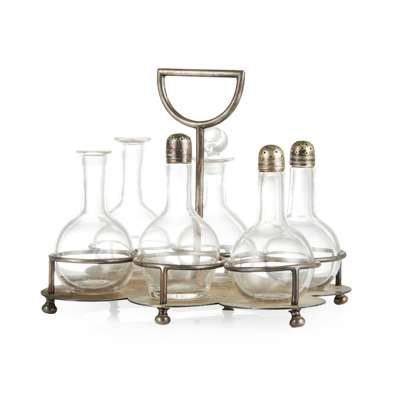
LOT 75
ATTRIBUTED TO CHRISTOPHER DRESSER FOR HUKIN & HEATH
SILVER PLATE CRUET STAND, CIRCA 1880
SOLD FOR £325
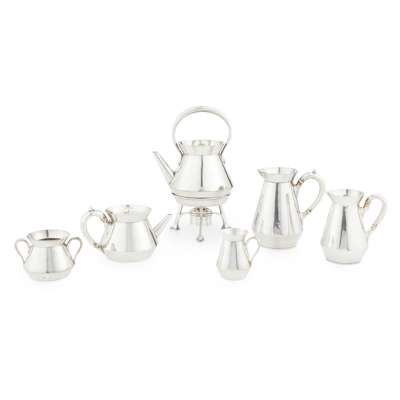
LOT 76
ATTRIBUTED TO CHRISTOPHER DRESSER FOR RICHARD HODD & SONS, LONDON
AESTHETIC MOVEMENT SIX-PIECE SILVER PLATE TEA SERVICE, CIRCA 1878
SOLD FOR £300
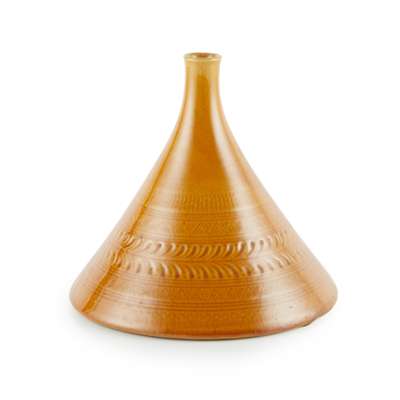
LOT 78
CHRISTOPHER DRESSER (1834-1904) FOR LINTHORPE ART POTTERY
TAPERED VASE, CIRCA 1880
SOLD FOR £1,250
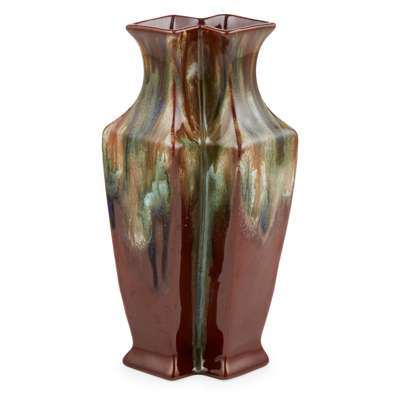
LOT 79
CHRISTOPHER DRESSER (1834-1904) FOR LINTHORPE ART POTTERY
GLAZED CERAMIC VASE, CIRCA 1880
SOLD FOR £525
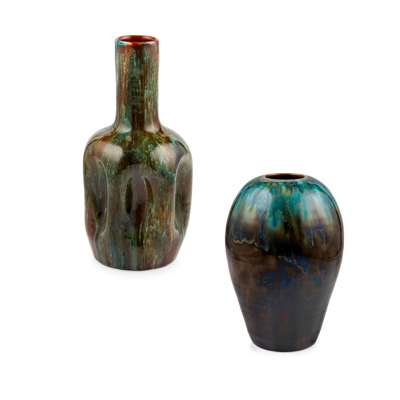
LOT 80
CHRISTOPHER DRESSER (1834-1904) FOR LINTHORPE ART POTTERY
EARTHENWARE DIMPLE VASE, CIRCA 1880
SOLD FOR £450
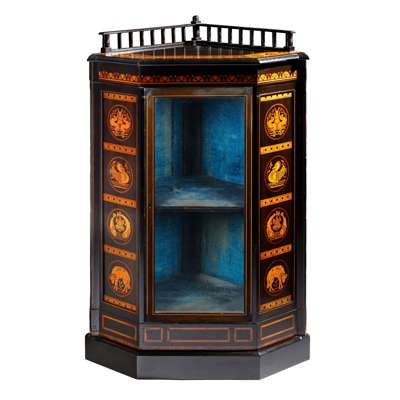
LOT 83
ATTRIBUTED TO CHRISTOPHER DRESSER OR JOHN MOYR SMITH, POSSIBLY FOR COX & SONS, LONDON
AESTHETIC MOVEMENT EBONISED AND INLAID CORNER CABINET, CIRCA 1875
SOLD FOR £4,500
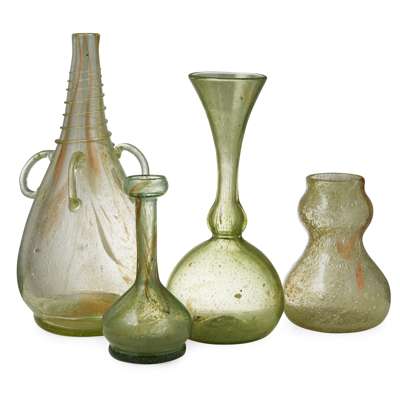
LOT 84
CHRISTOPHER DRESSER (1834-1904) AND GEORGE WALTON (1867-1933) FOR JAMES COUPER AND SONS, GLASGOW
GROUP OF FOUR 'CLUTHA' GLASS VESSELS, CIRCA 1890
SOLD FOR £2,500
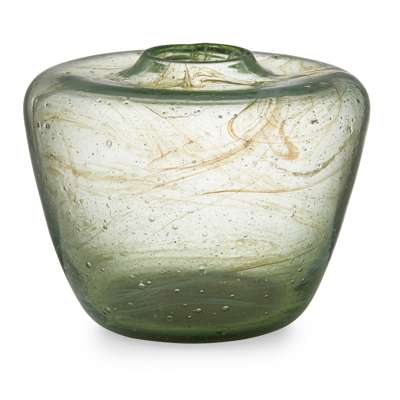
LOT 85
GEORGE WALTON (1867-1933) FOR JAMES COUPER AND SONS, GLASGOW
'CLUTHA' GLASS VASE, CIRCA 1900
SOLD FOR £688
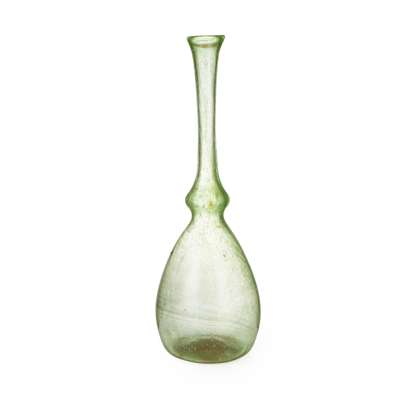
LOT 86
CHRISTOPHER DRESSER (1834-1904) FOR JAMES COUPER & SONS, GLASGOW
'CLUTHA' GLASS VASE, CIRCA 1890
SOLD FOR £1,188
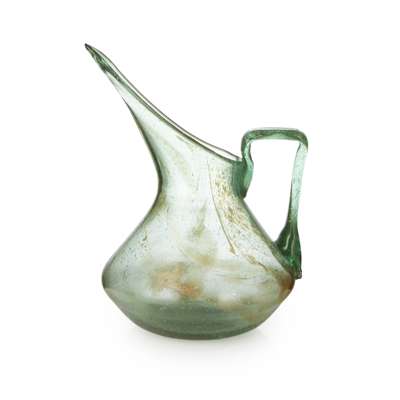
LOT 87
CHRISTOPHER DRESSER (1834-1904) FOR JAMES COUPER & SONS, GLASGOW
'CLUTHA' GLASS PITCHER, CIRCA 1890
SOLD FOR £2,750
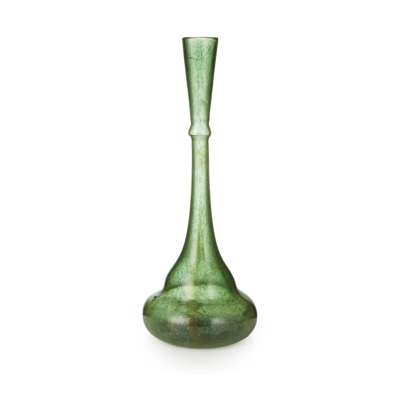
LOT 88
CHRISTOPHER DRESSER (1834-1904) FOR JAMES COUPER & SONS, GLASGOW
TALL 'CLUTHA' GLASS VASE, CIRCA 1890
SOLD FOR £938
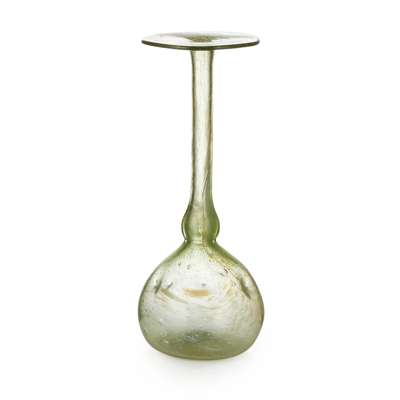
LOT 89
CHRISTOPHER DRESSER (1834-1904) JAMES COUPER & SONS, GLASGOW
'CLUTHA' GLASS VASE, CIRCA 1890
SOLD FOR £1,125
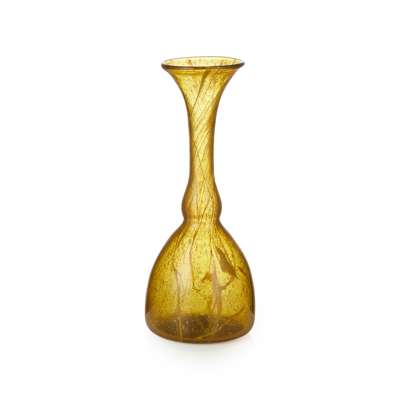
LOT 90
CHRISTOPHER DRESSER (1834-1904) JAMES COUPER & SONS, GLASGOW
'CLUTHA' GLASS VASE, CIRCA 1890
SOLD FOR £875
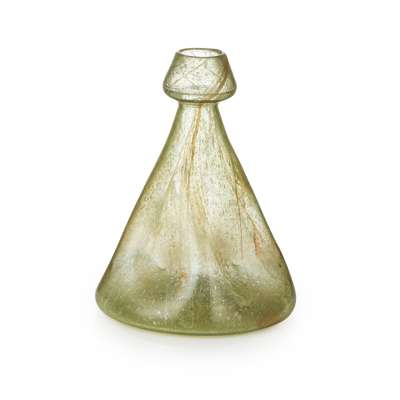
LOT 91
CHRISTOPHER DRESSER (1834-1904) JAMES COUPER & SONS, GLASGOW
'CLUTHA' GLASS VASE, CIRCA 1890
SOLD FOR £1,625
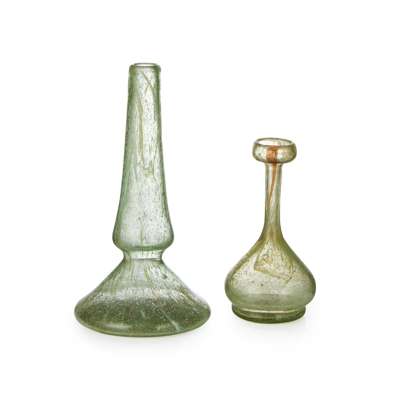
LOT 92
CHRISTOPHER DRESSER (1834-1904) FOR JAMES COUPER & SONS, GLASGOW
'CLUTHA' GLASS VASE, CIRCA 1890
SOLD FOR £813
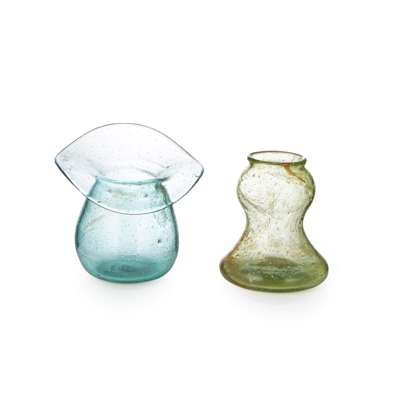
LOT 93
CHRISTOPHER DRESSER (1834-1904) FOR JAMES COUPER & SONS, GLASGOW
'CLUTHA' GLASS VASE, CIRCA 1890
SOLD FOR £688
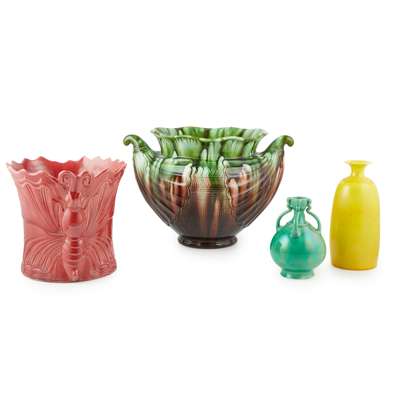
LOT 94
CHRISTOPHER DRESSER (1834-1904) FOR LINTHORPE ART POTTERY
TWIN-HANDLED JARDINIÈRE, CIRCA 1895
SOLD FOR £300
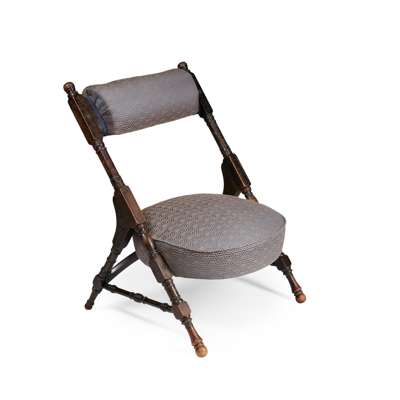
LOT 96
ENGLISH SCHOOL, MANNER OF CHRISTOPHER DRESSER
AESTHETIC MOVEMENT EBONISED LOW CHAIR, CIRCA 1880
SOLD FOR £275
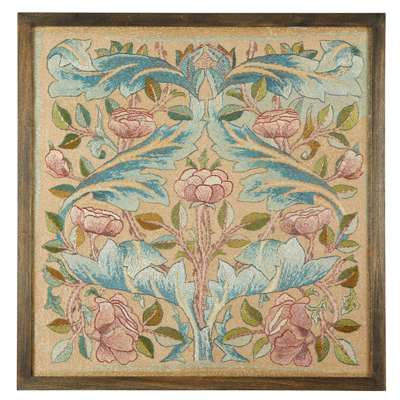
LOT 97
MAY MORRIS (1862-1938) FOR MORRIS & CO.
'ROSE BUSH' ARTS & CRAFTS EMBROIDERED PANEL, CIRCA 1900
SOLD FOR £525
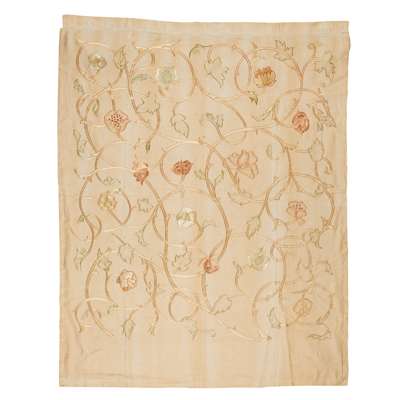
LOT 100
ATTRIBUTED TO MAY MORRIS FOR MORRIS & CO.
ARTS & CRAFTS EMBROIDERED PANEL, CIRCA 1900
SOLD FOR £575
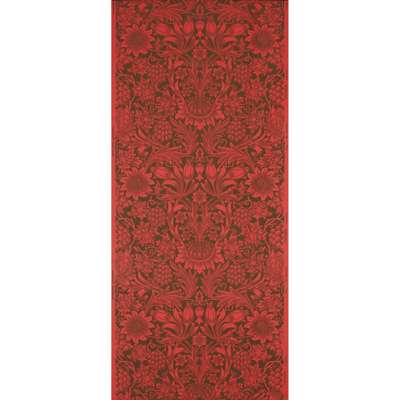
LOT 102
WILLIAM MORRIS (1834-1896) FOR MORRIS & CO.
'SUNFLOWER' FRAMED WALLPAPER PANEL, 1879
SOLD FOR £325
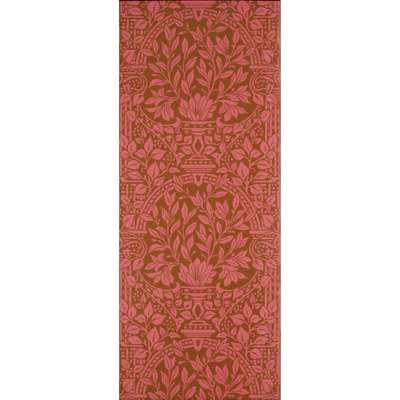
LOT 103
W.A.S. BENSON (1854-1924) FOR MORRIS & CO.
'GARDEN CRAFT' WALLPAPER PANEL, CIRCA 1908
SOLD FOR £813
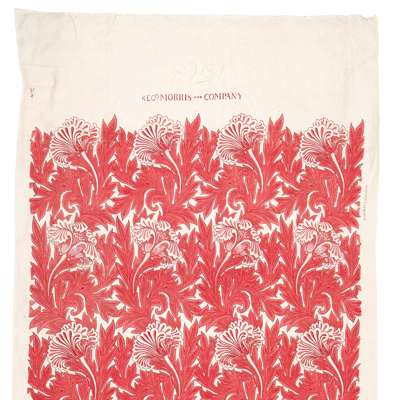
LOT 104
WILLIAM MORRIS (1834-1896) FOR MORRIS & CO.
TWO PANELS OF ORIGINAL 'TULIP' FABRIC, REGISTERED 1875
SOLD FOR £4,000
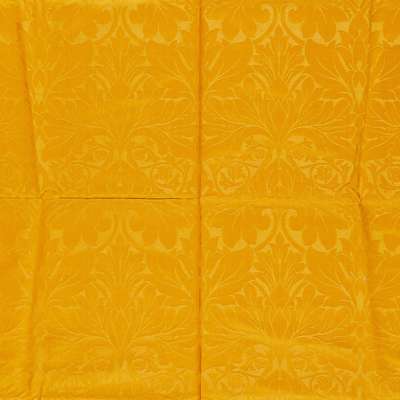
LOT 105
WILLIAM MORRIS (1834-1896) FOR MORRIS & CO.
TWO PANELS OF ORIGINAL 'ACANTHUS' DAMASK FABRIC, REGISTERED 1879
SOLD FOR £750
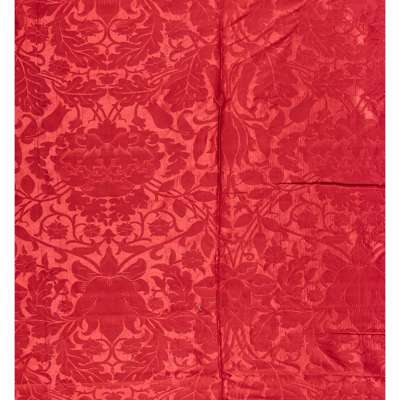
LOT 106
WILLIAM MORRIS (1834-1896) FOR MORRIS & CO.
FIVE PANELS OF ORIGINAL 'OAK' FABRIC, REGISTERED 1881
SOLD FOR £2,125
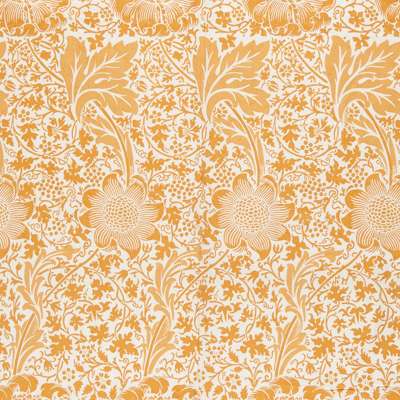
LOT 107
WILLIAM MORRIS (1834-1896) FOR MORRIS & CO.
TWO PANELS OF ORIGINAL 'BIRD & ANEMONE' FABRIC, REGISTERED 1875
SOLD FOR £3,750
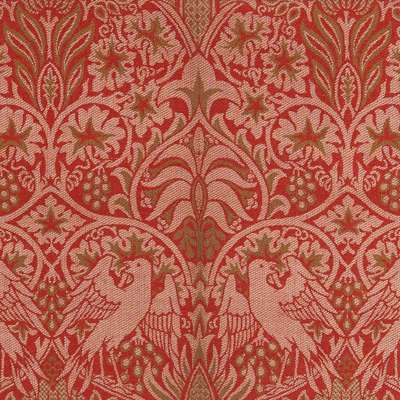
LOT 108
WILLIAM MORRIS (1834-1896) FOR MORRIS & CO.
FOUR PANELS OF ORIGINAL 'BIRD & VINE' FABRIC, REGISTERED 1879
SOLD FOR £4,000
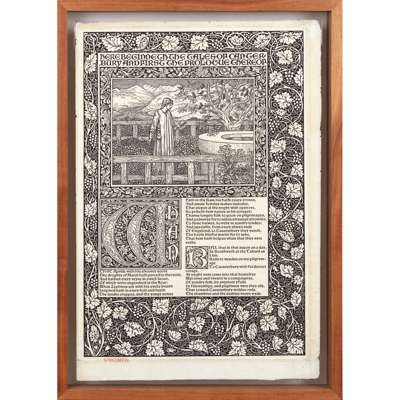
LOT 110
WILLIAM MORRIS (1834-1896) AND EDWARD COLEY BURNE-JONES (1833-1898) FOR KELMSCOTT PRESS
FRAMED SPECIMEN PAGE FOR THE KELMSCOTT CHAUCER, 1896
SOLD FOR £1,500
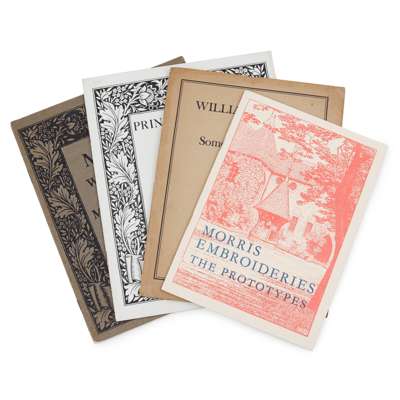
LOT 111
MORRIS AND CO.
GROUP OF FOUR PUBLICATIONS
SOLD FOR £525
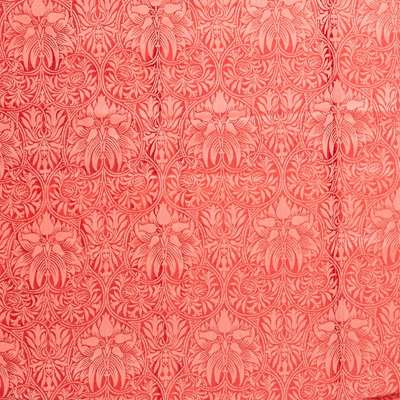
LOT 112
WILLIAM MORRIS (1834-1896) FOR MORRIS & CO.
TWO PANELS OF ORIGINAL 'ACANTHUS' DAMASK FABRIC, REGISTERED 1879
SOLD FOR £4,250
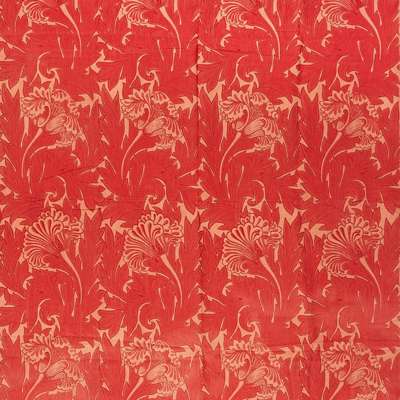
LOT 113
WILLIAM MORRIS (1834-1896) FOR MORRIS & CO.
FOUR PANELS OF ORIGINAL 'TULIP' FABRIC, REGISTERED 1875
SOLD FOR £2,000
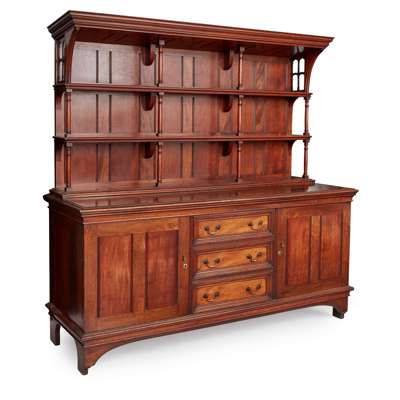
LOT 114
PHILIP SPEAKMAN WEBB (1831-1915) FOR MORRIS & CO
ARTS & CRAFTS MAHOGANY SIDEBOARD, CIRCA 1900
SOLD FOR £2,500
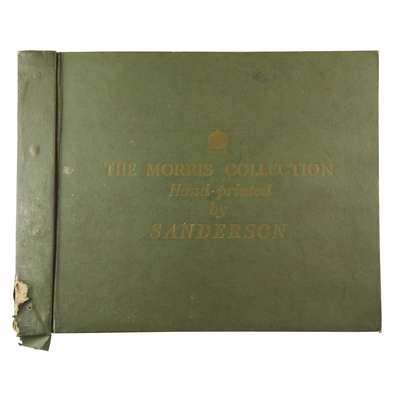
LOT 115
SANDERSON & SONS, LTD
'THE MORRIS COLLECTION', EARLY WALLPAPER SAMPLE BOOK, 1950S
SOLD FOR £400

LOT 116
ENGLISH SCHOOL
ARTS & CRAFTS 'MORRIS' STYLE ARMCHAIR, CIRCA 1900
SOLD FOR £625
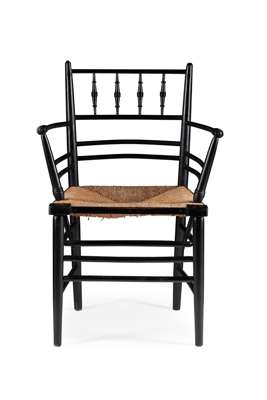
LOT 117
PHILIP SPEAKMAN WEBB (1831-1915) FOR MORRIS & CO
EBONISED 'SUSSEX' CHAIR CIRCA 1880
SOLD FOR £688
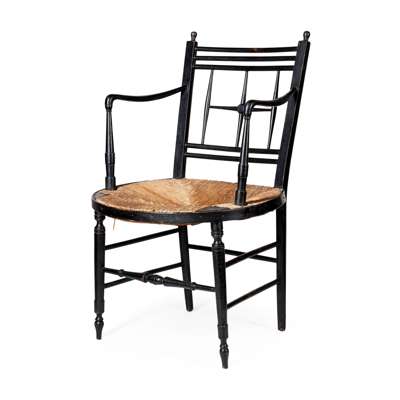
LOT 118
ATTRIBUTED TO FORD MADDOX BROWN FOR MORRIS & CO.
ARTS & CRAFTS EBONISED ARMCHAIR, CIRCA 1880
SOLD FOR £475
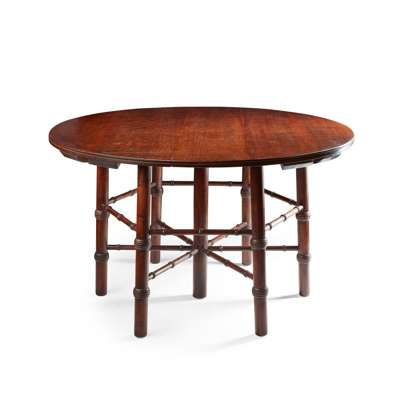
LOT 122
PHILIP SPEAKMAN WEBB (1831-1915) FOR MORRIS & CO.
ARTS & CRAFTS OAK CENTRE TABLE, CIRCA 1880
SOLD FOR £13,750
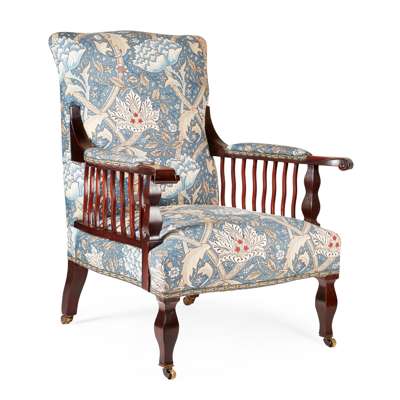
LOT 123
GEORGE WASHINGTON JACK (1855-1931) FOR MORRIS & CO.
ARTS & CRAFTS MAHOGANY-FRAMED 'SAVILLE' ARMCHAIR, CIRCA 1890
SOLD FOR £2,500
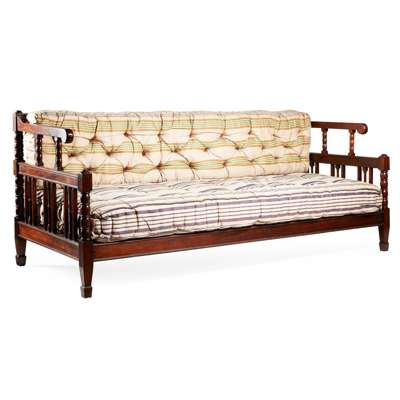
LOT 124
ENGLISH SCHOOL, MANNER OF PHILIP SPEAKMAN WEBB
ARTS & CRAFTS MAHOGANY DAY BED, CIRCA 1900
SOLD FOR £2,250
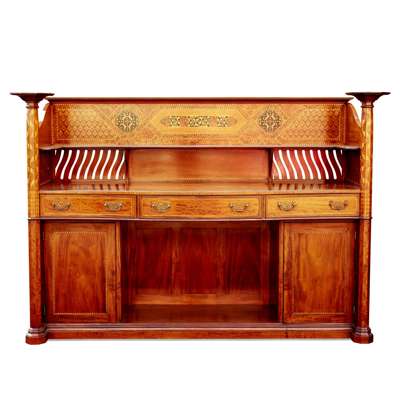
LOT 125
GEORGE WASHINGTON JACK (1855-1931) FOR MORRIS & CO.
ARTS & CRAFTS INLAID MAHOGANY SIDEBOARD, CIRCA 1887
SOLD FOR £11,875
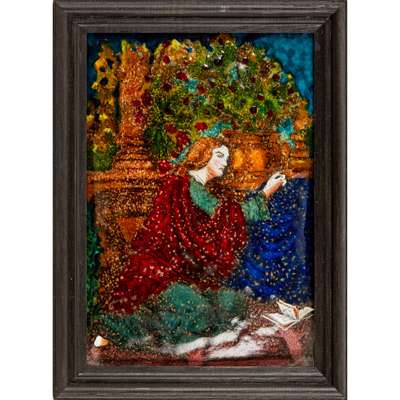
LOT 126
ENGLISH SCHOOL, AFTER WILLIAM HOLMAN HUNT
ARTS & CRAFTS FRAMED ENAMEL PLAQUE
SOLD FOR £350
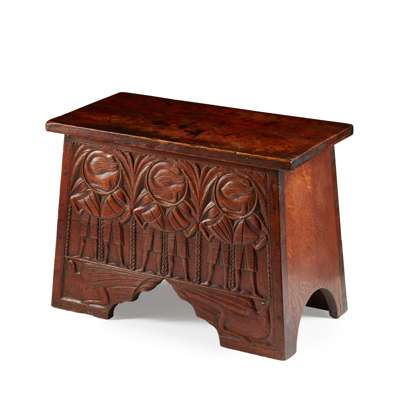
LOT 127
ENGLISH SCHOOL
ARTS & CRAFTS COFFER, CIRCA 1910
SOLD FOR £875
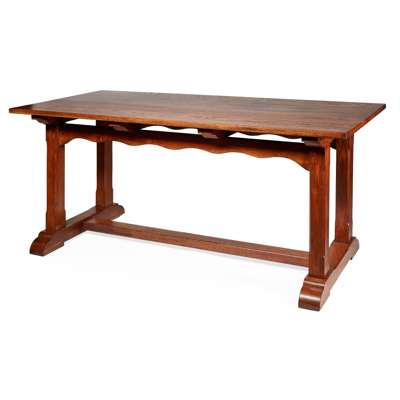
LOT 128
ENGLISH SCHOOL, MANNER OF WILLIAM LETHABY
ARTS & CRAFTS OAK CENTRE TABLE, CIRCA 1900
SOLD FOR £1,125
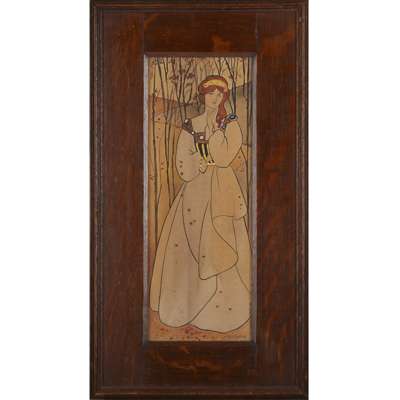
LOT 129
ENGLISH SCHOOL
‘AUTUMN’
SOLD FOR £400
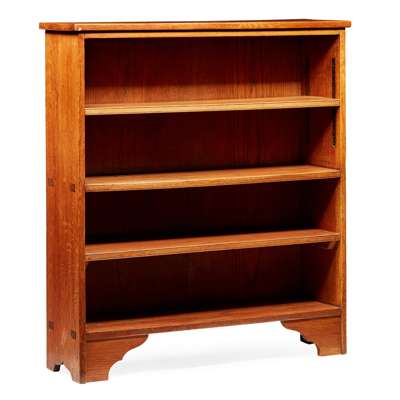
LOT 131
ENGLISH SCHOOL
ARTS & CRAFTS OAK OPEN BOOKCASE, CIRCA 1900
SOLD FOR £500
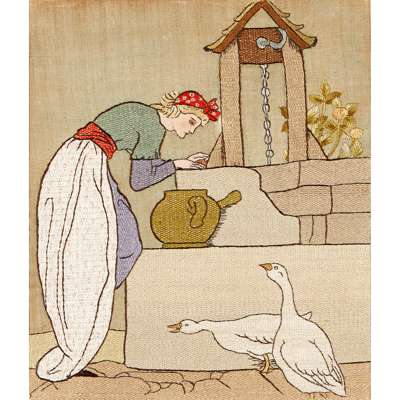
LOT 133
ATTRIBUTED TO JOHN HASSALL
ARTS & CRAFTS EMBROIDERED PANEL, CIRCA 1900
SOLD FOR £425
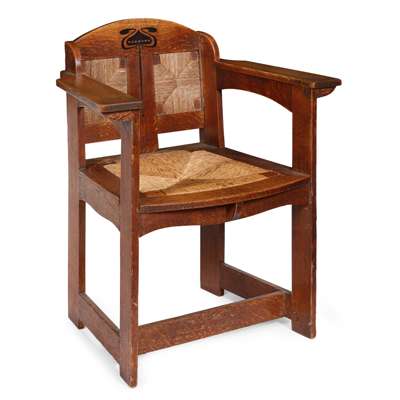
LOT 134
E.G. PUNNETT FOR WILLIAM BIRCH, HIGH WYCOMBE
ARTS & CRAFTS ARMCHAIR, CIRCA 1901
SOLD FOR £1,750
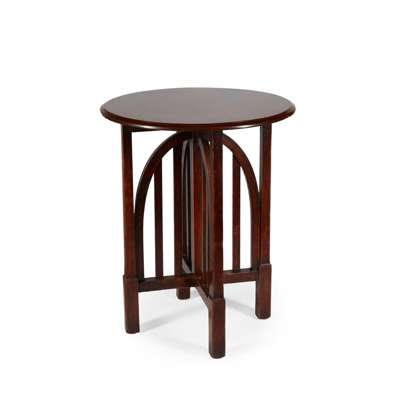
LOT 135
ENGLISH SCHOOL
ARTS & CRAFTS OAK LAMP TABLE, CIRCA 1910
SOLD FOR £425
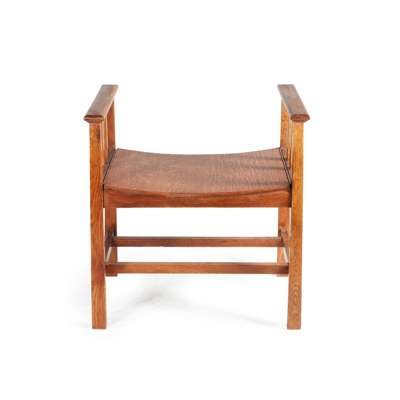
LOT 136
WYLIE & LOCHHEAD, GLASGOW
ARTS & CRAFTS OAK STOOL, CIRCA 1920
SOLD FOR £375
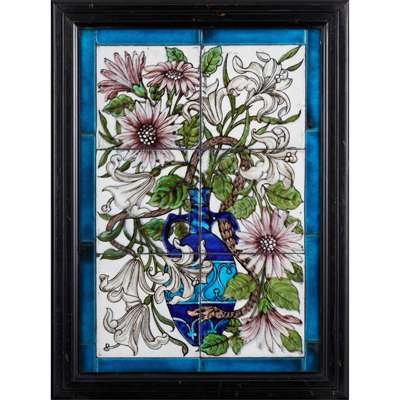
LOT 137
WILLIAM DE MORGAN (1839-1917)
ARTS & CRAFTS SIX-TILE PANEL, CIRCA 1880
SOLD FOR £5,000
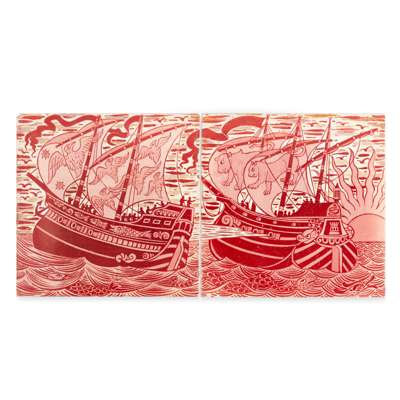
LOT 138
WILLIAM DE MORGAN (1839-1917)
PAIR OF RUBY LUSTRE 8 INCH TILES, CIRCA 1890
SOLD FOR £6,000
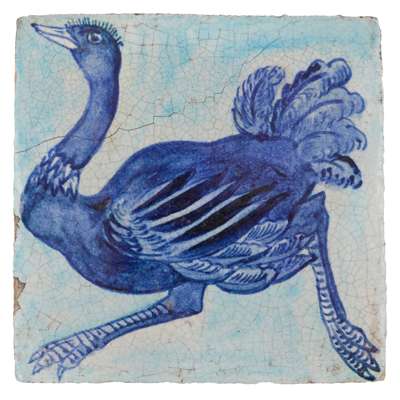
LOT 139
WILLIAM DE MORGAN (1839-1917)
ARTS & CRAFTS CHELSEA PERIOD TILE, CIRCA 1875
SOLD FOR £4,250
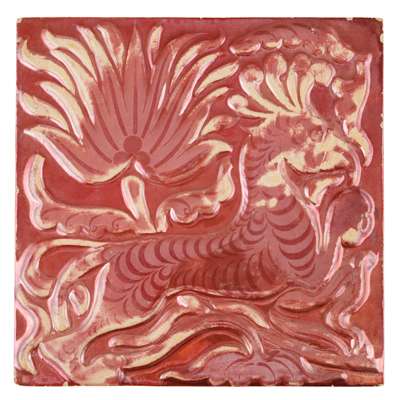
LOT 140
ATTRIBUTED TO HASLEY RICARDO FOR WILLIAM DE MORGAN
ARTS & CRAFTS 9-INCH RUBY LUSTRE RELIEF TILE, CIRCA 1890
SOLD FOR £450
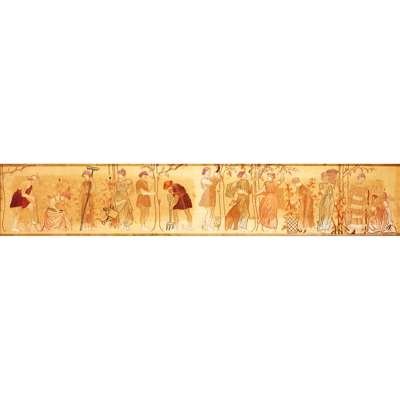
LOT 145
ENGLISH SCHOOL, MANNER OF WALTER CRANE
ARTS & CRAFTS EMBROIDERED PANEL, CIRCA 1880
SOLD FOR £400
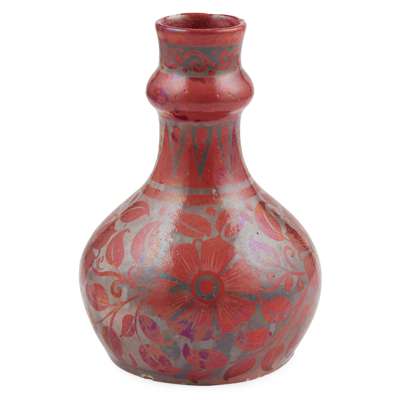
LOT 148
WILLIAM DE MORGAN (1839-1917)
ARTS & CRAFTS RUBY LUSTRE VASE, CIRCA 1890
SOLD FOR £400
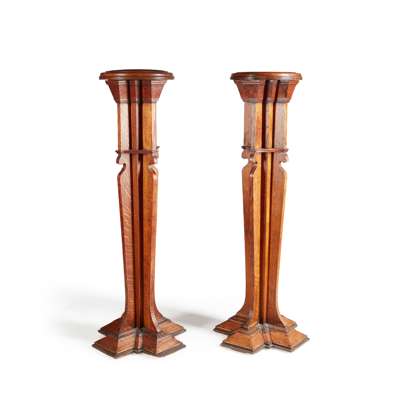
LOT 149
ENGLISH SCHOOL
PAIR OF ARTS & CRAFTS OAK TORCHÈRE STANDS, CIRCA 1900
SOLD FOR £500
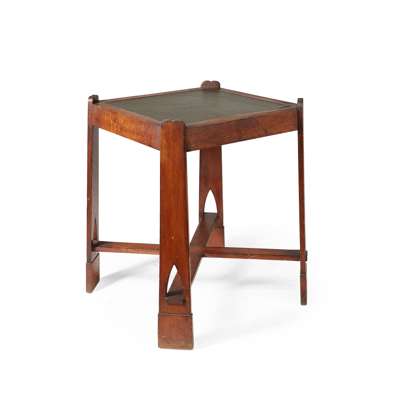
LOT 150
ENGLISH SCHOOL
ARTS & CRAFTS OAK CENTRE TABLE, CIRCA 1900
SOLD FOR £750

LOT 152
A. E. JONES (1878-1954)
ARTS & CRAFTS CASKET, CIRCA 1900
SOLD FOR £450

LOT 153
MANNER OF HEAL & SON, LONDON
ARTS & CRAFTS TUB ARMCHAIR, CIRCA 1920
SOLD FOR £425
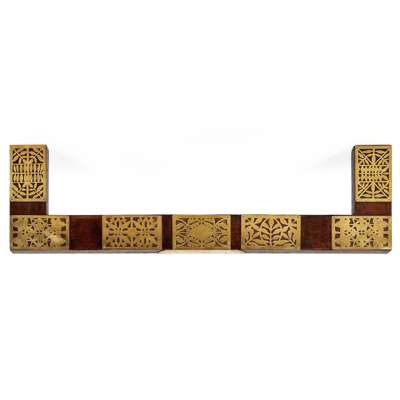
LOT 154
ENGLISH SCHOOL
ARTS & CRAFTS OAK FENDER, CIRCA 1900
SOLD FOR £425
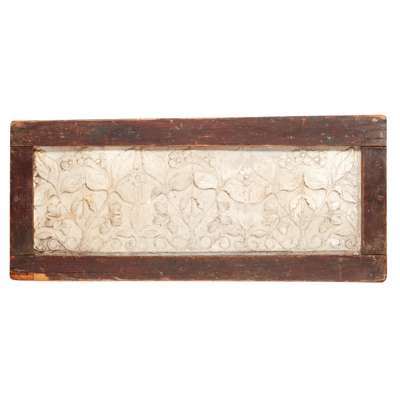
LOT 156
MANNER OF ERNEST GIMSON
ARTS & CRAFTS PLASTER SAMPLE PANEL, CIRCA 1890
SOLD FOR £325

LOT 157
EDWARD SPENCER (1873-1938) FOR THE ARTIFICERS’ GUILD
ARTS & CRAFTS SILVER BON BON DISH, LONDON, 1927
SOLD FOR £350
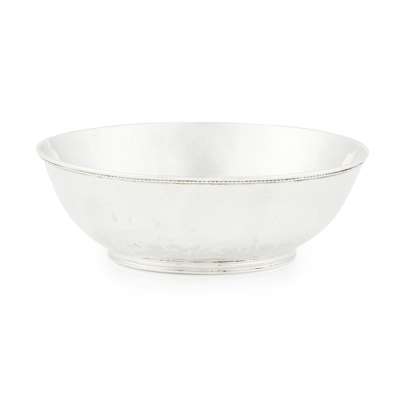
LOT 159
JOHN PAUL COOPER (1860-1933)
ARTS & CRAFTS SILVER BON BON DISH, LONDON, 1913
SOLD FOR £500
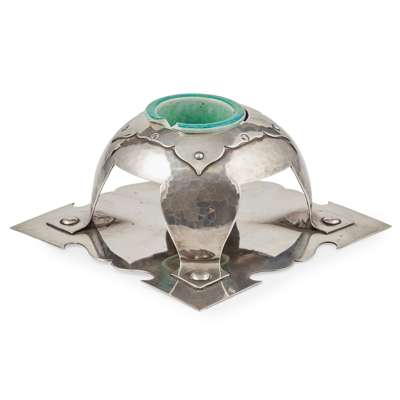
LOT 160
BIRMINGHAM GUILD OF HANDICRAFT
ARTS & CRAFTS SILVER INKWELL, BIRMINGHAM 1900
SOLD FOR £813
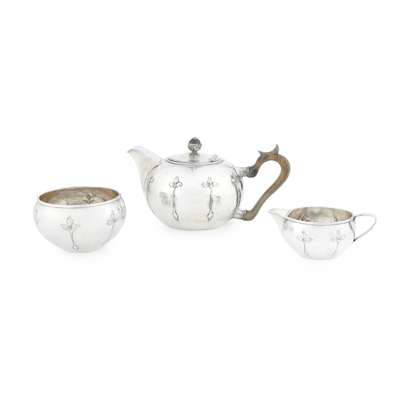
LOT 162
FRANCIS JOSEPH COMBE JORDAN, BIRMINGHAM
ARTS & CRAFTS THREE-PIECE SILVER TEA SERVICE, BIRMINGHAM 1930
SOLD FOR £300
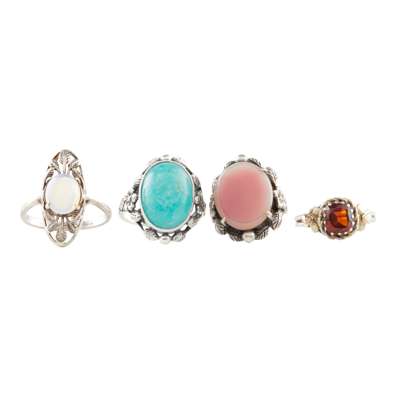
LOT 163
ATTRIBUTED TO BERNARD INSTONE
THREE RINGS, EARLY 20TH CENTURY
SOLD FOR £475
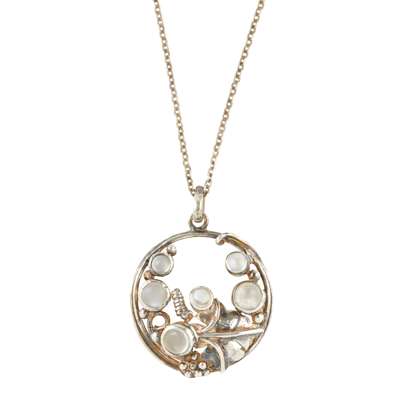
LOT 164
DORRIE NOSSITER (1893-1977)
ARTS & CRAFTS WHITE METAL AND MOONSTONE SET PENDANT, CIRCA 1910
SOLD FOR £475
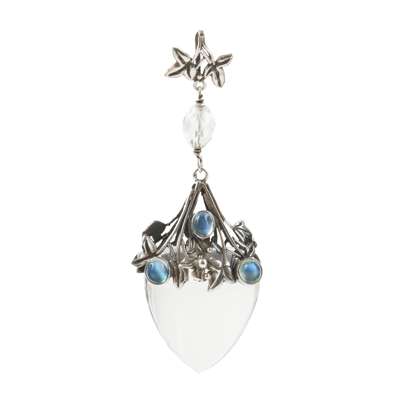
LOT 166
ATTRIBUTED TO AMY SANDHEIM
WHITE METAL AND GEM SET PENDANT, CIRCA 1910
SOLD FOR £500
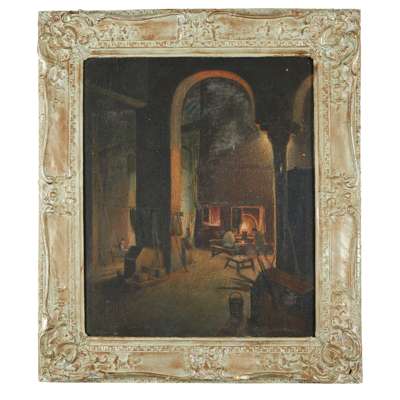
LOT 170
ENGLISH SCHOOL
INTERIOR OF WHITEFRIARS GLASSWORKS, TUDOR STREET, LONDON
SOLD FOR £400
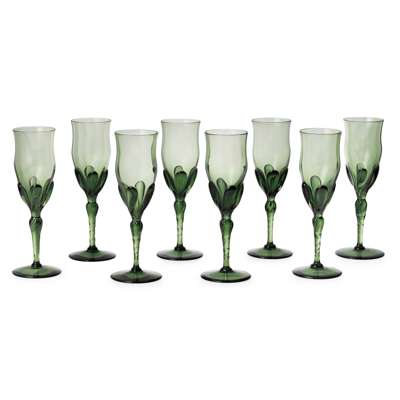
LOT 171
ATTRIBUTED TO T. G. JACKSON (1835 - 1924) FOR JAMES POWELL & SONS, WHITEFRIARS
SET OF EIGHT ART NOUVEAU GREEN GLASS FLUTES, CIRCA 1875
SOLD FOR £550
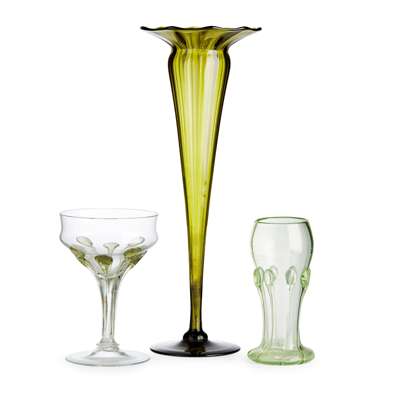
LOT 172
JAMES POWELL & SONS, LONDON
TALL OLIVE GLASS VESSEL, CIRCA 1880
SOLD FOR £375
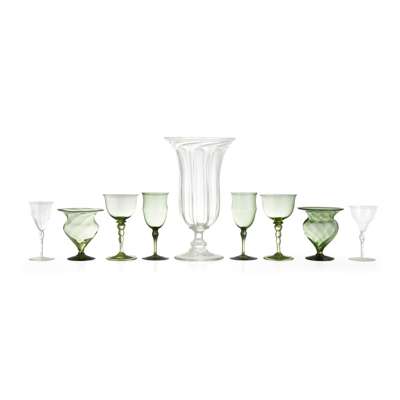
LOT 173
ARTS & CRAFTS
GROUP OF GLASSWARE, CIRCA 1900
SOLD FOR £813
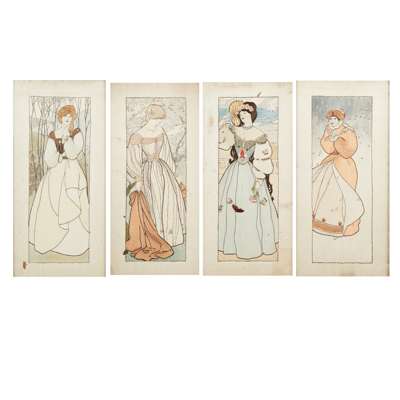
LOT 174
ENGLISH SCHOOL
'THE FOUR SEASONS', SET OF FOUR ARTS & CRAFTS EMBROIDERED PANELS, CIRCA 1900
SOLD FOR £475
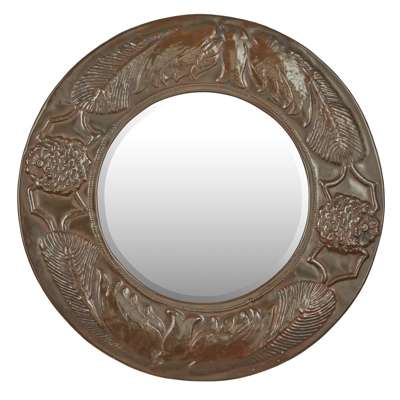
LOT 175
MANNER OF JOHN PEARSON
ARTS & CRAFTS COPPER MIRROR, CIRCA 1910
SOLD FOR £375
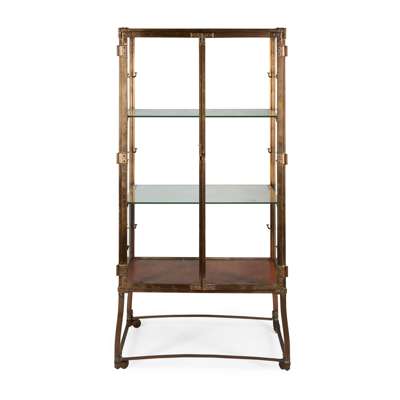
LOT 176
ENGLISH SCHOOL
EDWARDIAN BRASS FRAMED DISPLAY CASE, CIRCA 1900
SOLD FOR £2,750
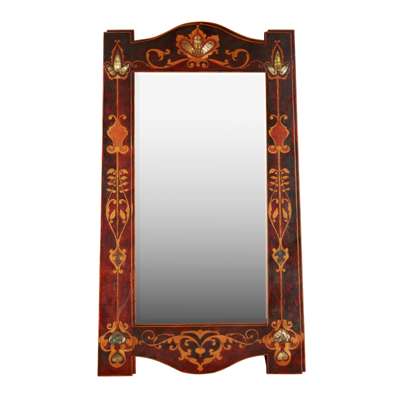
LOT 176A
EDWARDIAN PAINTED OAK MIRROR
CIRCA 1910
SOLD FOR £275
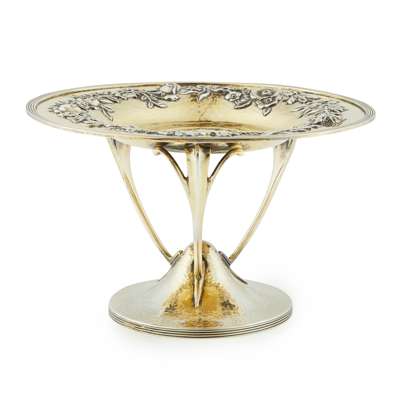
LOT 177
PHILIP HANSON ABBOT
ARTS & CRAFTS SILVER-GILT CENTREPIECE TAZZA, LONDON, 1909
SOLD FOR £575
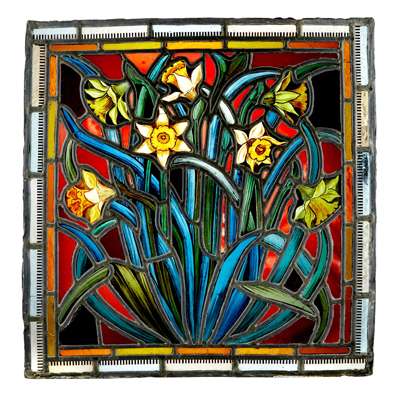
LOT 179
ENGLISH SCHOOL
STAINED & LEADED GLASS PANEL, CIRCA 1900
SOLD FOR £875
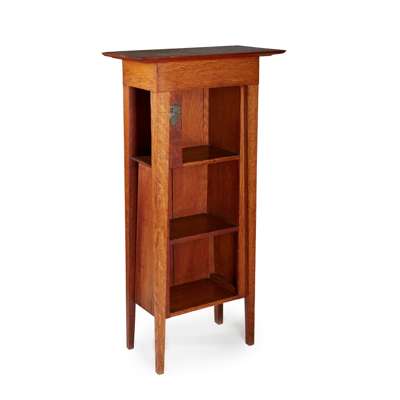
LOT 180
ENGLISH SCHOOL
ARTS & CRAFTS 'CAMBRIDGE UNIVERSITY' OAK BOOKCASE, CIRCA 1910
SOLD FOR £1,500
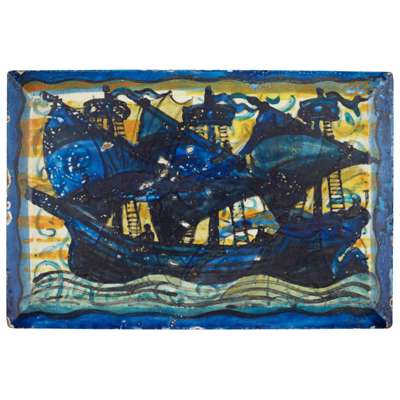
LOT 181
JOHN PEARSON (1859-1930)
ARTS & CRAFTS PAINTED CERAMIC TILE, CIRCA 1900
SOLD FOR £300
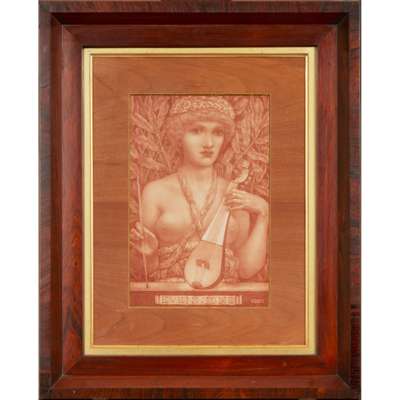
LOT 182
HENRY RYLAND (1856-1924)
EVEN SONG
SOLD FOR £400
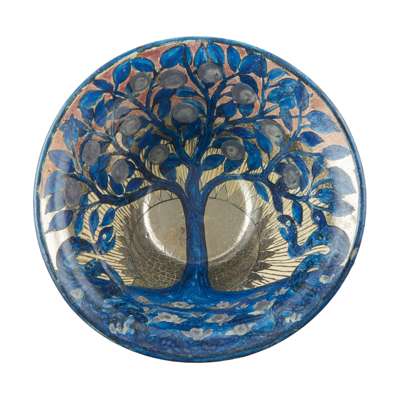
LOT 185
JOHN PEARSON (1859-1930)
LARGE EARTHENWARE BOWL, CIRCA 1900
SOLD FOR £4,750
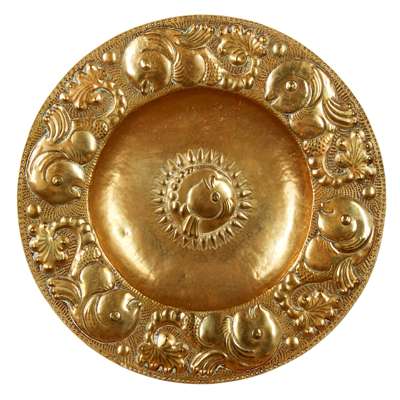
LOT 186
MANNER OF JOHN PEARSON
THREE ARTS & CRAFTS CHARGERS CIRCA 1890
SOLD FOR £813
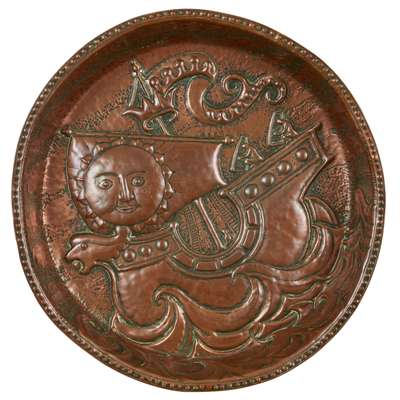
LOT 187
JOHN PEARSON (1859-1930)
ARTS & CRAFTS NEWLYN COPPER BOWL, DATED 1892
SOLD FOR £1,188
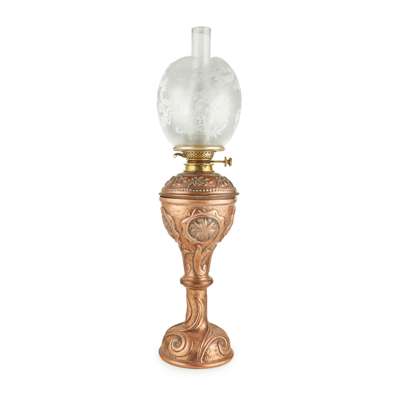
LOT 188
JOHN PEARSON (1859-1930)
LARGE ARTS & CRAFTS COPPER LAMP, DATED 1894
SOLD FOR £938
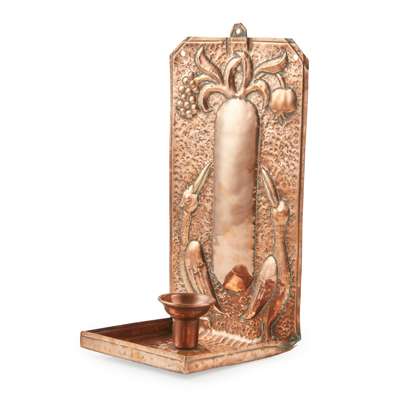
LOT 189
MANNER OF JOHN PEARSON FOR LIBERTY & CO., LONDON
ARTS & CRAFTS 'MEDIAEVAL' COPPER CANDLE SCONCE, CIRCA 1900
SOLD FOR £350
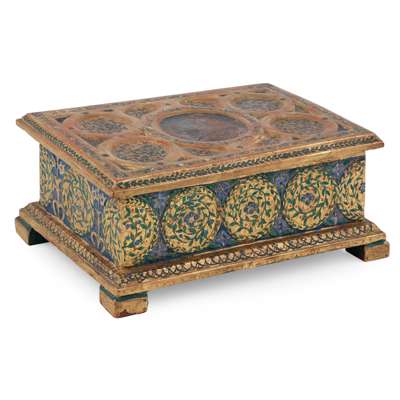
LOT 191
MANNER OF JESSIE BAYES
ARTS & CRAFTS CASKET, CIRCA 1890
SOLD FOR £300
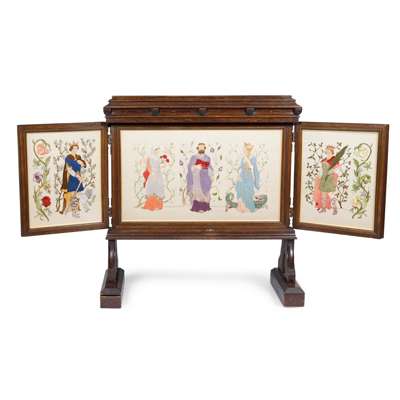
LOT 192
ENGLISH SCHOOL
ARTS & CRAFTS OAK-FRAMED TRIPTYCH, CIRCA 1910
SOLD FOR £575
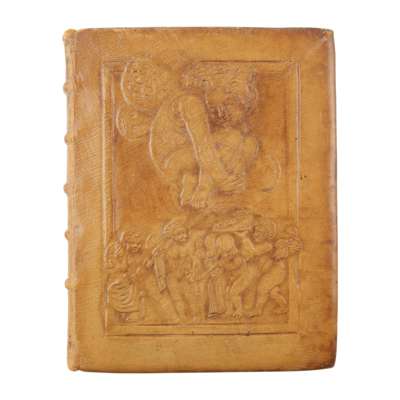
LOT 196
CARDEW, GLORIA. GUILD OF WOMEN-BINDERS
A MIDSUMMER NIGHT’S DREAM, CIRCA 1900
SOLD FOR £3,250
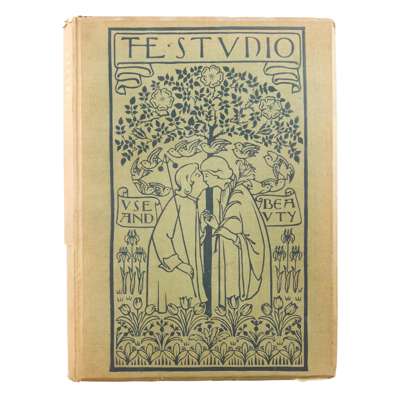
LOT 197
THE STUDIO, AN ILLUSTRATED MAGAZINE OF FINE AND APPLIED ART
EIGHTY-SIX VOLUMES / THIRTY-FOUR YEARBOOKS, TWELVE INDEXES
SOLD FOR £688
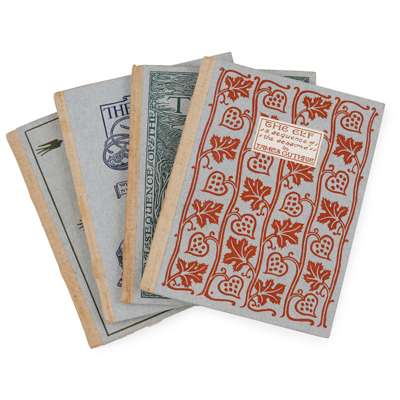
LOT 198
PEAR TREE PRESS - GUTHRIE, JAMES 'THE ELF'
A SEQUENCE OF THE SEASONS
SOLD FOR £575
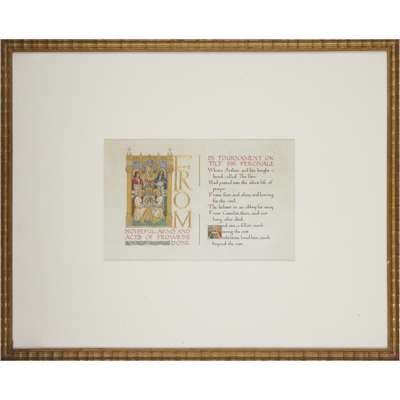
LOT 199
CAROLINE AGNES BURRAS (1890-1967)
ARTS & CRAFTS ILLUMINATED SHEET, CIRCA 1910
SOLD FOR £450

LOT 200
ENGLISH SCHOOL
ARTS & CRAFTS STAINED, PAINTED AND LEADED GLASS PANELS, CIRCA 1910
SOLD FOR £875

LOT 202
CARLO MANZONI (1855-1910) FOR MINERVA ART WARE MANUFACTURERS
GOURD VASE, DATED 1897
SOLD FOR £300

LOT 205
ATTRIBUTED TO THE ARTIFICERS' GUILD LTD.
WHITE METAL AND GEM SET PENDANT NECKLACE, CIRCA 1920
SOLD FOR £688

LOT 206
AMY SANDHEIM (FL. 1915-1939)
WHITE METAL AND GEM-SET BROOCH
SOLD FOR £688

LOT 207
ATTRIBUTED TO BERNARD INSTONE
FOUR BROOCHES, EARLY 20TH CENTURY
SOLD FOR £400

LOT 208
ATTRIBUTED TO BERNARD INSTONE
SILVER AND GEM SET BRACELET, EARLY 20TH CENTURY
SOLD FOR £750

LOT 209
WILLIAM NICHOLSON (1872-1949)
GROUP OF EIGHT WOODCUT PRINTS, CIRCA 1900
SOLD FOR £350

LOT 210
BIRMINGHAM GUILD OF HANDICRAFTS
BRASS AND COPPER KETTLE ON STAND, CIRCA 1900
SOLD FOR £325

LOT 211
ENGLISH SCHOOL, MANNER OF LIBERTY & CO., LONDON
ARTS & CRAFTS COPPER WALL MIRROR, CIRCA 1900
SOLD FOR £688

LOT 212
ENGLISH SCHOOL
ARTS & CRAFTS FENDER, CIRCA 1900
SOLD FOR £300

LOT 213
ENGLISH SCHOOL
ARTS & CRAFTS COPPER AND ENAMEL BOX, CIRCA 1900
SOLD FOR £275

LOT 214
ENGLISH SCHOOL, MANNER OF WALTER CRANE FOR LIBERTY & CO., LONDON
ARTS & CRAFTS COPPER PANEL, CIRCA 1900
SOLD FOR £813

LOT 2152
ENGLISH SCHOOL
ARTS & CRAFTS OAK TABLE CABINET, CIRCA 1910
SOLD FOR £300
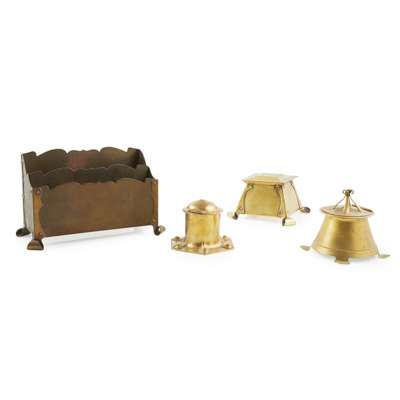
LOT 217
ENGLISH SCHOOL
GROUP OF ARTS & CRAFTS BRASS DESK WARES, CIRCA 1900
SOLD FOR £475
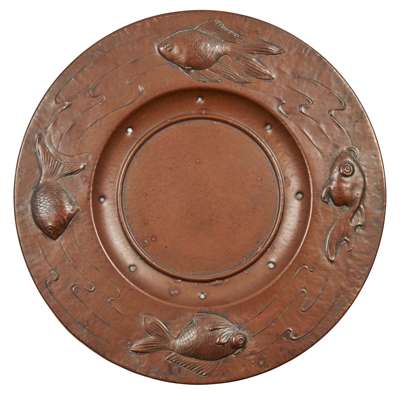
LOT 218
SCOTTISH SCHOOL
ARTS & CRAFTS CANDLE SCONCE, CIRCA 1900
SOLD FOR £325
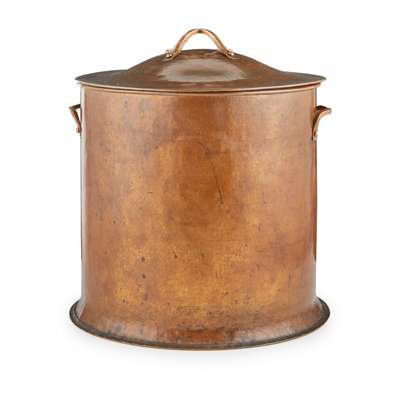
LOT 219
ATTRIBUTED TO JESSON, BIRKETT & CO., BIRMINGHAM
ARTS & CRAFTS COAL BUCKET & COVER, CIRCA 1900
SOLD FOR £350
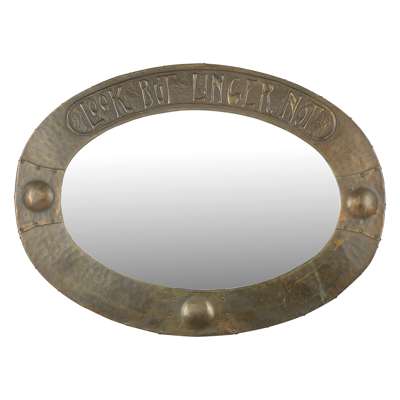
LOT 221
ENGLISH SCHOOL
ARTS & CRAFTS PATINATED COPPER ALLOY MIRROR, CIRCA 1900
SOLD FOR £625

LOT 224
ENGLISH SCHOOL
THREE ARTS & CRAFTS COPPER VESSELS, CIRCA 1900
SOLD FOR £300
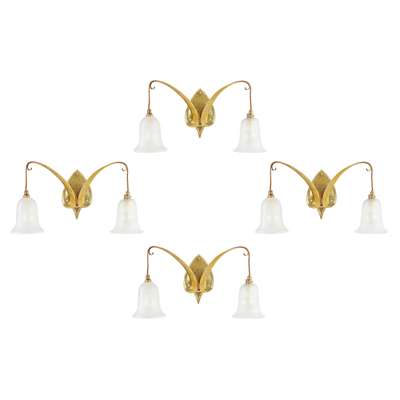
LOT 225
ATTRIBUTED TO THE BIRMINGHAM GUILD OF HANDICRAFT
SET OF FOUR ARTS & CRAFTS BRASS WALL SCONCES, CIRCA 1900
SOLD FOR £1,375
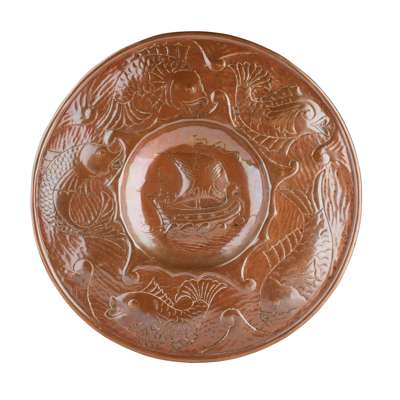
LOT 226
ATTRIBUTED TO JOHN PEARSON AFTER WILLIAM DE MORGAN
ARTS & CRAFTS COPPER CHARGER, CIRCA 1900
SOLD FOR £2,500
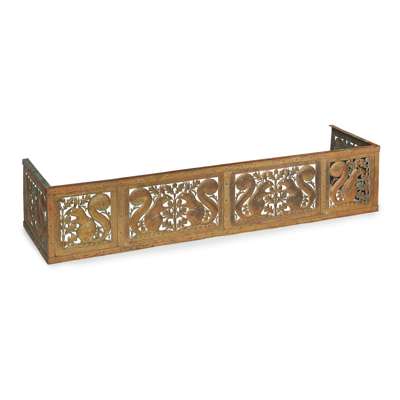
LOT 228
FIVEMILETOWN, COUNTY TYRONE
ARTS & CRAFTS BRASS FENDER, CIRCA 1895
SOLD FOR £4,750
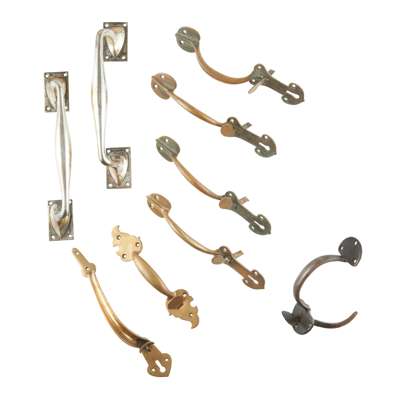
LOT 231
MANNER OF C.F.A. VOYSEY
GROUP OF ARTS & CRAFTS DOOR HANDLES, CIRCA 1920
SOLD FOR £400
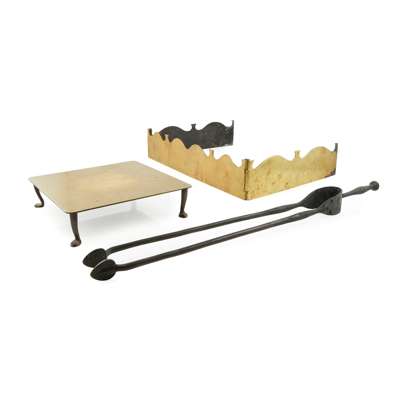
LOT 232
C. F. A. VOYSEY (1857-1941) FOR THOMAS ELSLEY & CO.
ARTS & CRAFTS BRASS FIRE IRON, CIRCA 1900
SOLD FOR £750
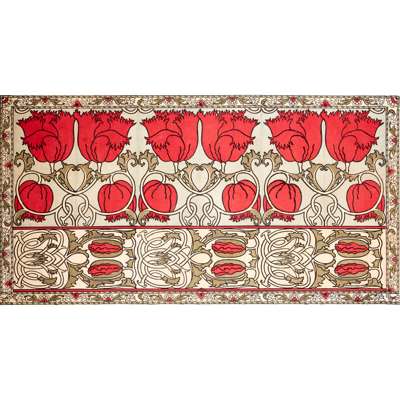
LOT 233
C.F.A. VOYSEY (1857-1941) FOR G.P. & J. BAKER LTD., SWAISLAND PRINT WORKS, ENGLAND
'POPPIES' PANEL, CIRCA 1895
SOLD FOR £2,500
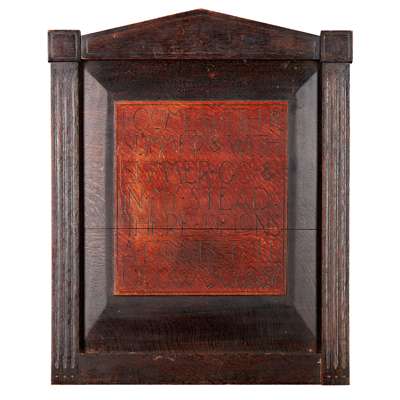
LOT 235
MANNER OF C. F. A. VOYSEY
ARTS & CRAFTS CARVED OAK TEXT PANEL, CIRCA 1900
SOLD FOR £400
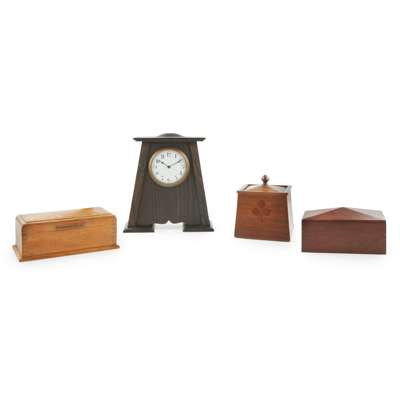
LOT 236
ENGLISH SCHOOL, MANNER OF C.F.A. VOYSEY
ARTS & CRAFTS STAINED OAK MANTEL CLOCK, CIRCA 1910
SOLD FOR £400
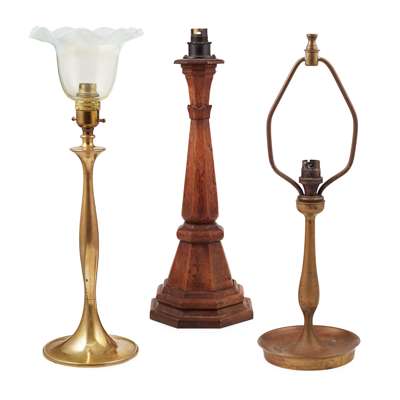
LOT 237
MANNER OF C.F.A. VOYSEY FOR THOMAS ELSLEY & CO.
ARTS & CRAFTS BRASS TABLE LAMP, CIRCA 1905
SOLD FOR £450
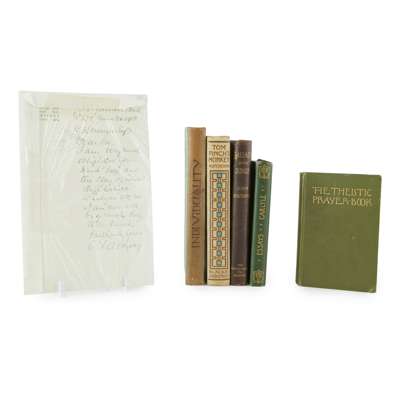
LOT 238
C.F.A. VOYSEY (1857-1941)
BOOK BINDINGS & AN AUTOGRAPHED LETTER
SOLD FOR £1,000
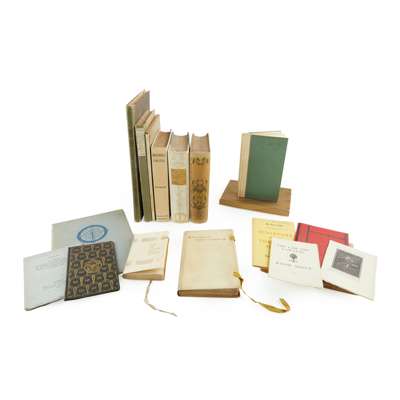
LOT 239
COLLECTION OF BOOKS & PRIVATE PRESS PUBLICATIONS
.
SOLD FOR £500
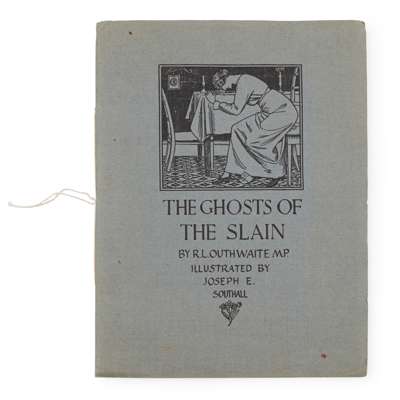
LOT 240
OUTHWAITE (R.L.).
THE GHOSTS OF THE SLAIN
SOLD FOR £450
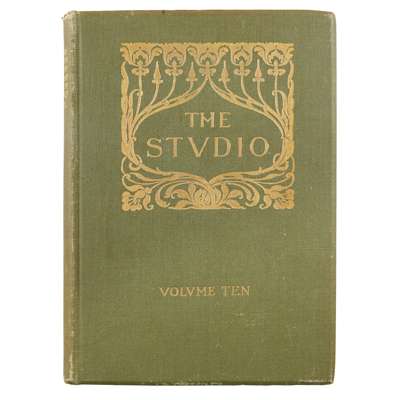
LOT 241
THE STUDIO, AN ILLUSTRATED MAGAZINE OF FINE AND APPLIED ART
FORTY-FOUR VOLUMES / NINE YEARBOOKS
SOLD FOR £475
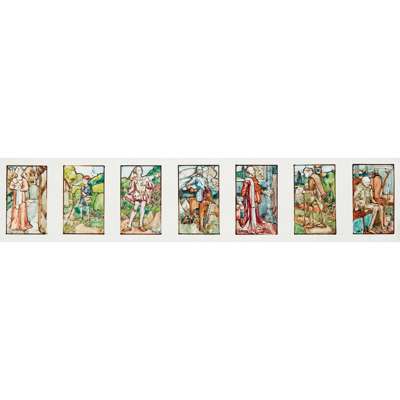
LOT 242
ENGLISH SCHOOL
SEVEN AGES OF MAN
SOLD FOR £350

LOT 243
C.R. ASHBEE (1863-1942) FOR ESSEX HOUSE PRESS, CHIPPING CAMPDEN
THE PRAYER BOOK OF KING EDWARD VII, 1903
SOLD FOR £1,750
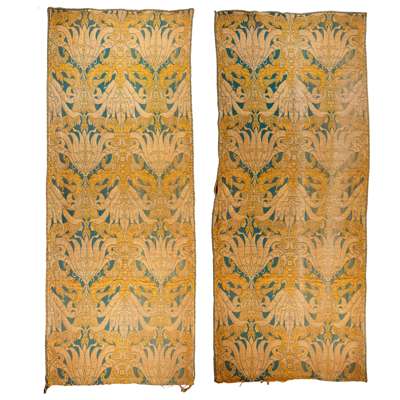
LOT 246
ENGLISH ARTS & CRAFTS
NEAR PAIR OF WOVEN HANGINGS, CIRCA 1900
SOLD FOR £4,375
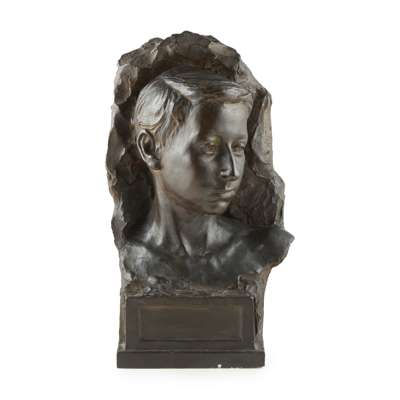
LOT 249
RICHARD GARBE (1876-1957)
BUST OF A BOY, DATED 1907
SOLD FOR £375
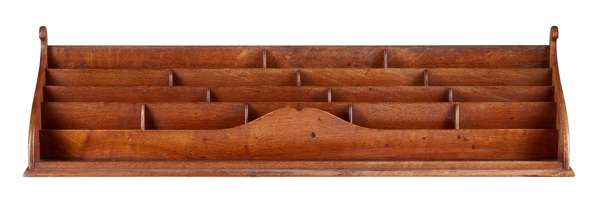
LOT 250
ARTHUR W. SIMPSON (1857-1922), KENDAL
ARTS & CRAFTS OAK STATIONARY RACK, CIRCA 1900
SOLD FOR £1,625
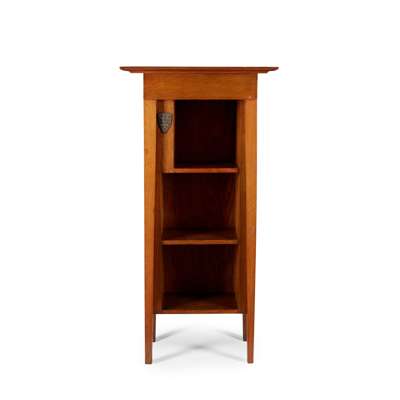
LOT 251
ENGLISH SCHOOL
ARTS & CRAFTS 'CAMBRIDGE UNIVERSITY' OAK BOOKCASE, CIRCA 1910
SOLD FOR £938
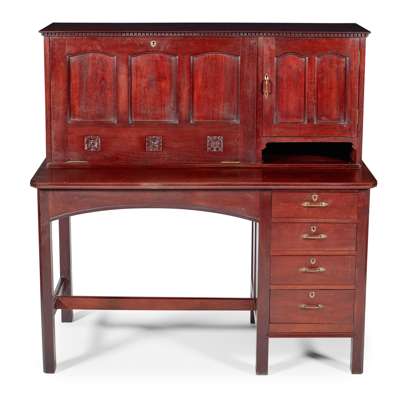
LOT 256
ARTHUR W. SIMPSON (1857-1922), KENDAL
ARTS & CRAFTS MAHOGANY WRITING DESK, CIRCA 1900
SOLD FOR £1,500
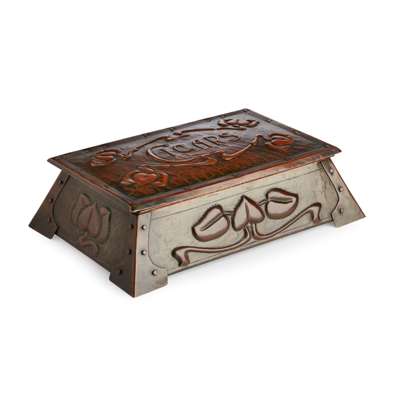
LOT 257
J & F POOL, HAYLE
ARTS & CRAFTS COPPER CIGAR BOX,
SOLD FOR £400
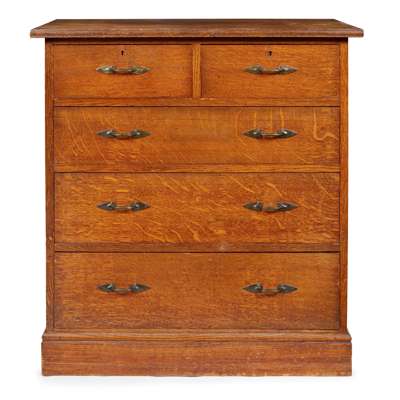
LOT 258
ARTHUR W. SIMPSON (1857-1922), KENDAL
ARTS & CRAFTS OAK CHEST OF DRAWERS, CIRCA 1900
SOLD FOR £3,500
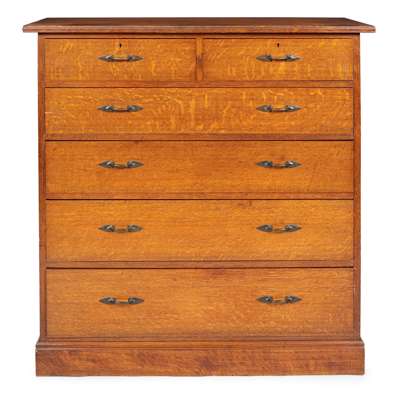
LOT 259
ARTHUR W. SIMPSON (1857-1922), KENDAL
ARTS & CRAFTS OAK CHEST OF DRAWERS, CIRCA 1920
SOLD FOR £5,000
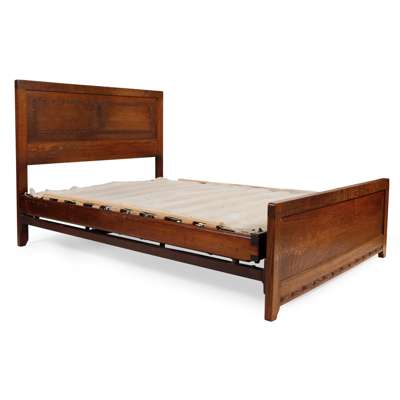
LOT 260
ARTHUR W. SIMPSON (1857-1922), KENDAL
ARTS & CRAFTS OAK DOUBLE BED, CIRCA 1900
SOLD FOR £1,500
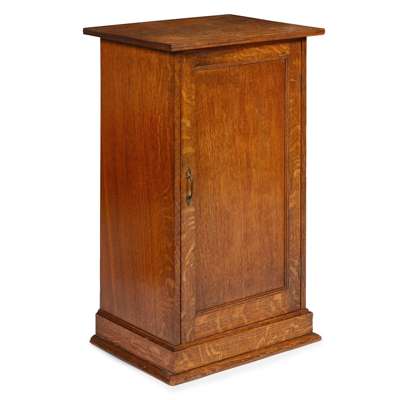
LOT 261
ARTHUR W. SIMPSON (1857-1922), KENDAL
ARTS & CRAFTS OAK BEDSIDE CABINET, CIRCA 1900
SOLD FOR £2,375
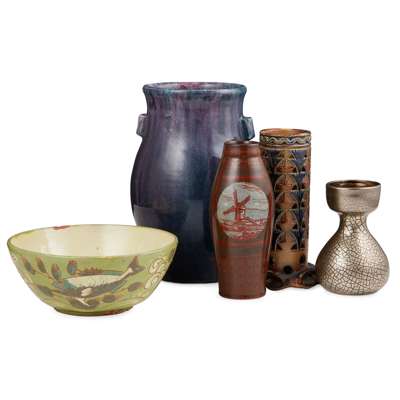
LOT 262
BRITISH ART POTTERY
GROUP OF FIVE WARES, CIRCA 1900
SOLD FOR £450
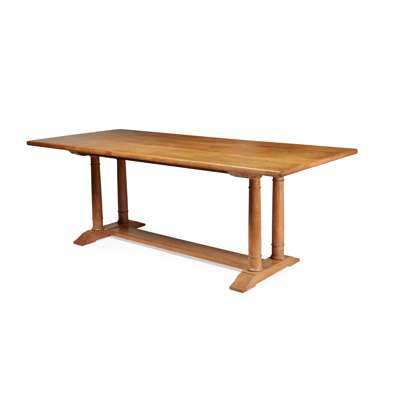
LOT 2642
PHILIP TILDEN (1887-1956) AND AMBROSE HEAL (1872-1959) FOR HEAL & SON, LONDON
'148' OAK REFECTORY TABLE, 1920s
SOLD FOR £1,875
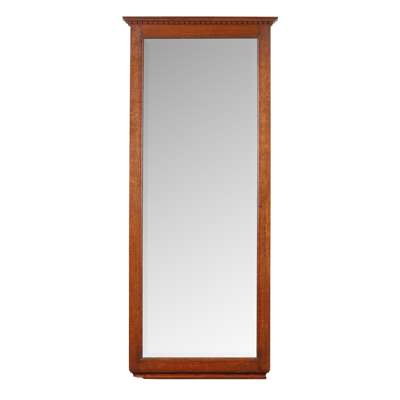
LOT 265
ARTHUR W. SIMPSON (1857-1922), KENDAL
ARTS & CRAFTS OAK WALL MIRROR, CIRCA 1900
SOLD FOR £813
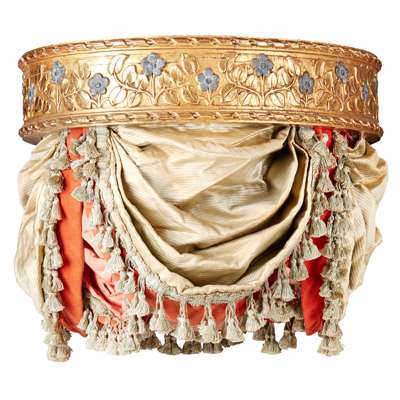
LOT 266
ENGLISH SCHOOL
ARTS & CRAFTS GILTWOOD & GESSO BED CORONA, CIRCA 1900
SOLD FOR £450
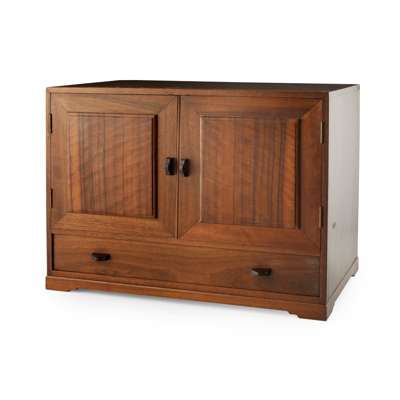
LOT 267
COTSWOLD SCHOOL
WALNUT TABLE CABINET, CIRCA 1930
SOLD FOR £400
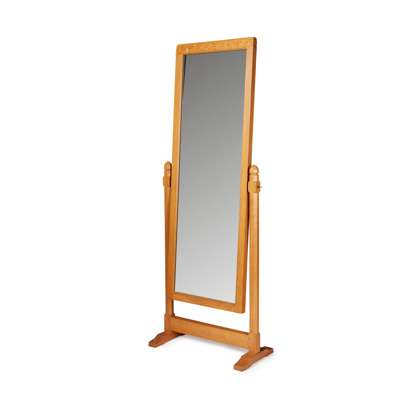
LOT 268
ROBERT 'MOUSEMAN' THOMPSON (1876-1955)
OAK CHEVAL MIRROR CIRCA 1950
SOLD FOR £1,375
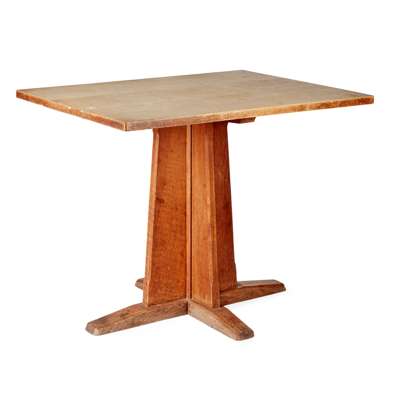
LOT 269
COTSWOLD SCHOOL
ARTS & CRAFTS OAK CENTRE TABLE, CIRCA 1920
SOLD FOR £750
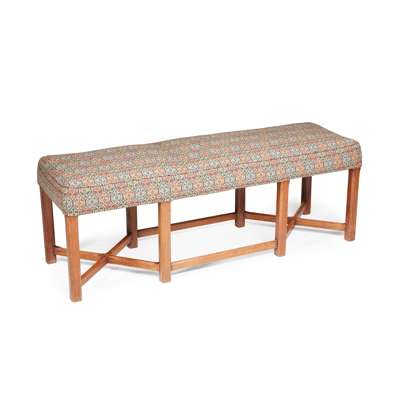
LOT 270
COTSWOLD SCHOOL
OAK LONG STOOL, CIRCA 1920
SOLD FOR £875
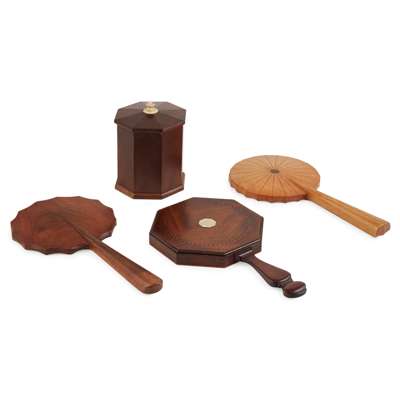
LOT 271
ATTRIBUTED TO HUGH BIRKETT
LABURNUM BOX, CIRCA 1980
SOLD FOR £938
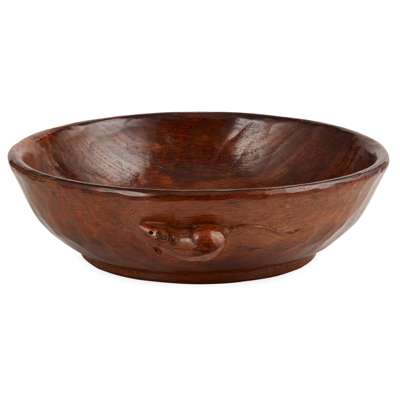
LOT 272
ROBERT 'MOUSEMAN' THOMPSON (1876-1955)
CIRCULAR OAK BOWL, 1930S-40S
SOLD FOR £1,500

LOT 273
ROBERT 'MOUSEMAN' THOMPSON (1876-1955)
OAK BOOKRACK, 1950S-60S
SOLD FOR £938
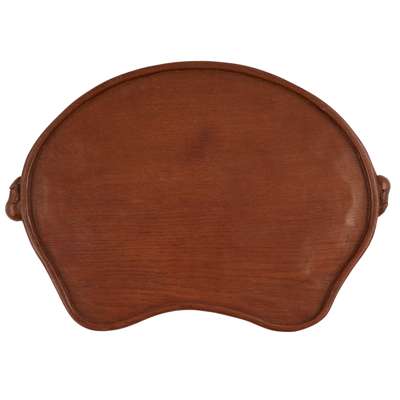
LOT 274
ROBERT 'MOUSEMAN' THOMPSON (1876-1955)
LARGE KIDNEY-SHAPED OAK TRAY, CIRCA 1970S-80S
SOLD FOR £400
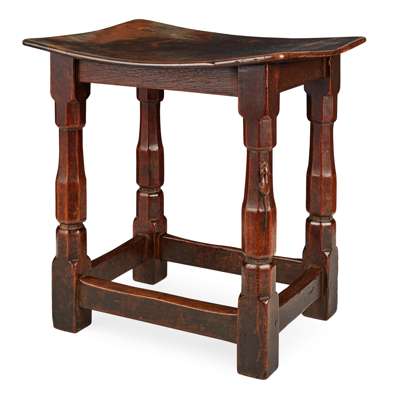
LOT 275
ROBERT 'MOUSEMAN' THOMPSON (1876-1955)
EARLY OAK STOOL, CIRCA 1930
SOLD FOR £1,750
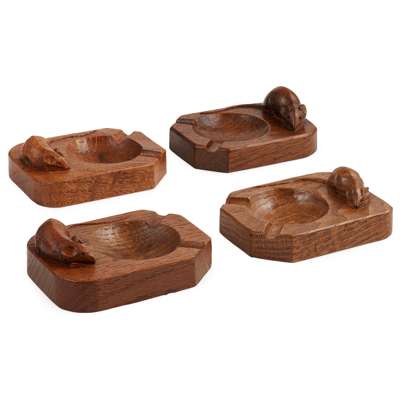
LOT 276
ROBERT 'MOUSEMAN' THOMPSON (1876-1955)
A GROUP OF OAK ASHTRAYS, CIRCA 1950S-60S
SOLD FOR £425
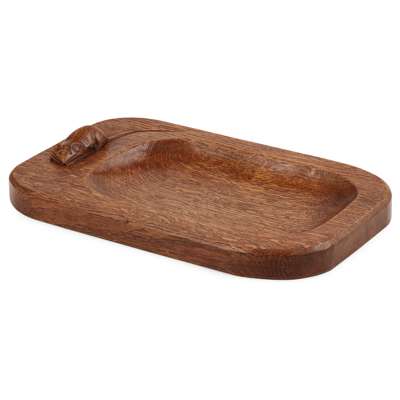
LOT 277
ROBERT 'MOUSEMAN' THOMPSON (1876-1955)
LARGE OAK TRINKET TRAY, 1980S
SOLD FOR £750
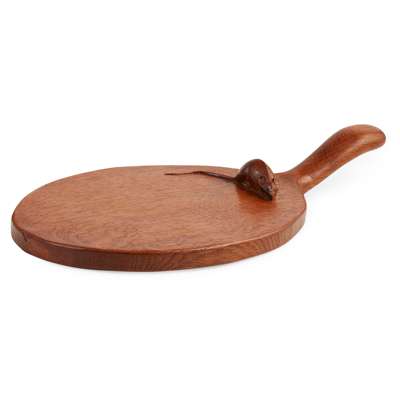
LOT 278
ROBERT 'MOUSEMAN' THOMPSON (1876-1955)
OAK CHEESE BOARD, 1940S-50S
SOLD FOR £1,188
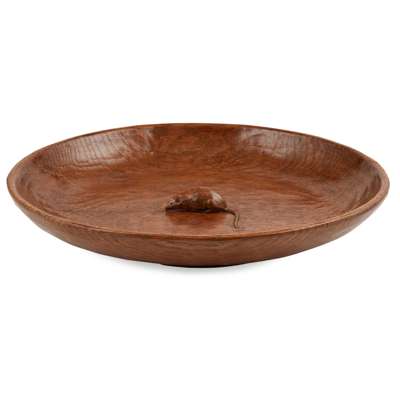
LOT 279
ROBERT 'MOUSEMAN' THOMPSON (1876-1955)
EXTRA-SIZED OAK BOWL, 1970S-80S
SOLD FOR £1,125
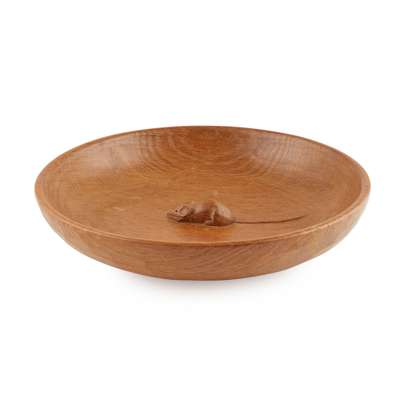
LOT 280
ROBERT 'MOUSEMAN' THOMPSON (1876-1955)
LARGE OAK BOWL, 1970S-80S
SOLD FOR £600
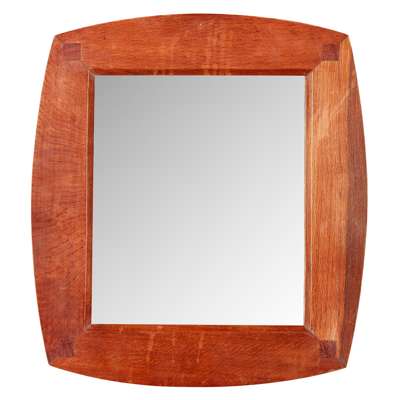
LOT 281
COTSWOLD SCHOOL
OAK-FRAMED WALL MIRROR, CIRCA 1930
SOLD FOR £300
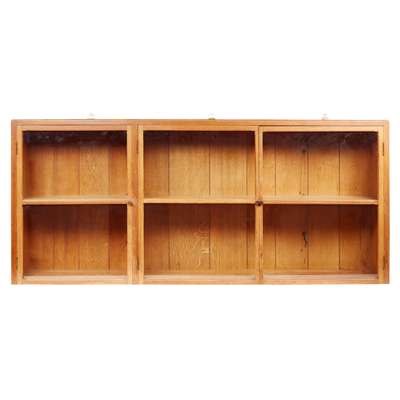
LOT 282
COTSWOLD SCHOOL
OAK HANGING CUPBOARD, CIRCA 1930
SOLD FOR £375
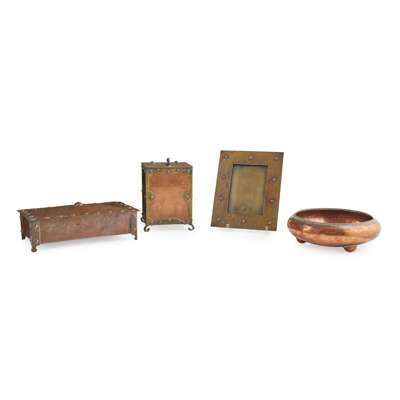
LOT 283
GORDON RUSSELL (1892-1980)
'LYGON' COPPER BOWL, CIRCA 1920
SOLD FOR £325
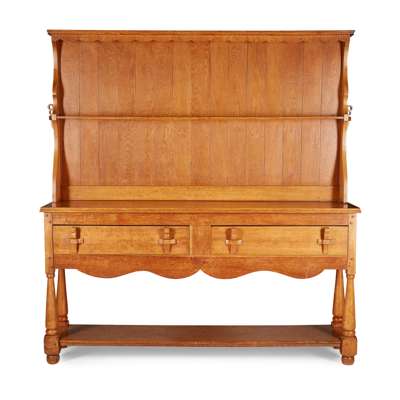
LOT 284
ENGLISH SCHOOL
ARTS & CRAFTS OAK DRESSER, CIRCA 1900
SOLD FOR £625

LOT 285
FRANK HENRY MASON (1875-1965)
ABERDEEN AND ROYAL DEESIDE
SOLD FOR £813

LOT 288
EDWIN CALLIGAN
GENERAL WADE'S BRIDGE, ABERFELDY, SHELL
SOLD FOR £475

LOT 289
FRED TAYLOR (1875-1963)
OXFORD
SOLD FOR £1,063
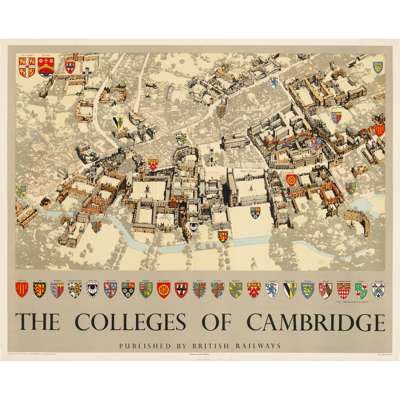
LOT 290
FRED TAYLOR (1875-1963)
THE COLLEGES OF CAMBRIDGE
SOLD FOR £1,000
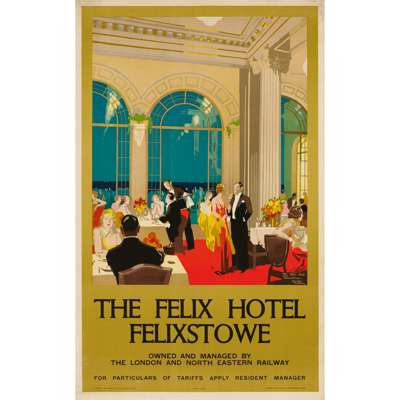
LOT 291
GORDON NICOLL (1988-1959)
THE FELIX HOTEL, FELIXSTOWE
SOLD FOR £1,125

LOT 294
RENÉ GRUAU (RENATO DE ZAVAGLI, 1909-2004)
RELAX...
SOLD FOR £500

LOT 295
PIERRE ZENOBEL (1905-1996)
A NEW BLUE TRAIN TO THE COTE D'AZUR
SOLD FOR £3,500
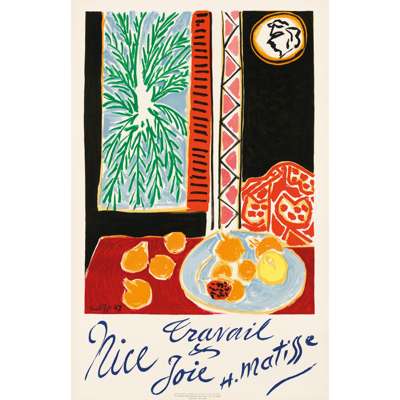
LOT 296
AFTER HENRI MATISSE (1869-1954)
NICE
SOLD FOR £875
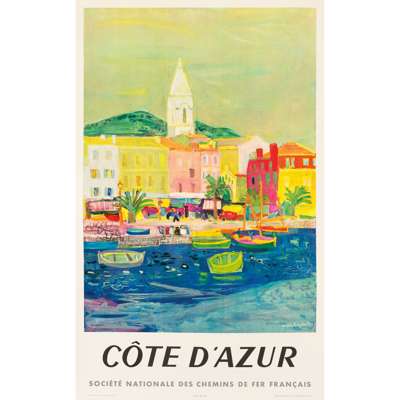
LOT 298
ROGER BEZCOMBES (1913-1994)
CÔTE D'AZUR
SOLD FOR £313
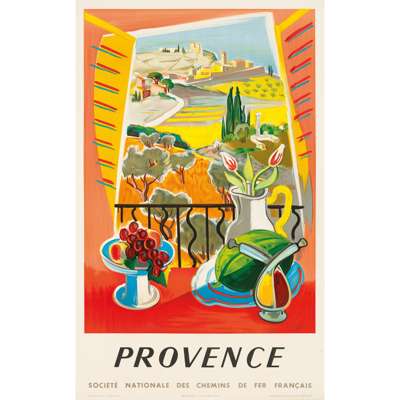
LOT 299
JEAN JACQUELIN (1905-1989)
PROVENCE
SOLD FOR £375
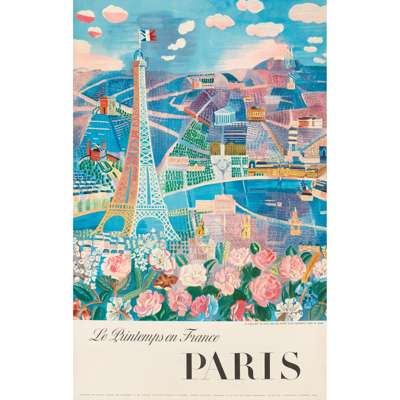
LOT 300
AFTER RAOUL DUFY (1877-1953)
PARIS
SOLD FOR £300
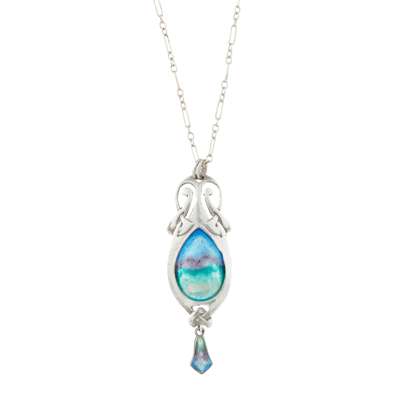
LOT 304
ENGLISH SCHOOL
ART NOUVEAU SILVER AND ENAMEL, PENDANT, CIRCA 1910
SOLD FOR £500
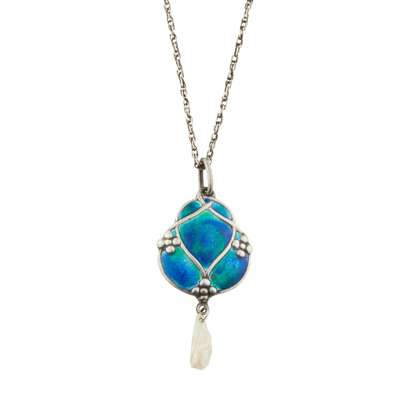
LOT 305
MURRLE BENNETT & CO.
ART NOUVEAU SILVER AND ENAMEL PENDANT, CIRCA 1900
SOLD FOR £650
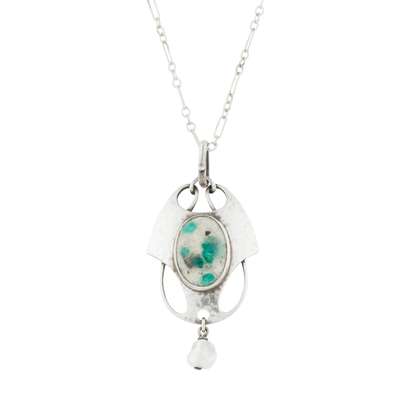
LOT 306
MURRLE BENNETT & CO.
ARTS & CRAFTS SILVER AND GEM-SET PENDANT, CIRCA 1906
SOLD FOR £450
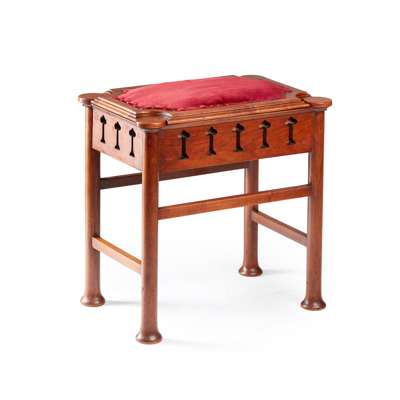
LOT 307
SHAPLAND & PETTER, BARNSTAPLE
ARTS & CRAFTS MAHOGANY PIANO STOOL, CIRCA 1900
SOLD FOR £375
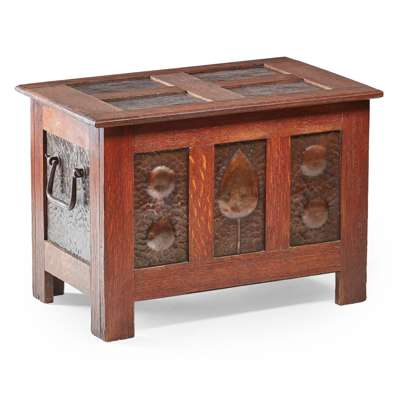
LOT 308
SHAPLAND & PETTER, BARNSTAPLE
ARTS & CRAFTS OAK FRAMED LOG BOX, CIRCA 1900
SOLD FOR £1,250
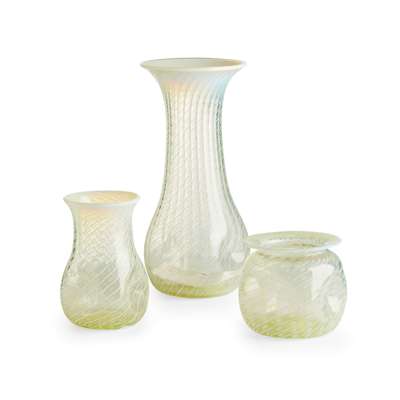
LOT 312
JOHN WALSH WALSH, BIRMINGHAM
GROUP OF THREE VASELINE GLASS 'FISHNET' VASES, CIRCA 1910
SOLD FOR £300
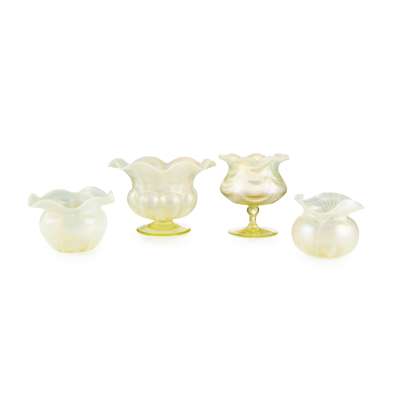
LOT 313
JOHN WALSH WALSH, BIRMINGHAM
TWO ENGLISH ART NOUVEAU OPALESCENT GLASS VASES, CIRCA 1910
SOLD FOR £450
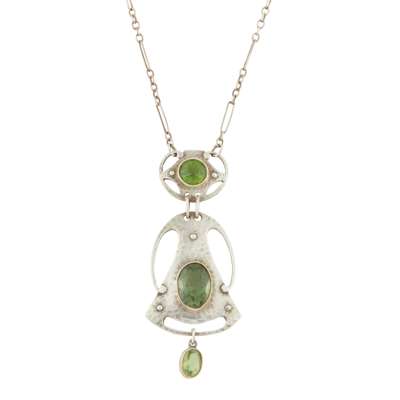
LOT 314
MURRLE BENNETT & CO.
ARTS & CRAFTS SILVER AND GEM-SET PENDANT, CIRCA 1906
SOLD FOR £938

LOT 315
ATTRIBUTED TO MURRLE BENNETT & CO.
ART NOUVEAU PENDANT, CIRCA 1900
SOLD FOR £750
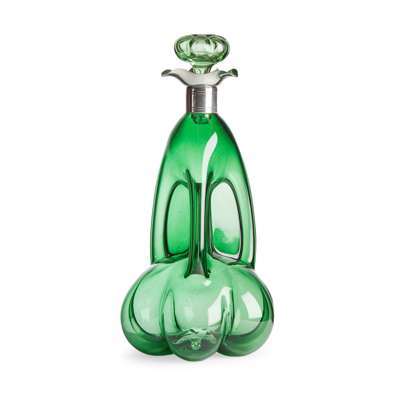
LOT 320
STEVENS & WILLIAMS, STOURBRIDGE
ART NOUVEAU GREEN GLASS DECANTER, CIRCA 1895
SOLD FOR £300
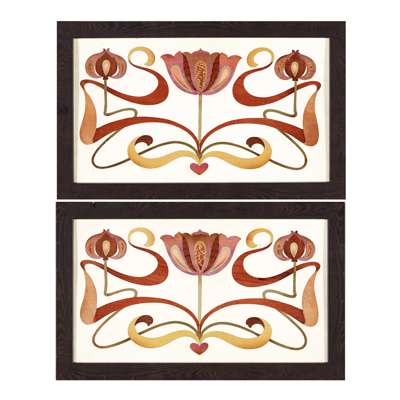
LOT 323
SHAPLAND & PETTER, BARNSTAPLE
PAIR OF ART NOUVEAU INLAID PANELS, CIRCA 1910
SOLD FOR £425

LOT 324
SHAPLAND AND PETTER, BARNSTAPLE
ART NOUVEAU OAK SIDEBOARD, CIRCA 1910
SOLD FOR £1,000
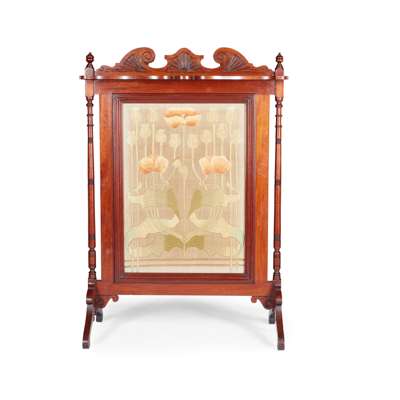
LOT 326
ENGLISH SCHOOL
ARTS & CRAFTS MAHOGANY FRAMED FIRESCREEN, CIRCA 1900
SOLD FOR £475
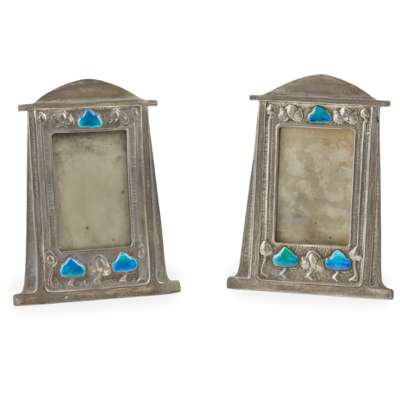
LOT 330
ATTRIBUTED TO LIBERTY & CO., LONDON
PAIR OF ARTS & CRAFTS PEWTER AND ENAMEL PHOTOGRAPH FRAMES, CIRCA 1900
SOLD FOR £1,250
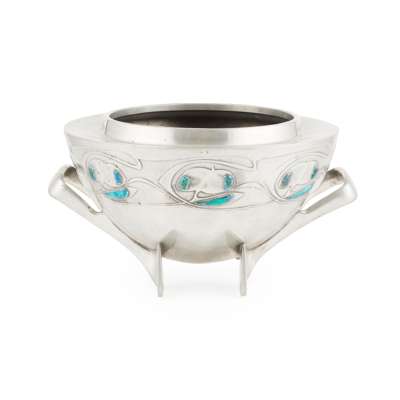
LOT 331
ARCHIBALD KNOX (1899-1933) FOR LIBERTY & CO., LONDON
'TUDRIC' PEWTER AND ENAMEL-SET ROSE BOWL, CIRCA 1900
SOLD FOR £1,000
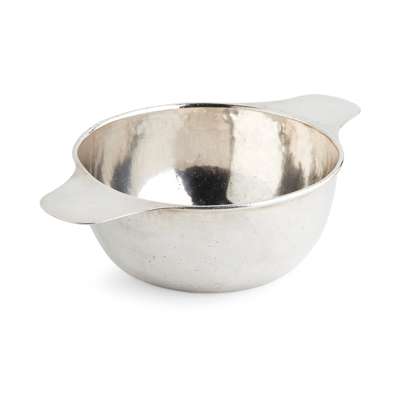
LOT 332
LIBERTY & CO., LONDON
SILVER QUAICH, BIRMINGHAM 1922
SOLD FOR £300
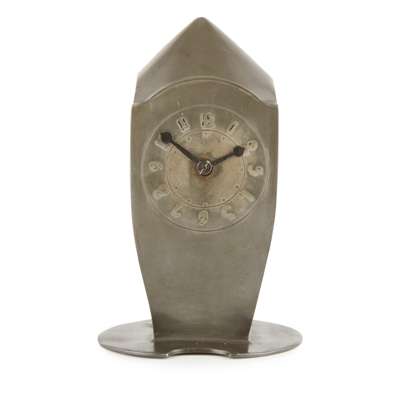
LOT 333
ARCHIBALD KNOX (1864-1933) FOR LIBERTY & CO., LONDON
RARE 'TUDRIC' PEWTER CLOCK, CIRCA 1900
SOLD FOR £4,500
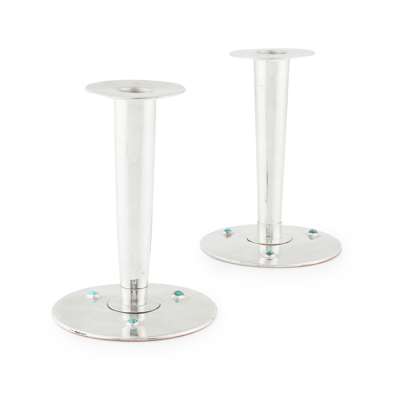
LOT 334
ARCHIBALD KNOX (1864-1933) FOR LIBERTY & CO., LONDON
PAIR OF ARTS & CRAFTS SILVER CANDLESTICKS, BIRMINGHAM, 1905-06
SOLD FOR £1,125
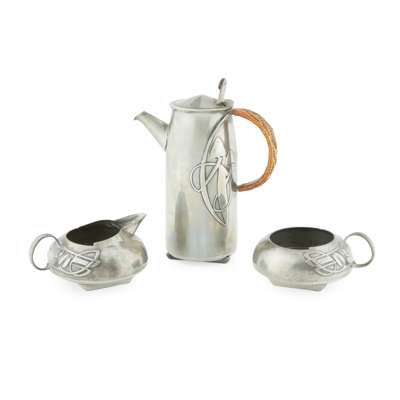
LOT 335
ARCHIBALD KNOX (1864-1933) FOR LIBERTY & CO., LONDON
TUDRIC PEWTER COFFEE SERVICE, CIRCA 1905
SOLD FOR £450
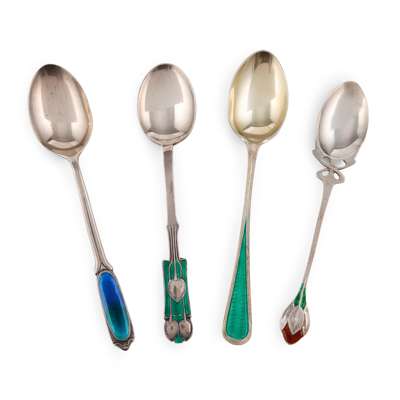
LOT 336
ARCHIBALD KNOX (1864-1933) FOR LIBERTY & CO., LONDON
ART NOUVEAU SILVER AND ENAMEL TEASPOON, BIRMINGHAM 1903
SOLD FOR £525
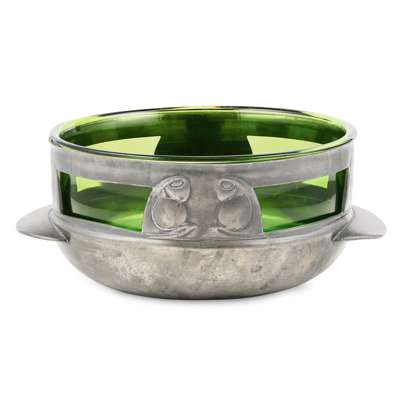
LOT 337
ARCHIBALD KNOX (1864-1933) FOR LIBERTY & CO., LONDON
'TUDRIC' PEWTER TWIN-HANDLED BOWL, CIRCA 1900
SOLD FOR £400
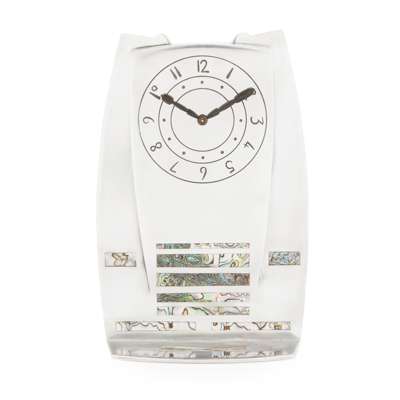
LOT 338
ARCHIBALD KNOX (1864-1933) FOR LIBERTY & CO., LONDON
RARE EXTRA-SIZE 'TUDRIC' PEWTER CLOCK, CIRCA 1900
SOLD FOR £23,750
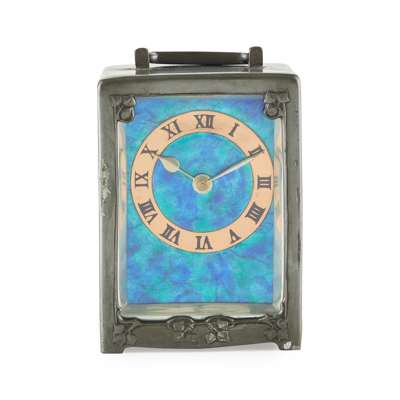
LOT 339
ARCHIBALD KNOX (1864-1933) FOR LIBERTY & CO., LONDON
'TUDRIC' PEWTER AND ENAMEL CARRIAGE CLOCK, CIRCA 1900
SOLD FOR £2,000
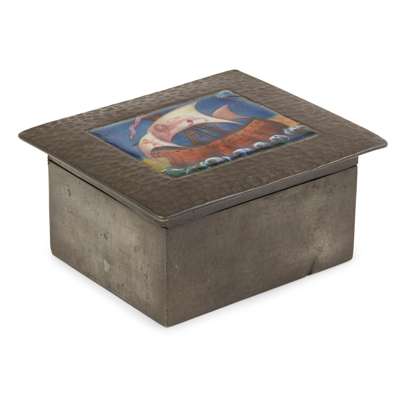
LOT 340
W.H.HASELER FOR LIBERTY & CO. LONDON
PEWTER & ENAMEL BOX, CIRCA 1907
SOLD FOR £300
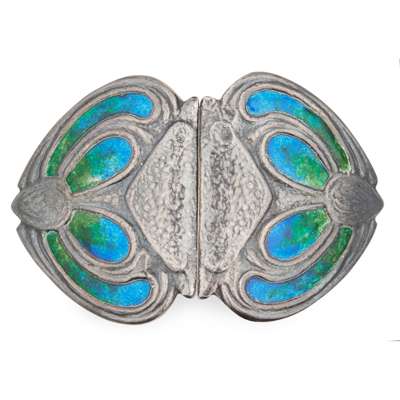
LOT 341
LIBERTY & CO., LONDON
ARTS & CRAFTS SILVER AND ENAMEL BELT BUCKLE, 1902
SOLD FOR £375
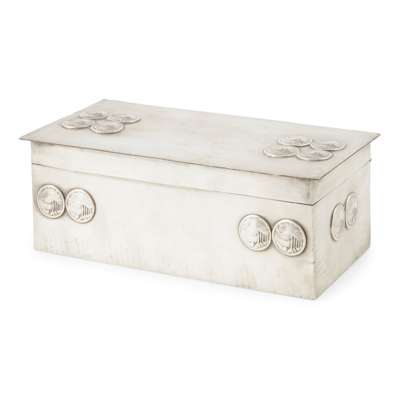
LOT 342
LIBERTY & CO., LONDON
'TUDRIC' PEWTER BOX, CIRCA 1900
SOLD FOR £325
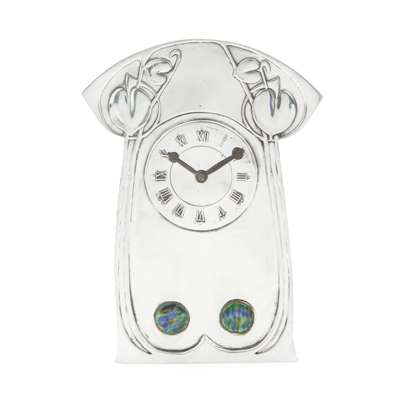
LOT 343
ARCHIBALD KNOX (1864-1933) FOR LIBERTY & CO., LONDON
'TUDRIC' PEWTER AND ENAMEL MANTEL CLOCK, CIRCA 1900
SOLD FOR £3,750
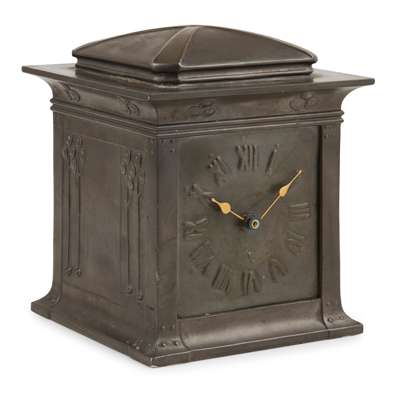
LOT 344
ATTRIBUTED TO DAVID VEASEY FOR LIBERTY & CO., LONDON
'TUDRIC' PEWTER MANTEL CLOCK, CIRCA 1910
SOLD FOR £2,125
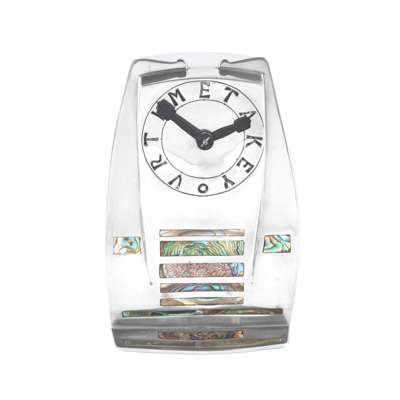
LOT 344A
ARCHIBALD KNOX (1864-1933) FOR LIBERTY & CO., LONDON
'TUDRIC' PEWTER CLOCK, CIRCA 1900
SOLD FOR £5,000
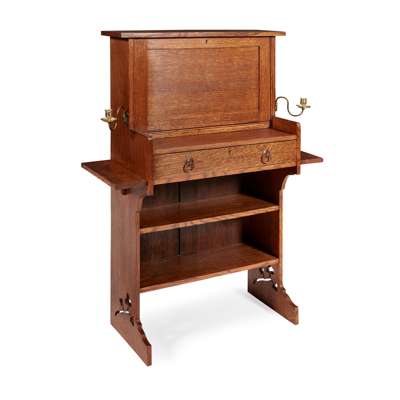
LOT 345
LIBERTY AND CO., LONDON
ARTS & CRAFTS OAK SECRETAIRE, CIRCA 1900
SOLD FOR £600
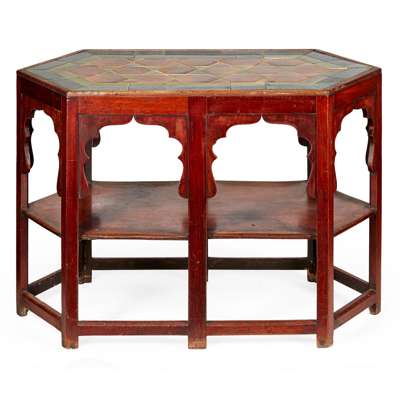
LOT 346
ATTRIBUTED TO LIBERTY AND CO., LONDON
ANGLO-MORESQUE OCCASIONAL TABLE, CIRCA 1910
SOLD FOR £1,063
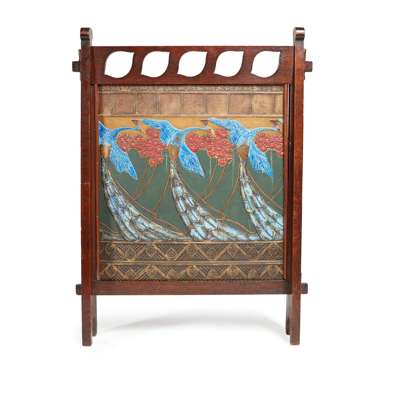
LOT 347
ATTRIBUTED TO LIBERTY & CO., LONDON
ARTS & CRAFTS OAK FIRESCREEN, CIRCA 1910
SOLD FOR £500
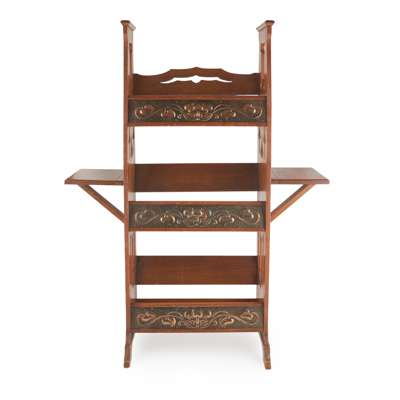
LOT 348
ATTRIBUTED TO LIBERTY & CO., LONDON
ART NOUVEAU BOOKCASE, CIRCA 1900
SOLD FOR £275
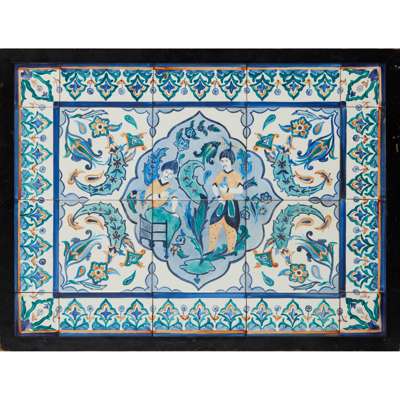
LOT 349
ENGLISH SCHOOL, MANNER OF PILKINGTON'S TILE & POTTERY CO.
FRAMED PERSIAN STYLE PAINTED TILE PANEL, 20TH CENTURY
SOLD FOR £300
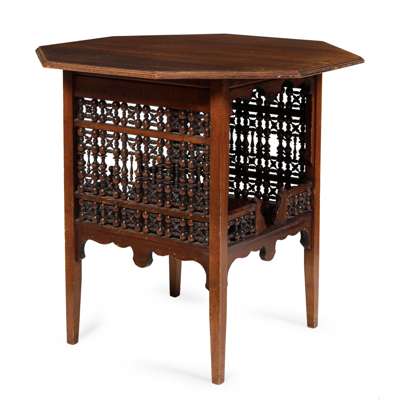
LOT 350
ATTRIBUTED TO LIBERTY & CO., LONDON
ANGLO-MORESQUE WALNUT OCCASIONAL TABLE, CIRCA 1900
SOLD FOR £325
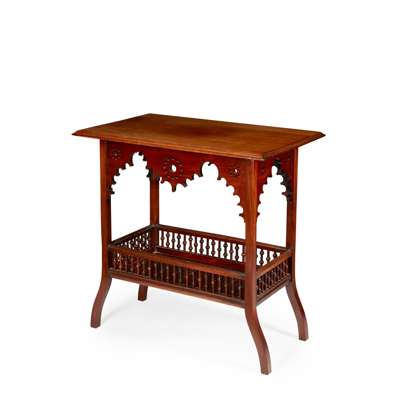
LOT 351
ATTRIBUTED TO LIBERTY & CO., LONDON
ANGLO-MORESQUE MAHOGANY OCCASIONAL TABLE, CIRCA 1910
SOLD FOR £938
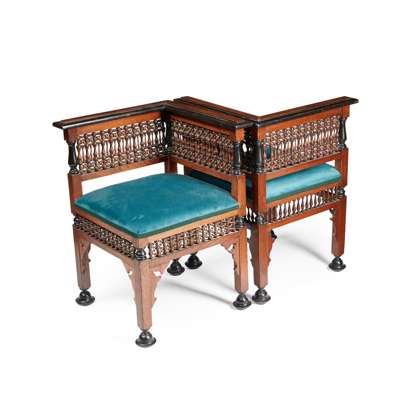
LOT 352
MANNER OF LIBERTY & CO., LONDON
PAIR OF ANGLO-MORESQUE CORNER ARMCHAIRS, CIRCA 1910
SOLD FOR £813
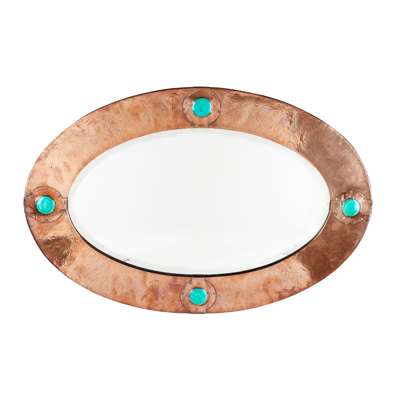
LOT 355
MANNER OF LIBERTY & CO., LONDON
ARTS & CRAFTS COPPER AND ENAMEL WALL MIRROR, CIRCA 1900
SOLD FOR £500
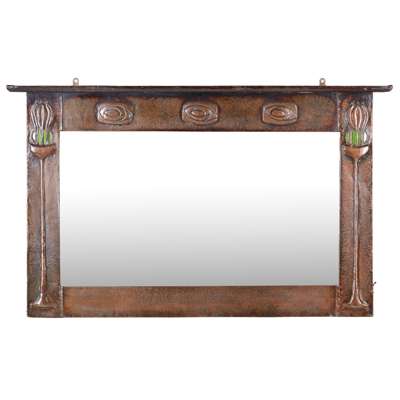
LOT 356
ATTRIBUTED TO GOODYERS, LONDON
ARTS & CRAFTS OVERMANTEL MIRROR, CIRCA 1900
SOLD FOR £2,500
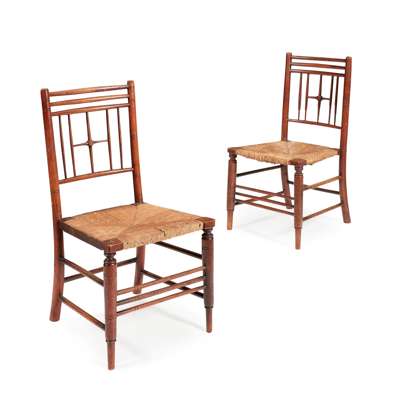
LOT 357
LIBERTY & CO., LONDON
PAIR OF WALNUT ARTS & CRAFTS 'ARGYLL' SIDE CHAIRS, CIRCA 1890
SOLD FOR £375
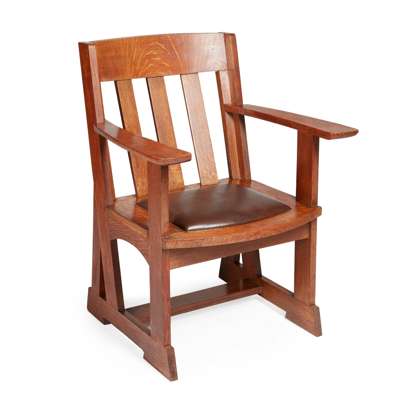
LOT 358
LEONARD WYBURD (1865-1958) FOR LIBERTY & CO., LONDON
‘ATHELSTAN’ ARTS & CRAFTS ARMCHAIR, CIRCA 1900
SOLD FOR £2,000
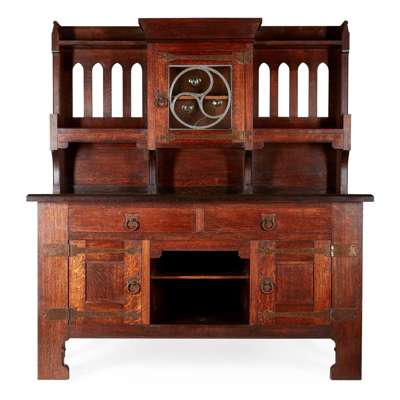
LOT 360
LIBERTY & CO., LONDON
ARTS & CRAFTS OAK SIDEBOARD, CIRCA 1900
SOLD FOR £1,125
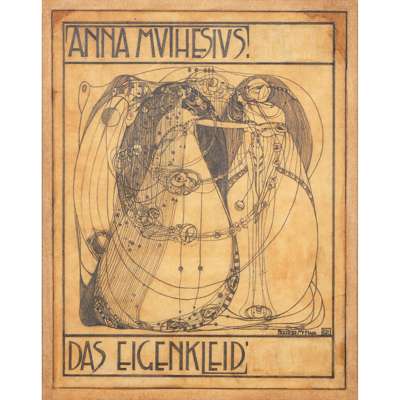
LOT 361
FRANCES MACDONALD MCNAIR (1873-1921)
DESIGN FOR A COVER FOR 'DAS EIGENKLEID DER FRAU', 1903
SOLD FOR £125,000
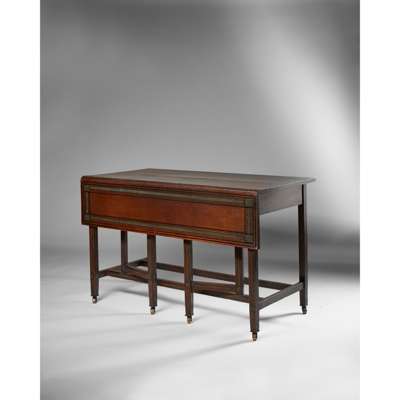
LOT 362
CHARLES RENNIE MACKINTOSH (1868-1928)
GATE-LEG TABLE, CIRCA 1910
SOLD FOR £8,750
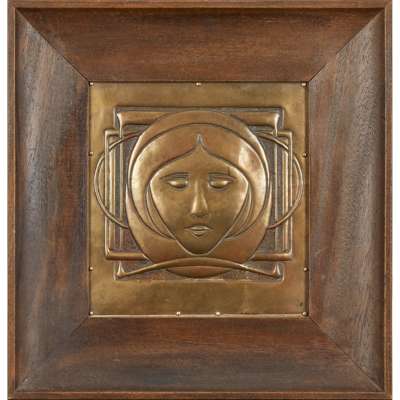
LOT 363
TALWIN MORRIS (1865-1911)
GLASGOW SCHOOL SYMBOLIST PANEL, CIRCA 1900
SOLD FOR £4,750
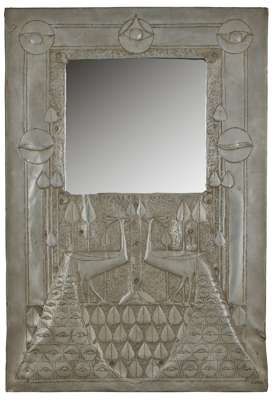
LOT 364
GLASGOW SCHOOL
ART NOUVEAU WALL MIRROR, CIRCA 1900
SOLD FOR £5,000
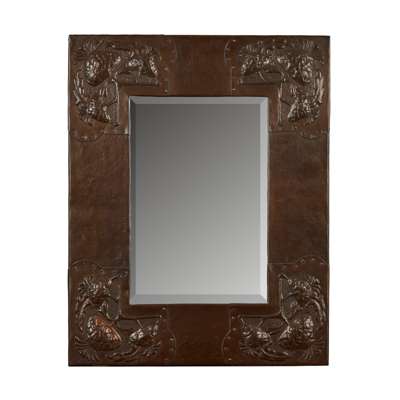
LOT 365
SCOTTISH SCHOOL
ARTS & CRAFTS WALL MIRROR, CIRCA 1920
SOLD FOR £575
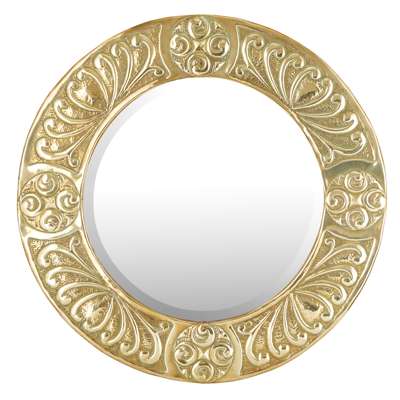
LOT 366
SCOTTISH SCHOOL
ARTS & CRAFTS BRASS WALL MIRROR, CIRCA 1920
SOLD FOR £275
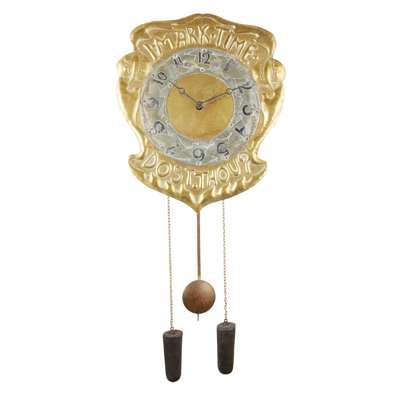
LOT 367
SCOTTISH SCHOOL
ARTS AND CRAFTS WALL CLOCK, CIRCA 1900
SOLD FOR £425
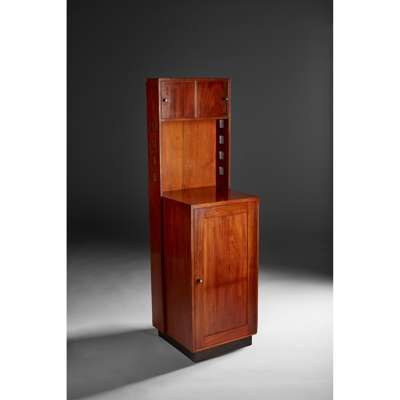
LOT 368
CHARLES RENNIE MACKINTOSH (1868-1928)
INLAID MAHOGANY BEDSIDE CABINET, 1916
SOLD FOR £250,000
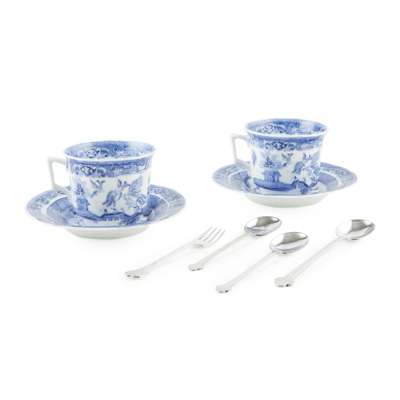
LOT 369
CHARLES RENNIE MACKINTOSH (1868-1928) FOR MISS CRANSTON'S TEAROOMS, GLASGOW
GROUP OF TEA WARES, CIRCA 1900
SOLD FOR £938
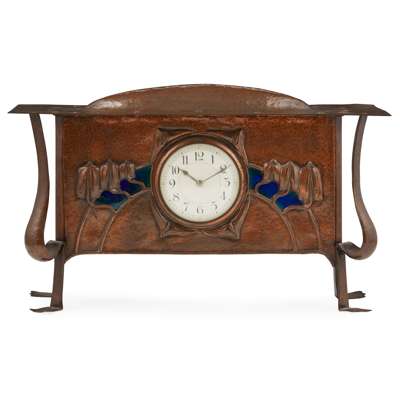
LOT 370
ATTRIBUTED TO GEORGE WALTON FOR GOODYERS, LONDON
ARTS & CRAFTS MANTEL CLOCK, CIRCA 1900
SOLD FOR £3,750
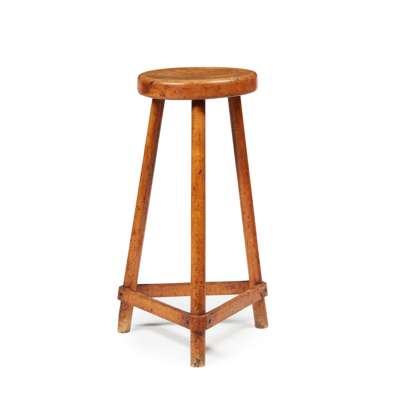
LOT 371
CHARLES RENNIE MACKINTOSH (1868-1928)
HIGH STOOL, CIRCA 1894
SOLD FOR £1,063
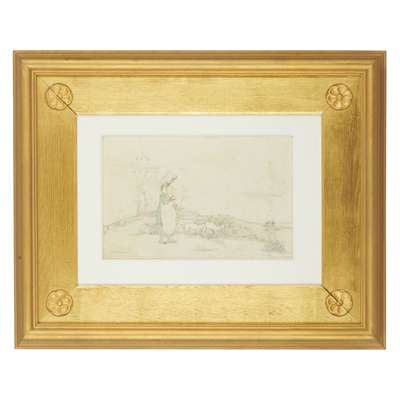
LOT 374
JESSIE MARION KING (1875-1949)
'THE SHEPHERDESS'
SOLD FOR £2,500

LOT 375
MARY NEWBERRY STURROCK (1892-1985)
IPOMOEA, AGAPANTHUS, G. ASCLEPIADA
SOLD FOR £600
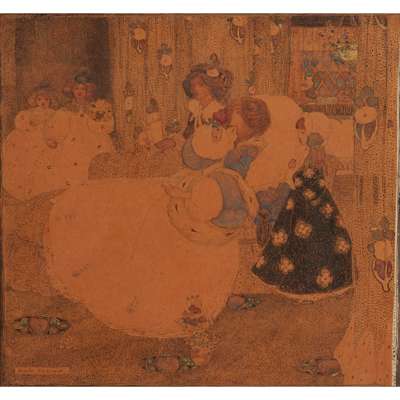
LOT 376
ANNIE FRENCH (1872-1965)
THE ROSE
SOLD FOR £4,250
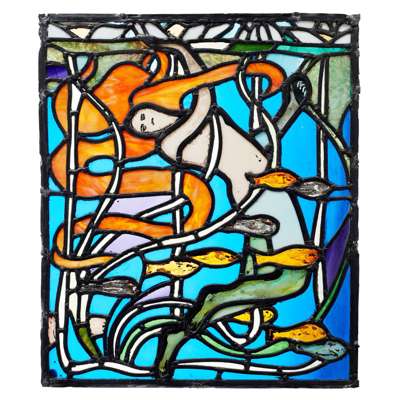
LOT 377
AFTER W.G. MORTON
ART NOUVEAU STYLE STAINED AND LEADED GLASS PANEL, LATE 20TH CENTURY
SOLD FOR £1,625
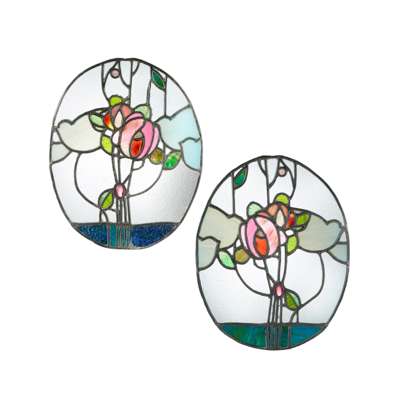
LOT 378
GLASGOW SCHOOL
PAIR OF STAINED GLASS WINDOW PANELS, CIRCA 1900
SOLD FOR £300
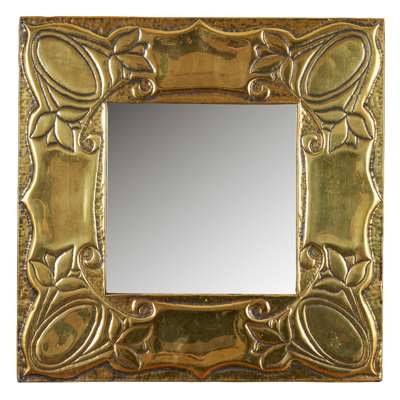
LOT 379
SCOTTISH SCHOOL
ARTS & CRAFTS MIRROR, CIRCA 1910
SOLD FOR £350
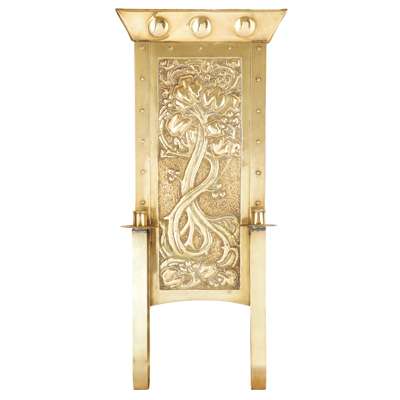
LOT 380
MARGARET GILMOUR (1860-1942)
GLASGOW SCHOOL BRASS WALL SCONCE, CIRCA 1910
SOLD FOR £1,125
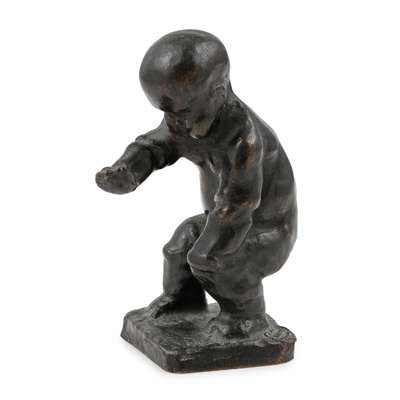
LOT 381
REGINALD FAIRFAX WELLS (1877-1933)
'BABY TRYING TO WALK', CIRCA 1900
SOLD FOR £2,250
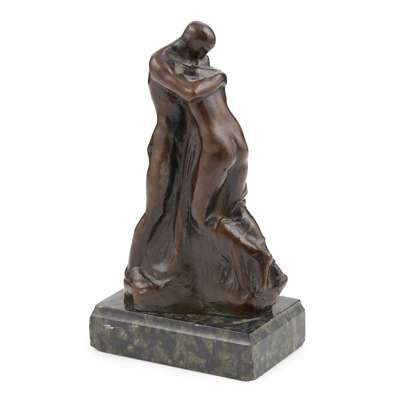
LOT 382
SIR CHARLES THOMAS WHEELER (1892-1974)
'EMBRACING COUPLE'
SOLD FOR £875
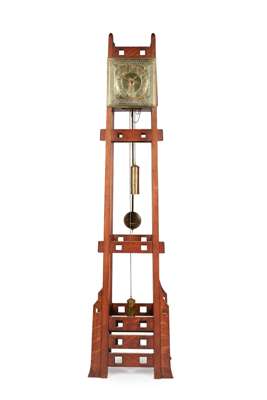
LOT 383
SCOTTISH CELTIC REVIVAL
ARTS & CRAFTS STANDING CLOCK, CIRCA 1920
SOLD FOR £2,125
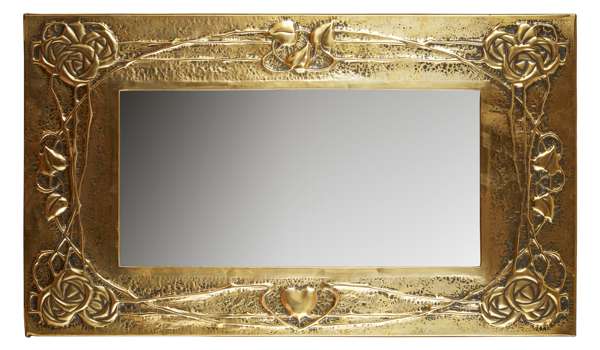
LOT 384
SCOTTISH SCHOOL, MANNER OF MARION HENDERSON WILSON
ARTS & CRAFTS MIRROR, CIRCA 1910
SOLD FOR £1,188
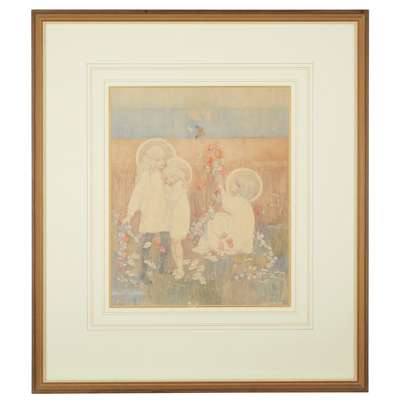
LOT 385
NORAH NEILSON-GRAY (1882-1931)
HARVEST FIELD
SOLD FOR £1,625
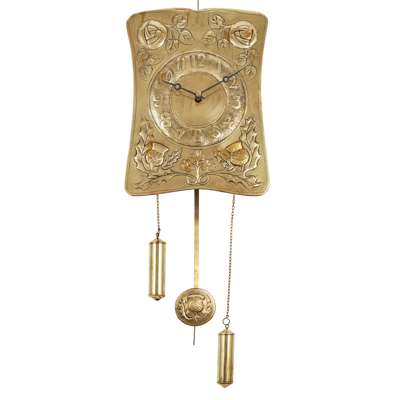
LOT 386
SCOTTISH SCHOOL
ARTS & CRAFTS BRASS WALL CLOCK, CIRCA 1900
SOLD FOR £475

LOT 387
JAMES WRIGHT (1885-1947)
CARPE DIEMS
SOLD FOR £5,500
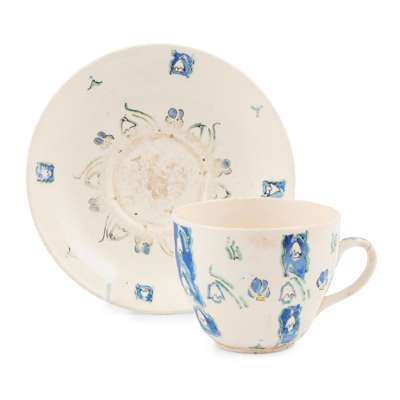
LOT 388
JESSIE MARION KING (1875-1949)
GROUP OF HAND-PAINTED CERAMICS, CIRCA 1940
SOLD FOR £300
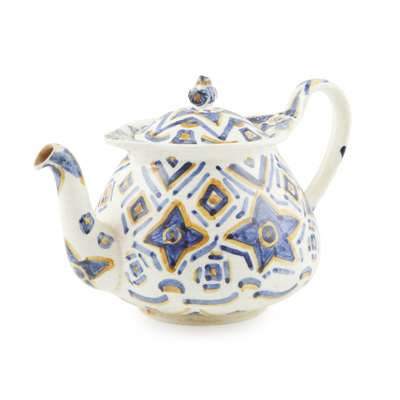
LOT 389
JESSIE MARION KING (1875-1949)
TEAPOT AND COVER, CIRCA 1940
SOLD FOR £350
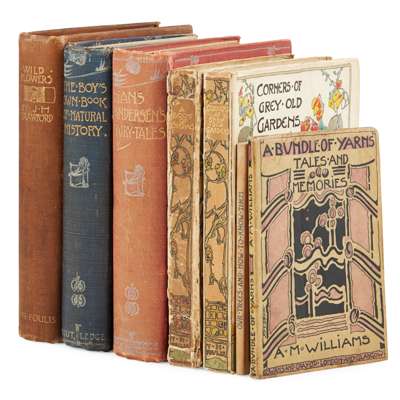
LOT 390
JESSIE MARION KING (1875 – 1949) (ILLUS.) FOR T.N. FOULIS, GOWANS & GRAY, GEO. ROUTLEDGE (PUB.)
COLLECTION OF BOOKS
SOLD FOR £875

LOT 391
JESSIE MARION KING (1875-1949)
HIGH CORRIE, ARRAN
SOLD FOR £1,000
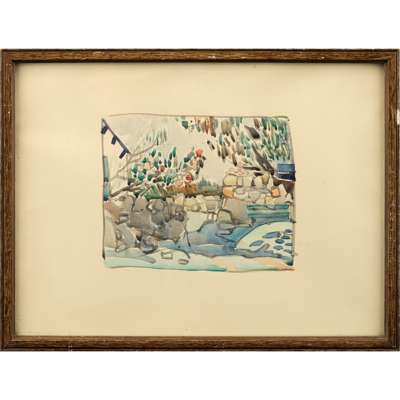
LOT 392
JESSIE MARION KING (1875-1949)
DESIGN FOR A TILE
SOLD FOR £450
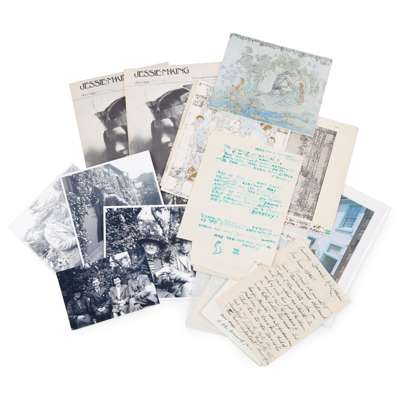
LOT 393
JESSIE MARION KING (1875 – 1949) AND ERNEST ARCHIBALD TAYLOR (1874-1951)
ARCHIVE OF CORRESPONDENCE
SOLD FOR £2,250
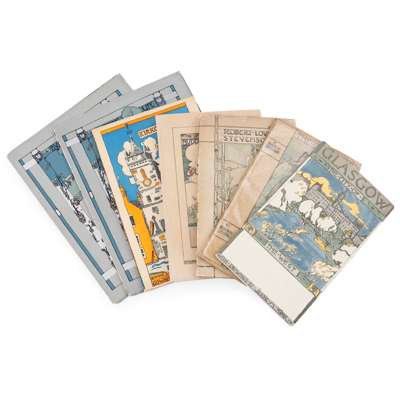
LOT 394
JESSIE MARION KING (1875 – 1949) (ILLUS.) FOR GOWANS & GRAY AND T.N. FOULIS (PUB.)
COLLECTION OF BOOKS
SOLD FOR £688

LOT 395
JESSIE MARION KING (1875-1949)
FISHER'S CLOSE
SOLD FOR £400
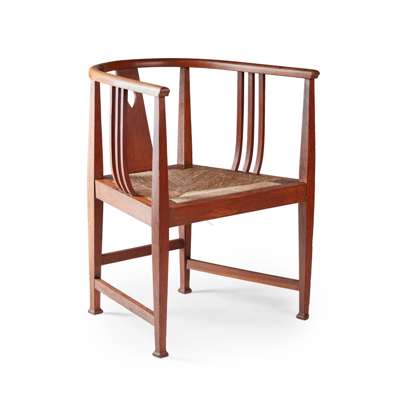
LOT 398
ATTRIBUTED TO E.A. TAYLOR FOR WYLIE & LOCHHEAD, GLASGOW
ARTS & CRAFTS OAK TUB CHAIR, CIRCA 1910
SOLD FOR £450
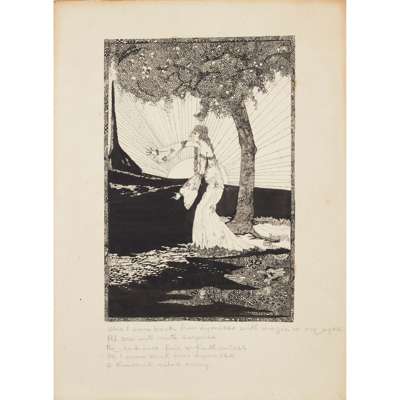
LOT 399
MANNER OF ANNIE FRENCH
'WHEN I CAME BACK FROM LYONESSE WITH MAGIC IN MY EYES...'
SOLD FOR £475
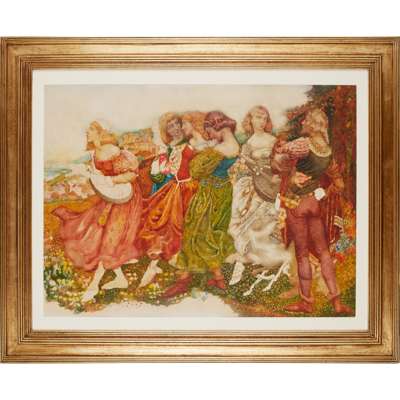
LOT 401
NOEL LAURA NISBET (1887-1956)
MEDIEVAL SCENE
SOLD FOR £1,625
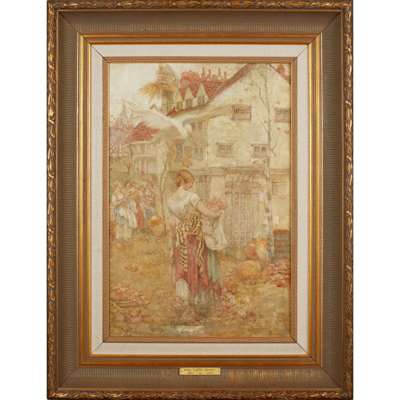
LOT 402
NOEL LAURA NISBET (1887-1956)
THE NEW ARRIVAL
SOLD FOR £1,000
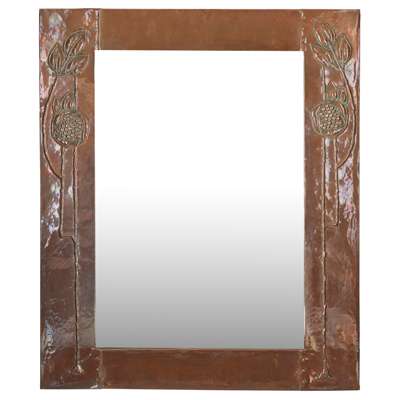
LOT 403
GLASGOW SCHOOL
ARTS & CRAFTS COPPER WALL MIRROR, CIRCA 1900
SOLD FOR £750
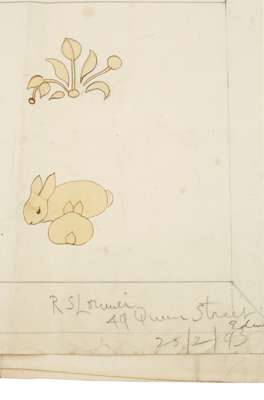
LOT 404
SIR ROBERT LORIMER (1864-1929)
DRAWINGS OF MARQUETRY DESIGNS, PLANT AND ANIMAL STUDIES, EARLY 20TH CENTURY
SOLD FOR £813
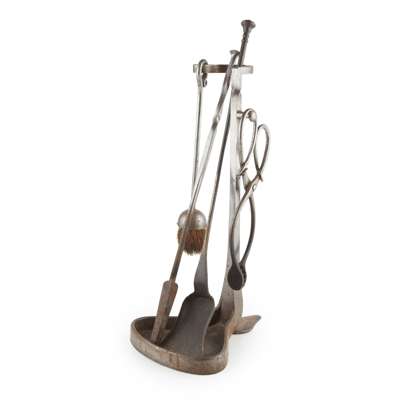
LOT 405
SIR ROBERT LORIMER (DESIGNER), THOMAS HADDEN (MAKER)
ARTS & CRAFTS STEEL FIRETOOL SET, CIRCA 1920
SOLD FOR £2,000
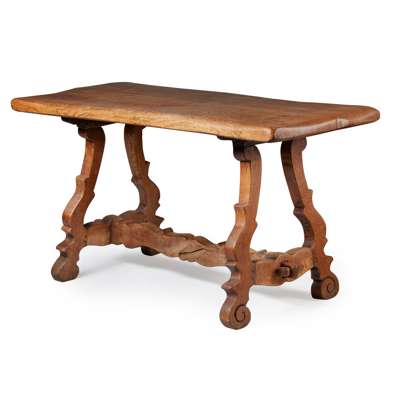
LOT 406
MANNER OF SIR ROBERT LORIMER
ARTS & CRAFTS OAK CENTRE TABLE, CIRCA 1910
SOLD FOR £813
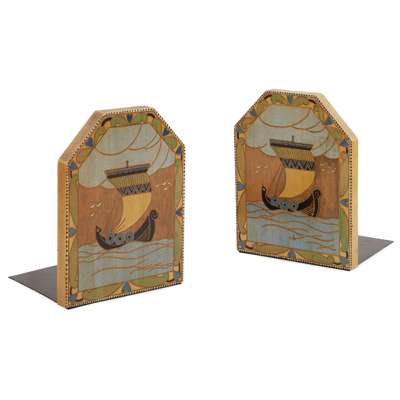
LOT 407
WILLIAM MILES JOHNSTON (1893-1974)
PAIR OF BOOKENDS, CIRCA 1940
SOLD FOR £500
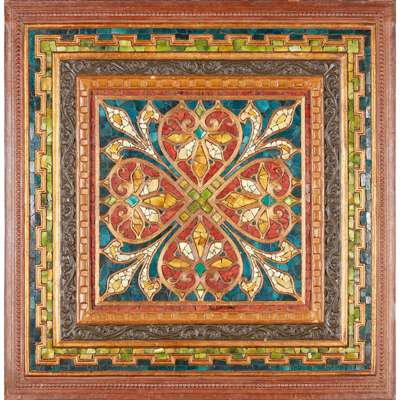
LOT 410
ATTRIBUTED TO WILLIAM SCOTT MORTON & CO., EDINBURGH
ARTS & CRAFTS 'TYNECASTLE TAPESTRY' MOSAIC PANEL, CIRCA 1900
SOLD FOR £1,000
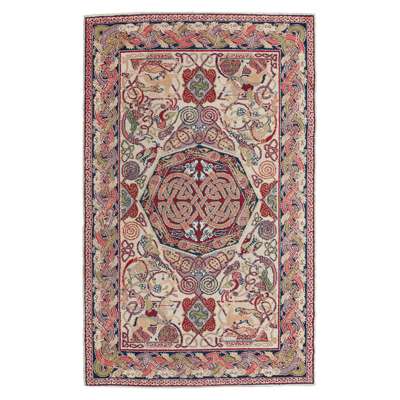
LOT 411
GEORGE BAIN (1881-1968) FOR QUAYLE & TRANTER LTD., KIDDERMINSTER
SMALL CELTIC 'HUNTING' WOOL RUG, CIRCA 1948
SOLD FOR £813
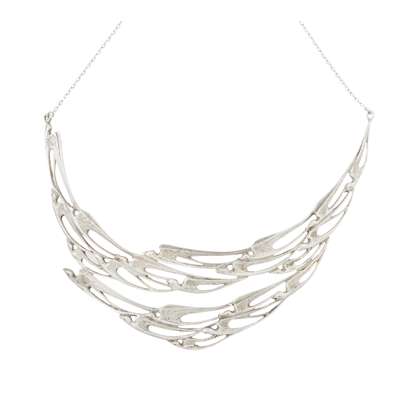
LOT 413
AFTER PETER WYLIE DAVIDSON
GLASGOW STYLE SILVER ‘SWALLOWS’ NECKLACE, 1975
SOLD FOR £425
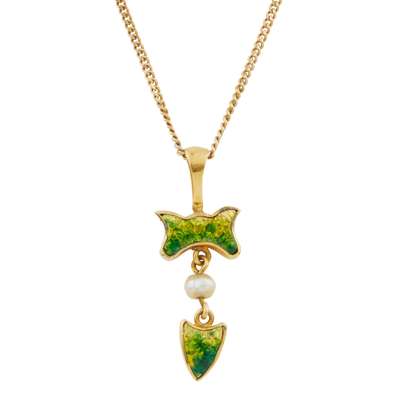
LOT 414
JAMES CROMAR WATT (1862-1940)
GOLD & ENAMEL PENDANT, CIRCA 1905
SOLD FOR £500
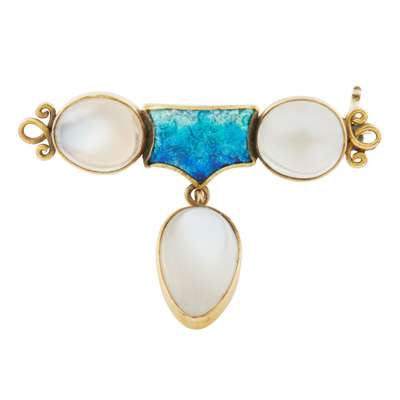
LOT 415
JAMES CROMAR WATT (1862-1940)
MOONSTONE, ENAMEL & GOLD BROOCH, CIRCA 1905
SOLD FOR £688
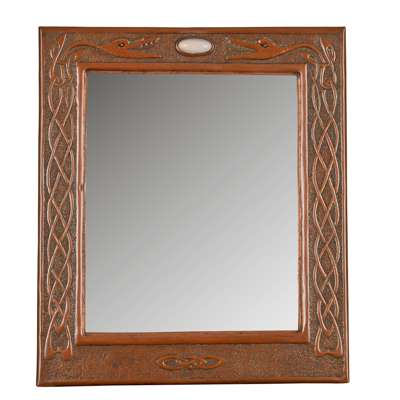
LOT 416
SCOTTISH SCHOOL
CELTIC REVIVAL COPPER WALL MIRROR, CIRCA 1900
SOLD FOR £750

LOT 418
CECILE WALTON (1891-1956)
THE FAIRY MOTHER
SOLD FOR £450
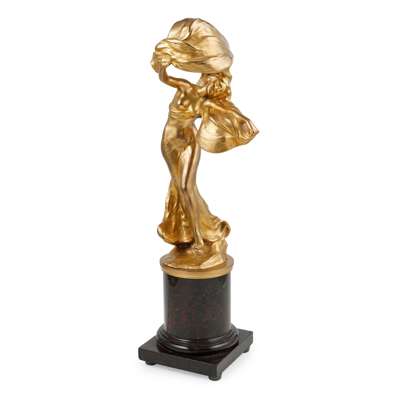
LOT 419
PETER TERESZCZUK (1875-1963)
ART NOUVEAU GILT BRONZE TABLE LAMP, CIRCA 1903
SOLD FOR £3,750
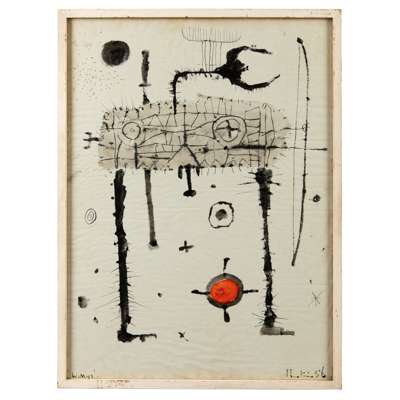
LOT 420
ALEXANDRE CLERGET (1856-1931)
PAIR OF ART NOUVEAU GILT BRONZE CANDLESTICKS, CIRCA 1900
SOLD FOR £1,875
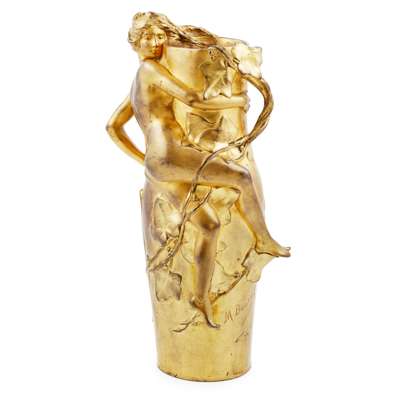
LOT 421
MAURICE BOUVAL (1863-1916)
GILT BRONZE FIGURAL VASE, CIRCA 1890
SOLD FOR £1,063
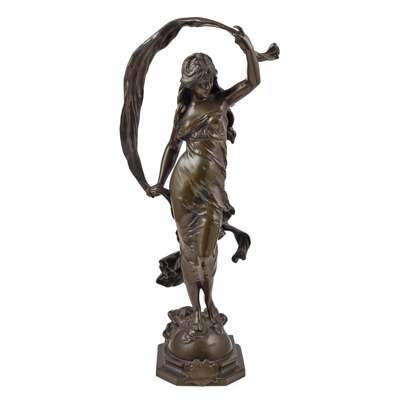
LOT 422
AUGUSTE MOREAU (1834-1917)
L’AURORE
SOLD FOR £1,625

LOT 423
EMMANUEL VILLANIS (1858-1914)
LUCRECE
SOLD FOR £575
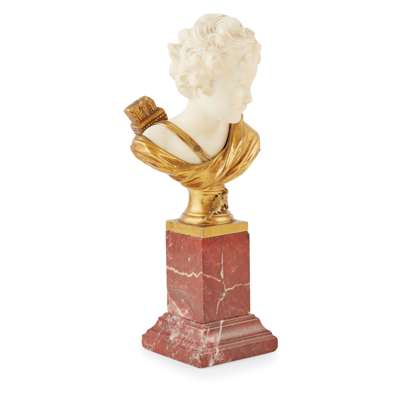
LOT 424
AGATHON LÉONARD (1841-1923)
BUST OF CUPID, CIRCA 1900
SOLD FOR £625
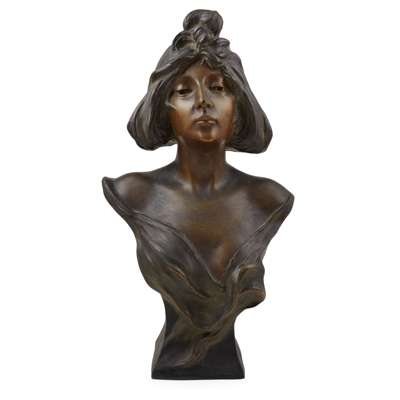
LOT 425
FRENCH SCHOOL, MANNER OF EMMANUEL VILLANIS
ART NOUVEAU BUST OF A GIRL, CIRCA 1900
SOLD FOR £425
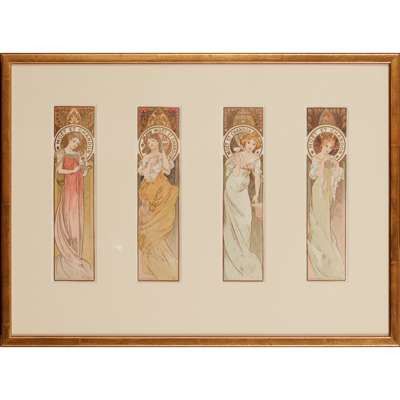
LOT 427
ALPHONSE MUCHA (1860-1939) FOR MOET & CHANDON
FOUR ORIGINAL ART NOUVEAU LITHOGRAPHIC PLATES, CIRCA 1897
SOLD FOR £1,125
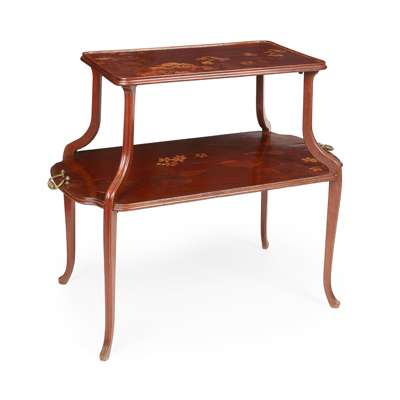
LOT 428
ATTRIBUTED TO LOUIS MAJORELLE
FRENCH ART NOUVEAU MARQUETRY INLAID ÉTAGÈRE, CIRCA 1900
SOLD FOR £1,000
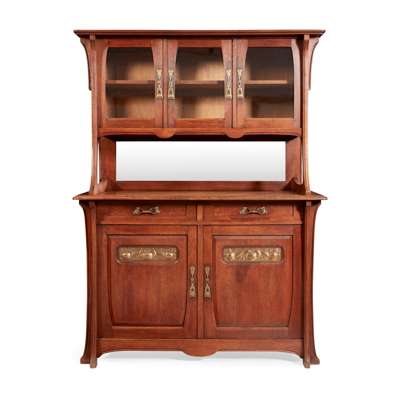
LOT 429
GEORGES-ERNEST NOWAK
FRENCH ART NOUVEAU OAK AND GILT-METAL MOUNTED SIDEBOARD CABINET, CIRCA 1900
SOLD FOR £1,250

LOT 430
FRENCH SCHOOL
FRENCH CUT PAPER PICTURE, OF FOOTBALL INTEREST, DATED 1938
SOLD FOR £400
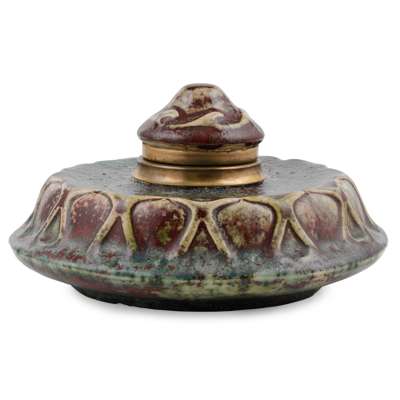
LOT 431
ADRIEN DALPAYRAT (1844-1910)
HIGH-FIRED CERAMIC INKWELL, CIRCA 1900
SOLD FOR £425

LOT 432
DOMINIQUE ALONZO (FL. 1910-1930)
GILT BRONZE AND IVORY JEWELLERY CASKET, CIRCA 1900
SOLD FOR £3,750

LOT 433
ÉMILE GALLÉ (1846-1904)
FAÏENCE FIGURE OF A PEACOCK, CIRCA 1890
SOLD FOR £475
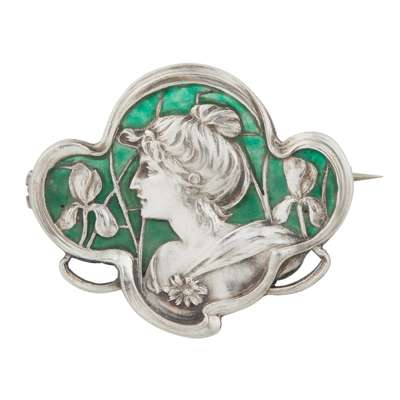
LOT 435
MEYLE & MAYER
JUGENDSTIL PLIQUE A JOUR ENAMELLED BROOCH, CIRCA 1900
SOLD FOR £1,000
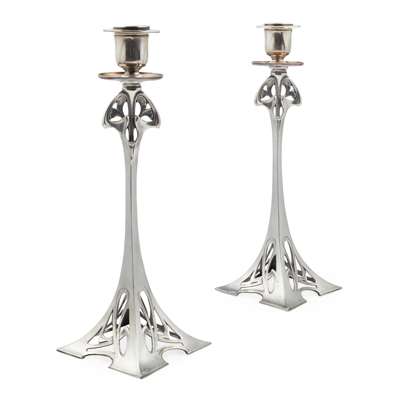
LOT 436
WMF (WÜRTTEMBERGISCHE METALLWARENFABRIK)
PAIR OF JUGENDSTIL SILVER-PLATED CANDLESTICKS, CIRCA 1900
SOLD FOR £750

LOT 437
ELKINGTON & CO. (RETAILERS)
SILVER WINE COOLER, LONDON IMPORT HALLMARKS, 1902
SOLD FOR £1,750
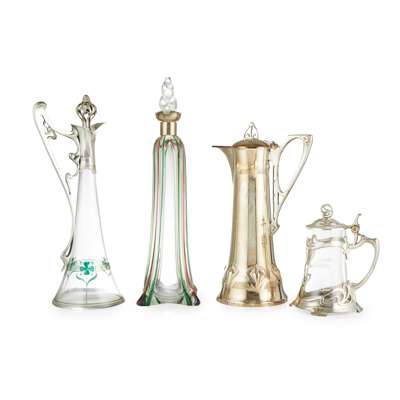
LOT 438
WMF (WURTTEMBERGISCHE METALLWARENFABRIK)
SILVER PLATED AND GLASS CLARET JUG, CIRCA 1900
SOLD FOR £938
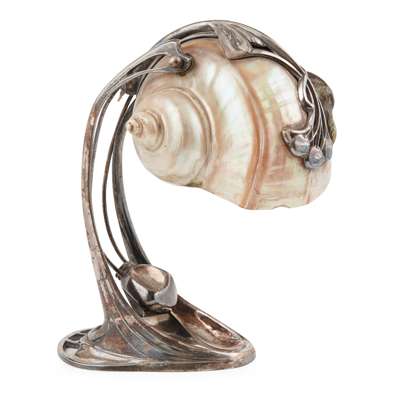
LOT 440
MORITZ HACKER (1849-1932)
JUGENDSTIL SHELL TABLE LAMP, CIRCA 1900
SOLD FOR £3,000
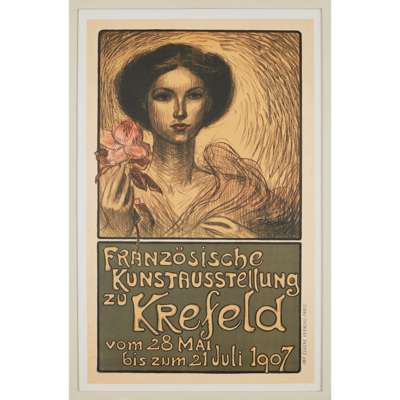
LOT 441
THEOPHILE ALEXANDRE STEINLEN (1859-1923)
POSTER: ‘FRANZÖSISCHE KUNSTAUSSTELLUNG ZU KREFELD’ 1907
SOLD FOR £875
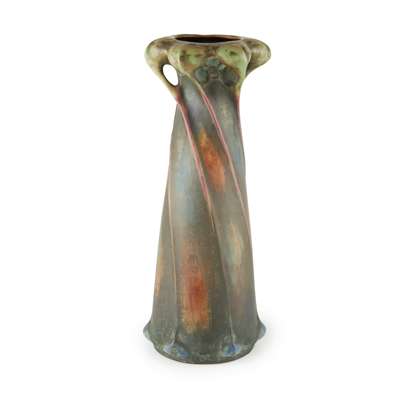
LOT 442
ATTRIBUTED TO PAUL DACHSEL FOR RIESSNER, STELLMACHER & KESSEL
ART NOUVEAU 'AMPHORA' VASE, CIRCA 1900
SOLD FOR £375
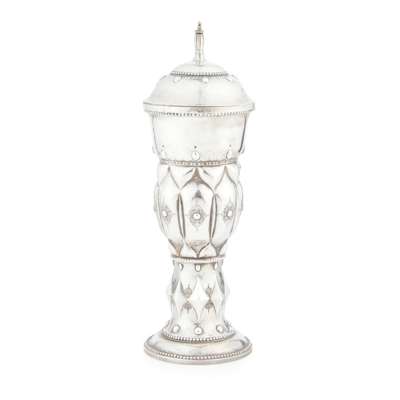
LOT 443
J. STAEHLE
ARTS & CRAFTS WHITE METAL COVERED CUP, CIRCA 1900
SOLD FOR £350
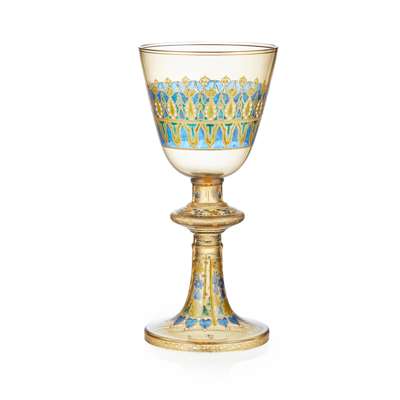
LOT 445
MANNER OF J. & L. LOBMEYR
GLASS GOBLET, LATE 19TH CENTURY
SOLD FOR £400
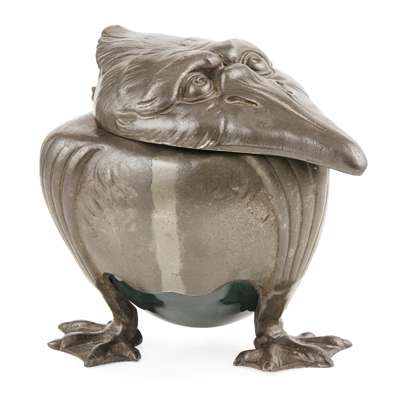
LOT 446
ATTRIBUTED TO KAYSERZINN
JUGENDSTIL PEWTER INKWELL, CIRCA 1900
SOLD FOR £688
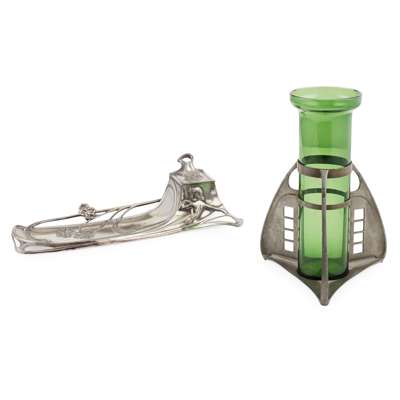
LOT 448
WALTER SCHERF & CO., NUREMBERG
'OSIRIS' FLOWER VASE, CIRCA 1900
SOLD FOR £750
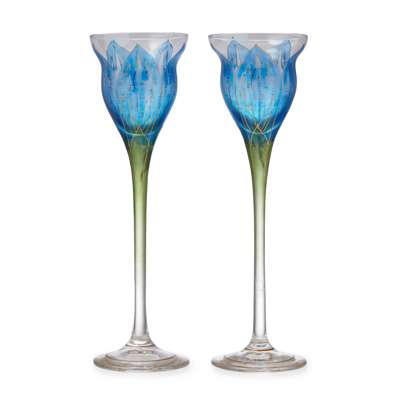
LOT 449
THERESIENTHAL
PAIR OF JUGENDSTIL 'FLOWER FORM' LIQUEUR GLASSES, CIRCA 1900
SOLD FOR £450
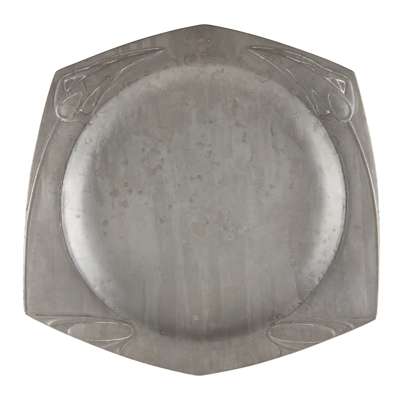
LOT 450
JOSEPH MARIA OLBRICH (1867-1908) FOR EDUARD HUECK, LÜDENSCHEID
PEWTER HEXAGONAL PLATE, CIRCA 1902
SOLD FOR £375

LOT 452
ZSOLNAY, PECS
ART NOUVEAU TILE, CIRCA 1905
SOLD FOR £525

LOT 454
HENRY VAN DE VELDE (1863-1957)
ART NOUVEAU FURNISHING FABRIC, CIRCA 1902
SOLD FOR £575
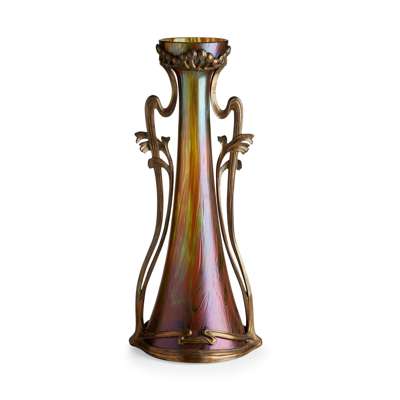
LOT 455
PALLME-KÖNIG
ART NOUVEAU IRIDESCENT GLASS VASE, CIRCA 1900
SOLD FOR £575
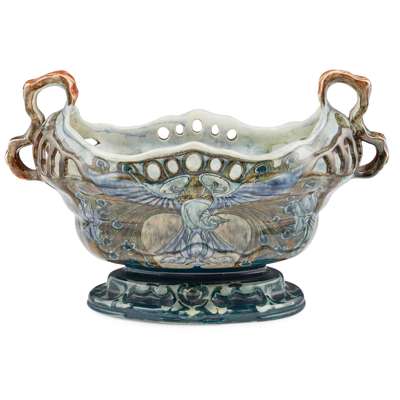
LOT 456
J.W. MIJNLIEFF (1862-1937) FOR FAYENCE EN TEGELFABRIEK, UTRECHT
ART NOUVEAU TWIN-HANDLED JARDINIÈRE, CIRCA 1900
SOLD FOR £625
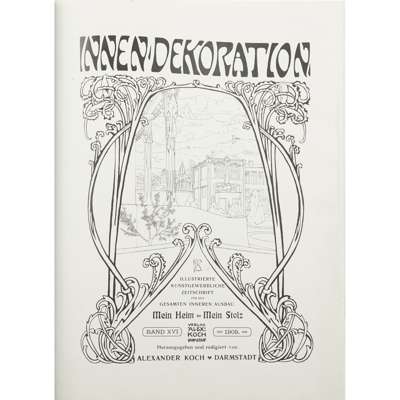
LOT 457
INNEN-DEKORATION: DIE GESAMTE WOHNUNGSKUNST IN BILD UND WORT HERAUSGEBER
TWELVE YEARBOOKS
SOLD FOR £300
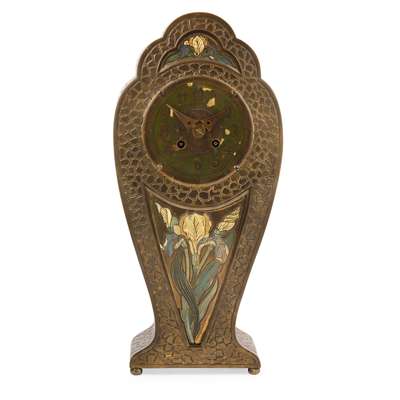
LOT 458
CONTINENTAL SCHOOL
ART NOUVEAU PATINATED BRASS AND ENAMEL MANTEL CLOCK, CIRCA 1910
SOLD FOR £688
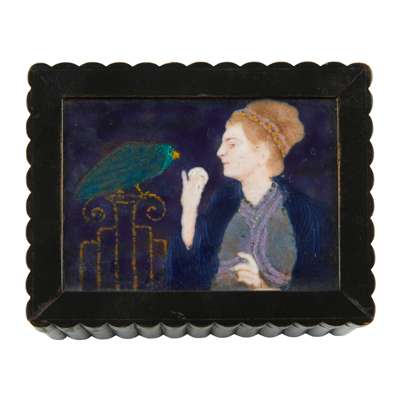
LOT 459
AUSTRIAN SECESSION
TRINKET BOX, CIRCA 1920
SOLD FOR £300
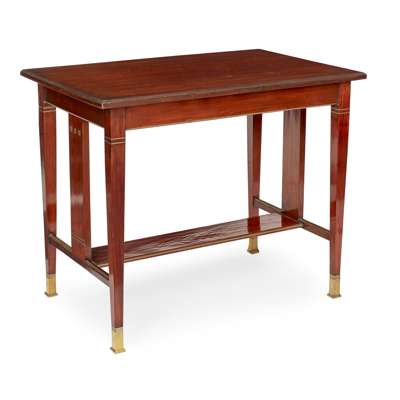
LOT 461
ATTRIBUTED TO PORTOIS & FIX., VIENNA
SECESSIONIST MAHOGANY AND BRASS MOUNTED CENTRE TABLE, CIRCA 1900
SOLD FOR £688
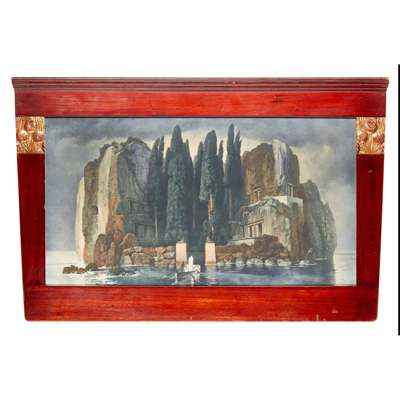
LOT 463
ARNOLD BÖCKLIN (1827–1901)
ISLE OF THE DEAD
SOLD FOR £500
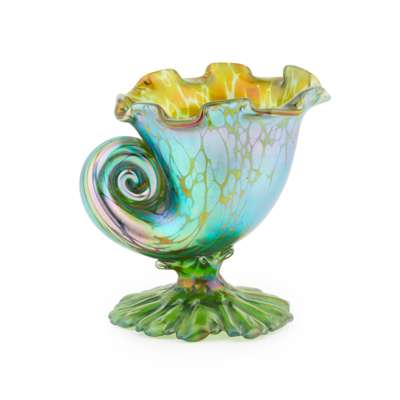
LOT 465
LOETZ, AUSTRIA
SHELL FORM VASE, CIRCA 1900
SOLD FOR £625
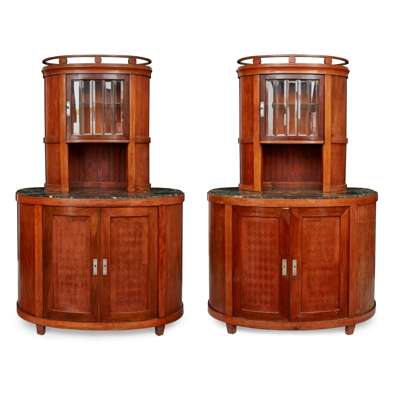
LOT 466
AUSTRIAN SCHOOL
PAIR OF SECESSIONIST INLAID WALNUT CABINETS, CIRCA 1900
SOLD FOR £1,438
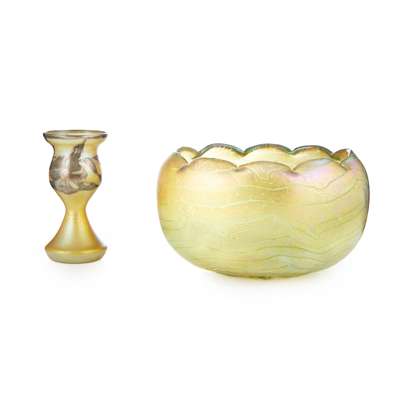
LOT 467
LOETZ, AUSTRIA
JUGENDSTIL SILVER-OVERLAID VASE, CIRCA 1900
SOLD FOR £275
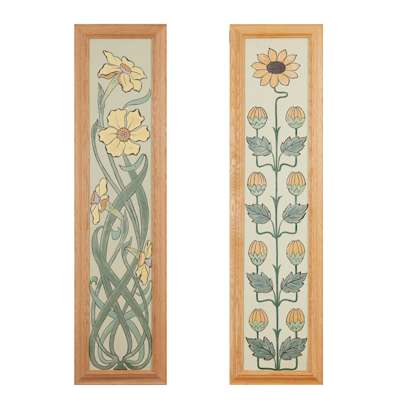
LOT 468
CONTINENTAL SCHOOL
MATCHED PAIR OF ART NOUVEAU PANELS, EARLY 20TH CENTURY
SOLD FOR £300
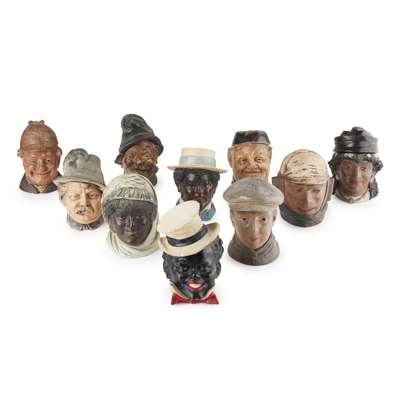
LOT 469
BERNHARD BLOCH (1836-1909) AND OTHERS
GROUP OF TERRACOTTA COVERED TOBACCO JARS, CIRCA 1900
SOLD FOR £350
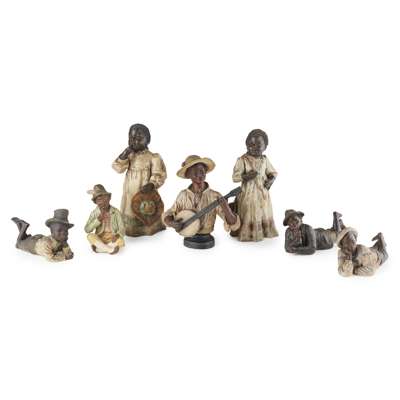
LOT 470
JOHANN MARESCH (1821-1914), BERNHARD BLOCH (1836-1909) AND OTHERS
GROUP OF TERRACOTTA FIGURES, CIRCA 1900
SOLD FOR £600
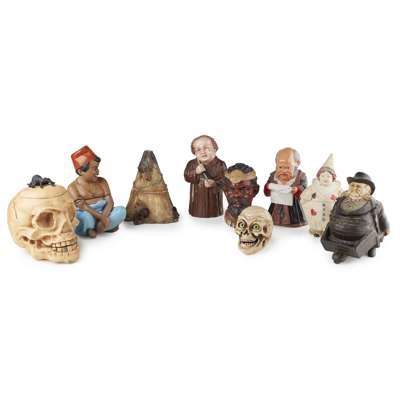
LOT 471
JOHANN MARESCH (1821-1914) AND OTHERS
GROUP OF AUSTRIAN TERRACOTTA TOBACCO JARS, CIRCA 1900
SOLD FOR £425
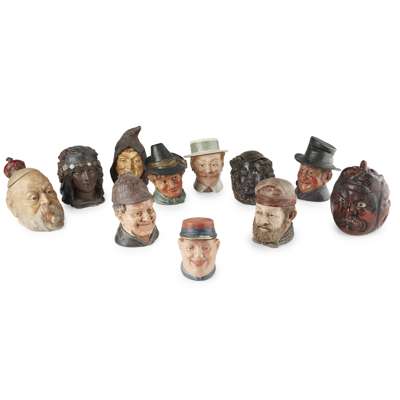
LOT 472
BERNHARD BLOCH (1836-1909) AND OTHERS
GROUP OF TERRACOTTA COVERED TOBACCO JARS, CIRCA 1900
SOLD FOR £425

LOT 473
AUSTRIAN SCHOOL
GROUP OF TERRACOTTA TOBACCO JARS, CIRCA 1900
SOLD FOR £375
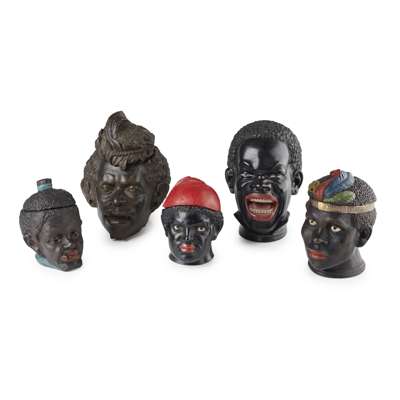
LOT 474
BERNHARD BLOCH (1836-1909) AND OTHERS
GROUP OF TERRACOTTA COVERED TOBACCO JARS, CIRCA 1900
SOLD FOR £275
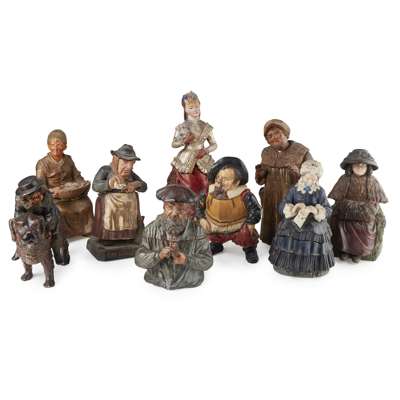
LOT 475
BERNHARD BLOCH (1836-1909) AND OTHERS
GROUP OF AUSTRIAN TERRACOTTA TOBACCO JARS, CIRCA 1900
SOLD FOR £1,000
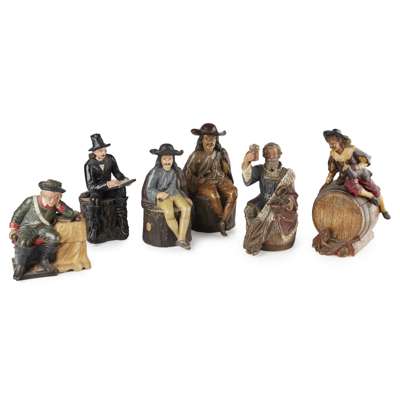
LOT 476
BERNHARD BLOCH (1836-1909) AND OTHERS
GROUP OF FIGURAL TERRACOTTA TOBACCO JARS, CIRCA 1900
SOLD FOR £575
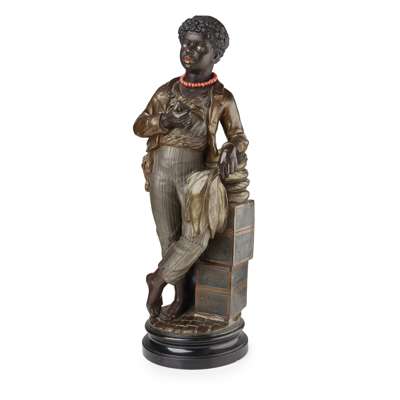
LOT 477
J. UFFRECHT & CO., GERMANY
GERMAN TERRACOTTA FIGURE, CIRCA 1900
SOLD FOR £400
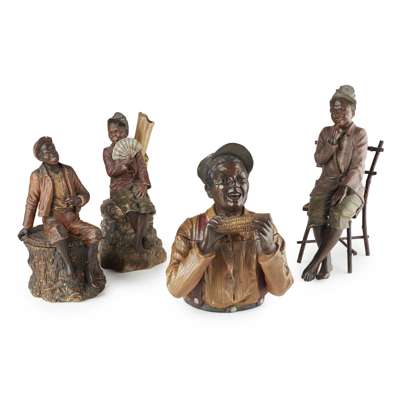
LOT 478
JOHANN MARESCH (1821-1914), BERNHARD BLOCH (1836-1909) AND OTHERS
GROUP OF AUSTRIAN TERRACOTTA TOBACCO JARS, CIRCA 1890-1900
SOLD FOR £813
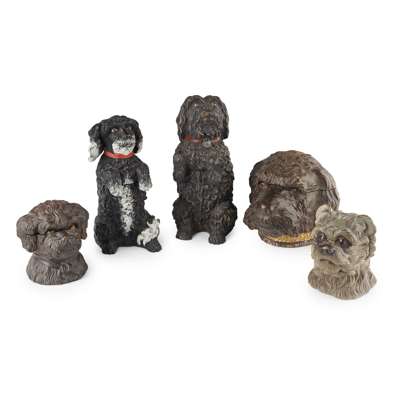
LOT 479
WILHELM SCHILLER & SONS AND OTHERS, CIRCA 1900
FIVE TERRACOTTA TOBACCO JARS, CIRCA 1900
SOLD FOR £300
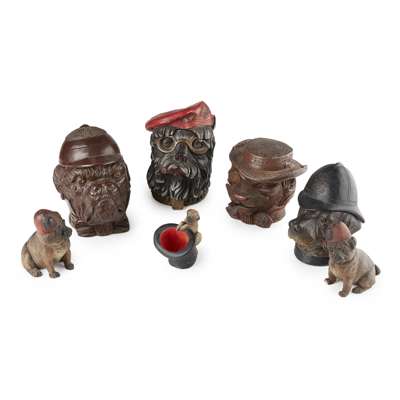
LOT 480
BERNHARD BLOCH (1836-1909) AND OTHERS
GROUP OF AUSTRIAN TERRACOTTA TOBACCO JARS AND FIGURES, CIRCA 1900
SOLD FOR £325
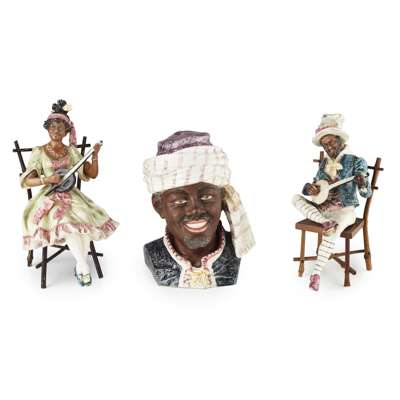
LOT 481
AUSTRIAN SCHOOL
GROUP OF CHARACTER WARES, CIRCA 1900
SOLD FOR £300
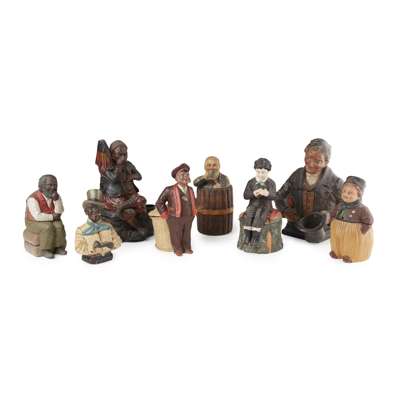
LOT 482
JOHANN MARESCH (1821-1914), BERNHARD BLOCH (1836-1909) AND OTHERS
EIGHT TERRACOTTA TOBACCO JARS, CIRCA 1900
SOLD FOR £375

LOT 483
ENGLISH SCHOOL
ART DECO WALNUT DINING SUITE, CIRCA 1930
SOLD FOR £875
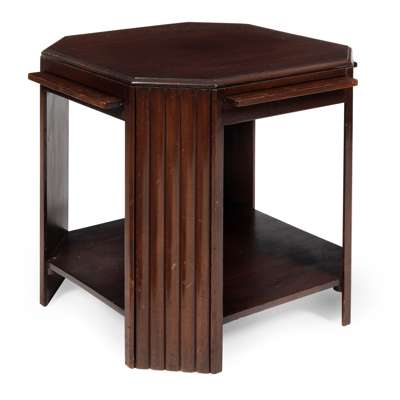
LOT 484
WYLIE & LOCHHEAD, GLASGOW
ART DECO MAHOGANY OCCASIONAL TABLE, CIRCA 1920
SOLD FOR £350

LOT 485
WYLIE & LOCHHEAD, GLASGOW
WALNUT COCKTAIL CABINET, CIRCA 1920
SOLD FOR £325
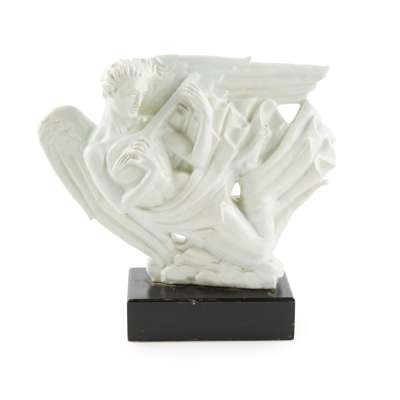
LOT 486
JOYCE BIDDER (1906-1999)
‘ZEPHYR’, CIRCA 1935
SOLD FOR £600
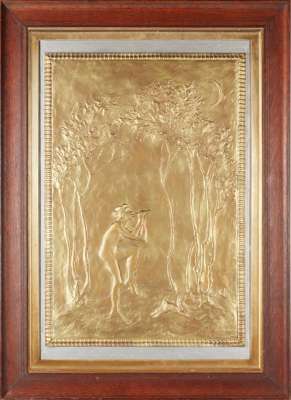
LOT 487
ROWLEY GALLERY, LONDON
ART DECO PLASTER RELIEF PANEL, CIRCA 1930
SOLD FOR £688
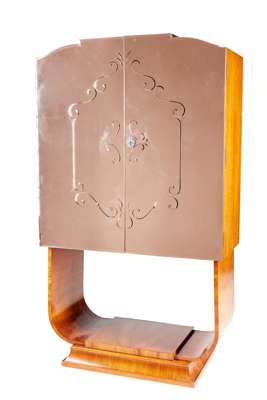
LOT 488
HILLE, LONDON
ART DECO COCKTAIL CABINET, CIRCA 1930
SOLD FOR £688
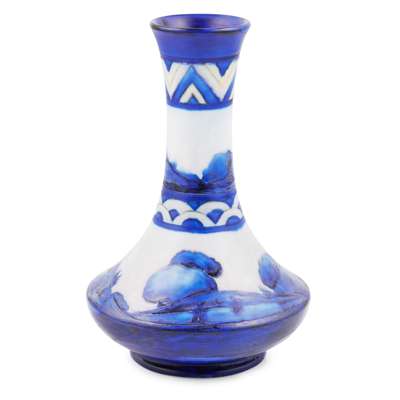
LOT 491
WILLIAM MOORCROFT (1872-1945) FOR MOORCROFT POTTERY
'DAWN LANDSCAPE' BOTTLE VASE, CIRCA 1930
SOLD FOR £688
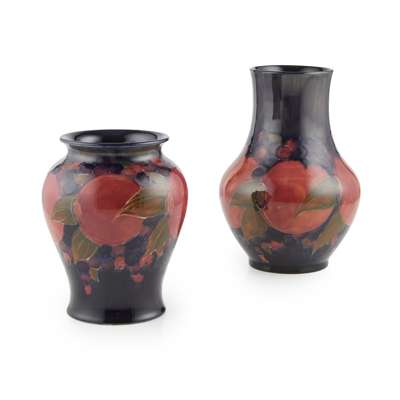
LOT 495
WILLIAM MOORCROFT (1872-1945) FOR MOORCROFT POTTERY
'POMEGRANATE' BALUSTER VASE, CIRCA 1930
SOLD FOR £425
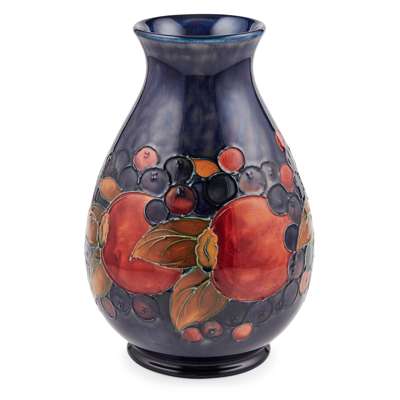
LOT 496
WILLIAM MOORCROFT (1872-1945) FOR MOORCROFT POTTERY
'POMEGRANATE' BALUSTER VASE, LATE 1930S
SOLD FOR £375
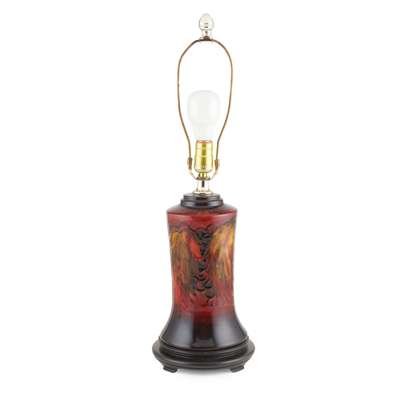
LOT 4972
MOORCROFT POTTERY
‘LEAF & BERRY’ FLAMBÉ TABLE LAMP, LATE 20TH CENTURY
SOLD FOR £300
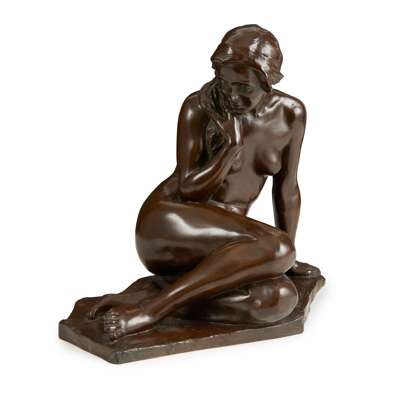
LOT 500
BENNO SCHOTZ (1891-1984)
RECLINING NUDE
SOLD FOR £3,000
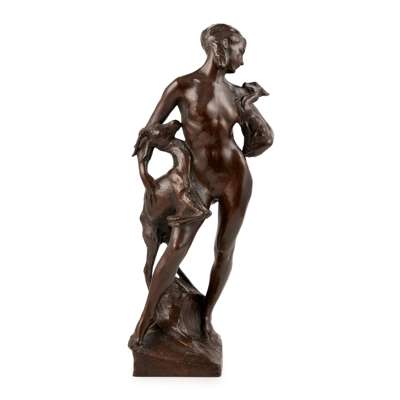
LOT 501
FERDINAND VICTOR BLUNDSTONE (1882-1951)
'THE GOATHERD'
SOLD FOR £500

LOT 503
BENNO SCHOTZ (1891-1984)
RECLINING NUDE
SOLD FOR £500

LOT 505
ATTRIBUTED TO MABEL ROYDS
FOUR FIGURAL STUDIES
SOLD FOR £375
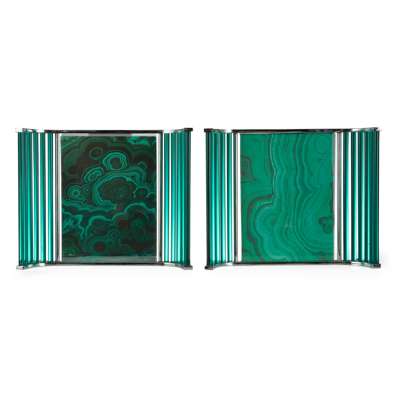
LOT 506
ENGLISH SCHOOL, ATTRIBUTED TO HARRODS LTD., LONDON
PAIR OF CHROMIUM AND GLASS ART DECO PHOTOGRAPH FRAMES, CIRCA 1930
SOLD FOR £525
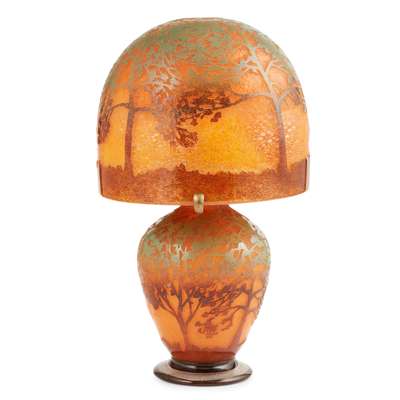
LOT 507
JOHN MONCRIEFF LTD., PERTH
RARE 'MONART' CAMEO GLASS LAMP, CIRCA 1930
SOLD FOR £2,125
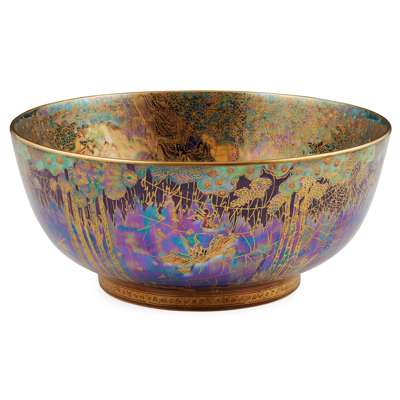
LOT 508
DAISY MAKEIG-JONES (1881–1945) FOR WEDGWOOD
'FAIRYLAND LUSTRE' IMPERIAL BOWL, CIRCA 1925
SOLD FOR £1,000
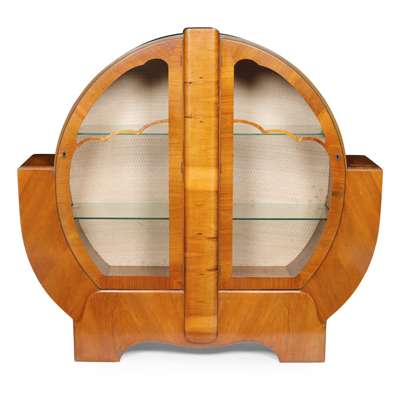
LOT 509
ENGLISH SCHOOL
ART DECO WALNUT DISPLAY CASE, CIRCA 1920
SOLD FOR £400
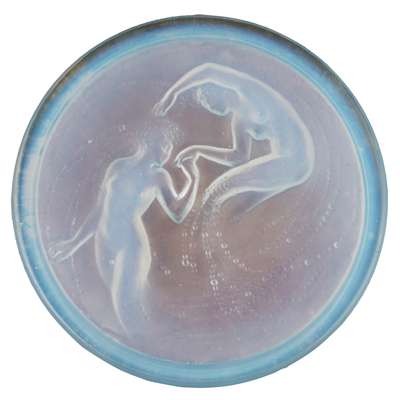
LOT 514
RENÉ LALIQUE (1860-1945)
'CHEVALIER D'ORSAY' OPALESCENT GLASS POWDER BOX, DESIGNED 1920
SOLD FOR £813

LOT 515
RENÉ LALIQUE (1860-1945)
'PRIMEVERES' NO. 77 OPALESCENT GLASS COVERED BOWL, DESIGNED 1927
SOLD FOR £1,750
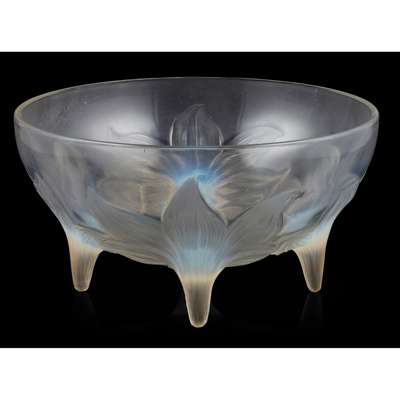
LOT 516
RENÉ LALIQUE (1860-1945)
'LYS' NO. 382 OPALESCENT GLASS BOWL, DESIGNED 1924
SOLD FOR £688
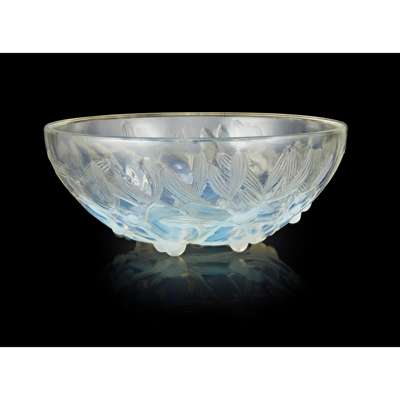
LOT 517
RENÉ LALIQUE (1860-1945)
'GUI NO.1' NO. 3223 OPALESCENT GLASS BOWL, DESIGNED 1921
SOLD FOR £600
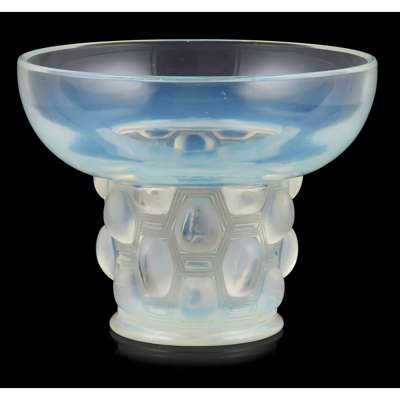
LOT 518
RENÉ LALIQUE (1860-1945)
'BEAUTREILLIS' NO. 989 OPALESCENT GLASS VASE, DESIGNED 1927
SOLD FOR £1,000
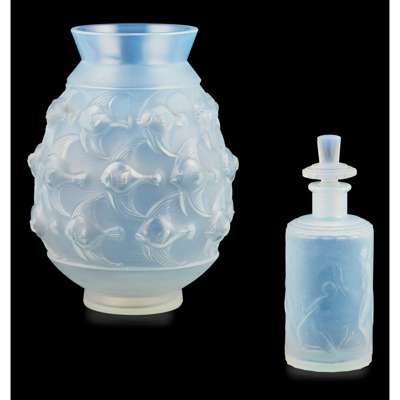
LOT 519
SABINO, PARIS
ART DECO OPALESCENT GLASS VASE, CIRCA 1925
SOLD FOR £500
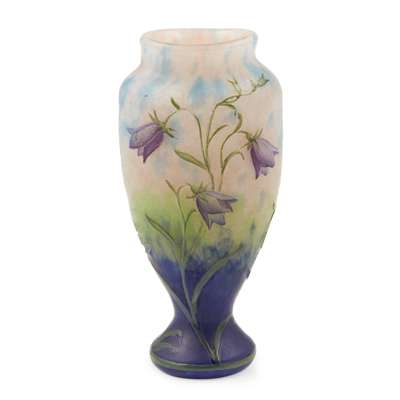
LOT 521
DAUM FRÈRES, NANCY
PAINTED CAMEO GLASS VASE, CIRCA 1900
SOLD FOR £1,750
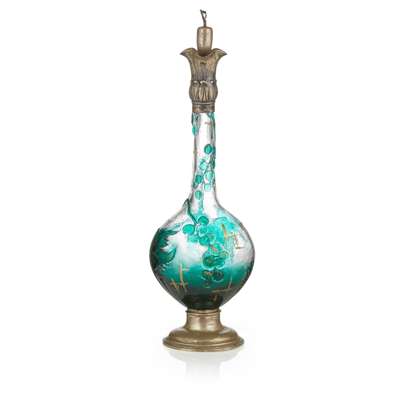
LOT 522
ÉMILE GALLÉ (1846-1904)
ART NOUVEAU DECANTER & STOPPER, CIRCA 1900
SOLD FOR £2,000

LOT 523
ANDRÉ GROULT (1884-1966)
PAINTED SIDE CHAIR, CIRCA 1911
SOLD FOR £2,250
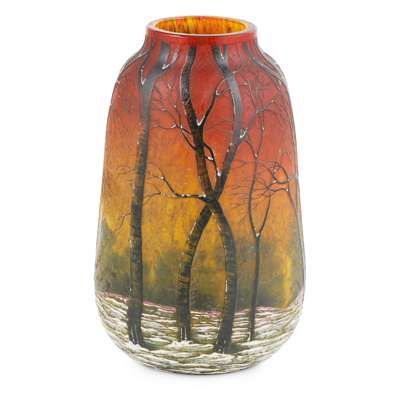
LOT 524
FRENCH SCHOOL, MANNER OF DAUM, NANCY
CAMEO GLASS VASE, 20TH CENTURY
SOLD FOR £450
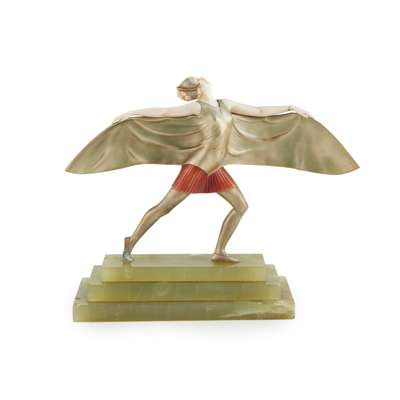
LOT 525
FERDINAND PREISS (1882-1943)
'BAT GIRL' ART DECO FIGURE, CIRCA 1925
SOLD FOR £10,625
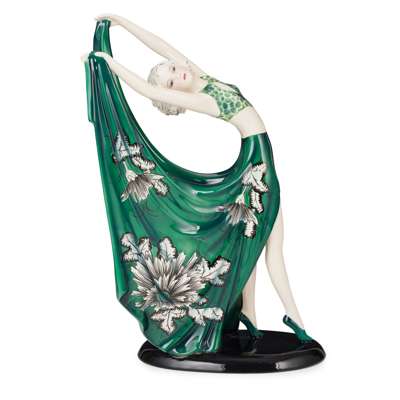
LOT 526
STEFAN DAKON (1904–1992) FOR GOLDSCHEIDER, AUSTRIA
ART DECO CERAMIC FIGURE OF A DANCER, CIRCA 1925
SOLD FOR £1,125
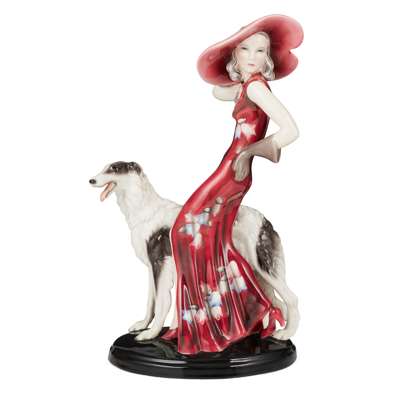
LOT 527
CLAIRE WEISS (1906-1997) FOR GOLDSCHEIDER, AUSTRIA
ART DECO CERAMIC FIGURE OF A WOMAN, CIRCA 1925
SOLD FOR £1,500
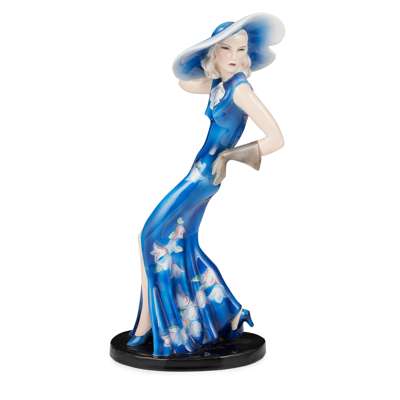
LOT 528
GOLDSCHEIDER, AUSTRIA
ART DECO CERAMIC FIGURE OF A LADY, CIRCA 1925
SOLD FOR £1,250

LOT 529
LOETZ, AUSTRIA
'RICHARD' CAMEO GLASS TABLE LAMP, CIRCA 1920
SOLD FOR £938
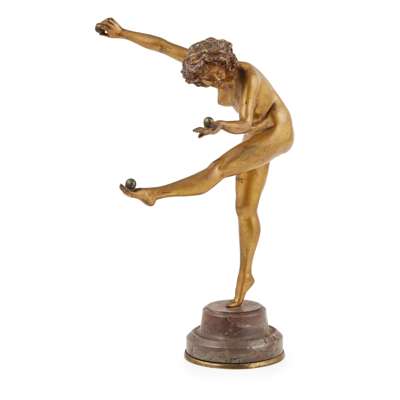
LOT 530
C.J.R. COLINET (1885-1948)
THE JUGGLER
SOLD FOR £750
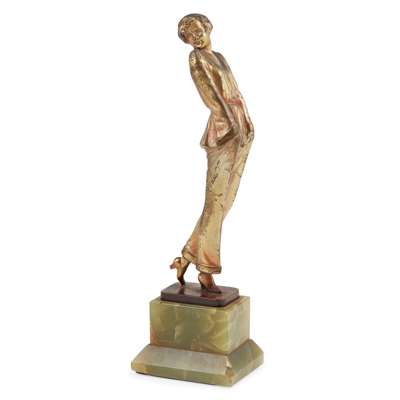
LOT 531
JOSEF LORENZL (1892-1950)
ART DECO FIGURE, CIRCA 1925
SOLD FOR £1,000
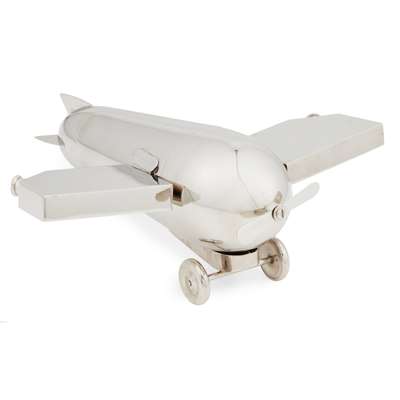
LOT 532
J. A. HENCKELS, GERMANY
CHROMIUM PLATED 'AEROPLANE' COCKTAIL SHAKER AND BAR, CIRCA 1930
SOLD FOR £15,625
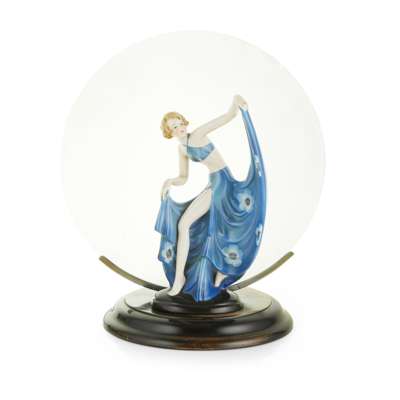
LOT 533
KATZHÜTTE (PORZELLANFABRIK HERTWIG & CO.)
ART DECO FIGURAL LAMP, CIRCA 1925
SOLD FOR £275
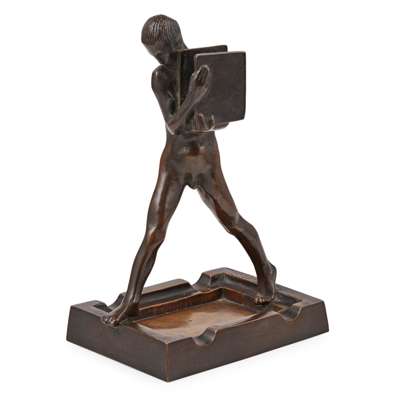
LOT 534
JOSEF CANTRE (1890 - 1957)
BRONZE VESTA, 20TH CENTURY
SOLD FOR £688
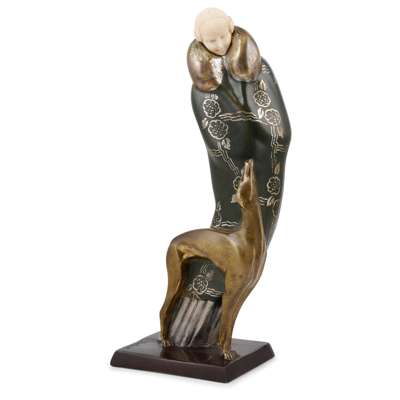
LOT 535
SOLANGE BERTRAND (1913-2011)
'ELÉGANTE AU LEVRIER', ART DECO BRONZE AND IVORY FIGURE, CIRCA 1925
SOLD FOR £2,500

LOT 536
FRENCH SCHOOL
ART DECO FRUITWOOD OCCASIONAL TABLE, CIRCA 1930
SOLD FOR £550
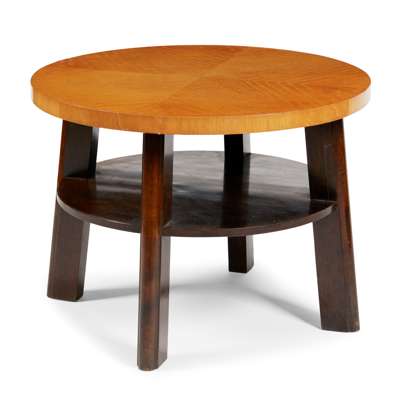
LOT 537
MANNER OF GRETA MAGNUSSON-GROSSMAN
ASH VENEERED AND STAINED BEECH OCCASIONAL TABLE, MID-20TH CENTURY
SOLD FOR £350
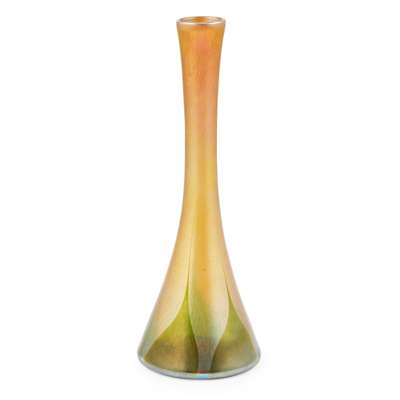
LOT 538
TIFFANY STUDIOS, NEW YORK
IRIDESCENT 'FAVRILE' GLASS BOTTLE VASE, CIRCA 1910
SOLD FOR £813
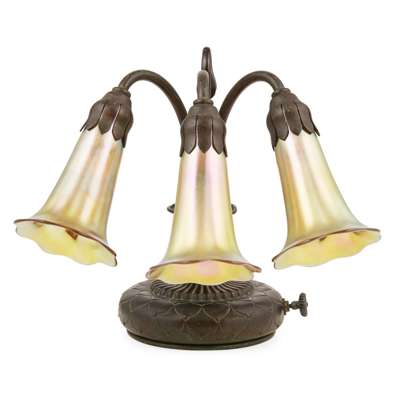
LOT 539
TIFFANY STUDIOS, NEW YORK
THREE-LIGHT ‘LILY’ PIANO LAMP, CIRCA 1910
SOLD FOR £3,500
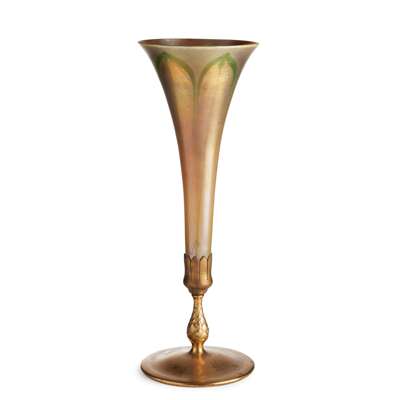
LOT 541
TIFFANY STUDIOS, NEW YORK
MOUNTED IRIDESCENT 'FAVRILE' GLASS TRUMPET VASE, CIRCA 1910
SOLD FOR £875
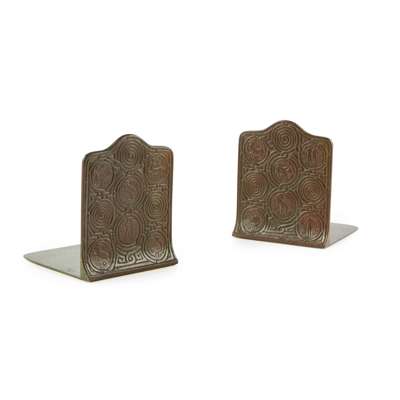
LOT 542
TIFFANY STUDIOS, NEW YORK
PAIR OF BRONZE 'ZODIAC' BOOKENDS, CIRCA 1920
SOLD FOR £500
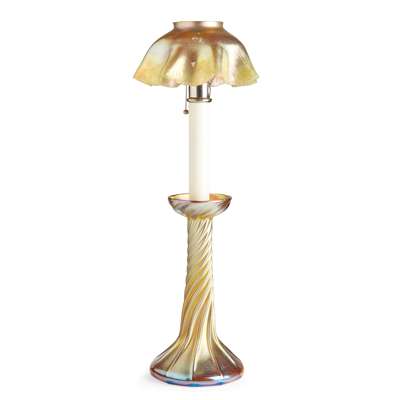
LOT 543
TIFFANY STUDIOS, NEW YORK
IRIDESCENT 'FAVRILE' GLASS CANDLE LAMP & SHADE, CIRCA 1910
SOLD FOR £400
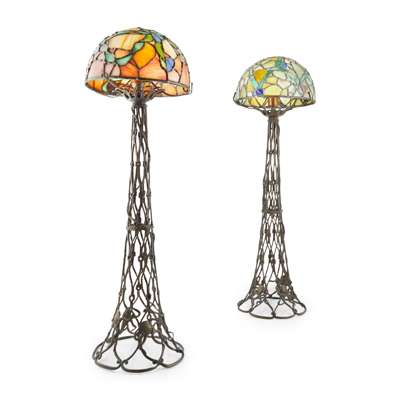
LOT 544
AMERICAN SCHOOL
PAIR OF PATINATED BRASS TABLE LAMPS, 20TH CENTURY
SOLD FOR £500
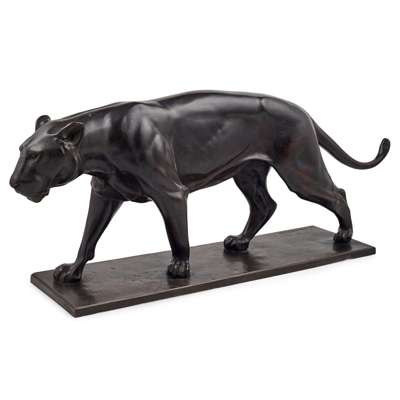
LOT 546
CHRISTIAN AECKERLIN (1884–1943)
LEOPARD, CIRCA 1930
SOLD FOR £2,125

LOT 547
CARL MILLES (1875-1955)
STRUGGLE FOR EXISTENCE
SOLD FOR £2,000
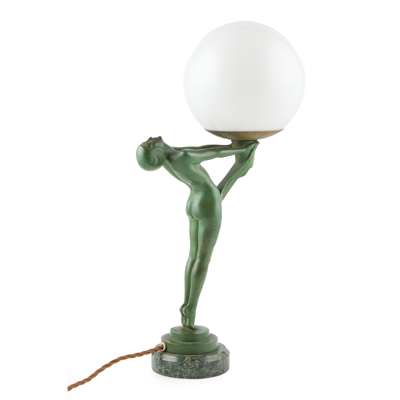
LOT 548
MAX LE VERRIER (1891-1973)
ART DECO PATINATED BRONZE FIGURAL TABLE LAMP, CIRCA 1930
SOLD FOR £2,375
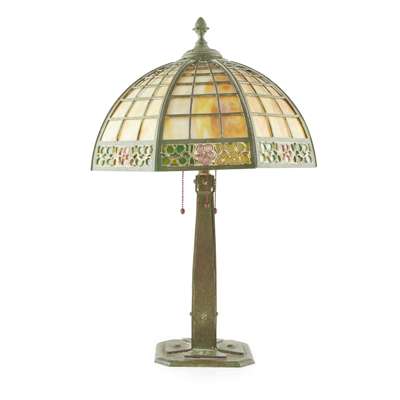
LOT 549
AMERICAN SCHOOL, MANNER OF HANDEL LAMP COMPANY
TABLE LAMP, CIRCA 1910
SOLD FOR £400

LOT 550
AMSTERDAM SCHOOL
INLAID OAK GAMES TABLE, CIRCA 1910
SOLD FOR £525
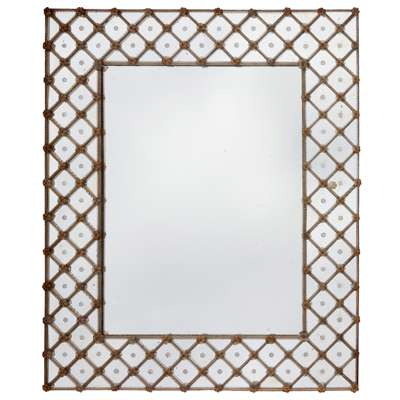
LOT 551
MURANO, ITALY
WALL MIRROR, CIRCA 1935
SOLD FOR £4,000
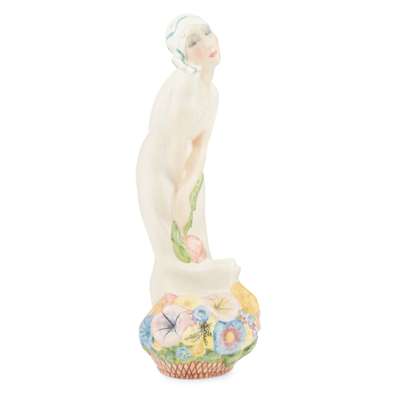
LOT 552
IGNI, TORINO
ART DECO CERAMIC FIGURE OF A WOMAN, CIRCA 1930
SOLD FOR £350
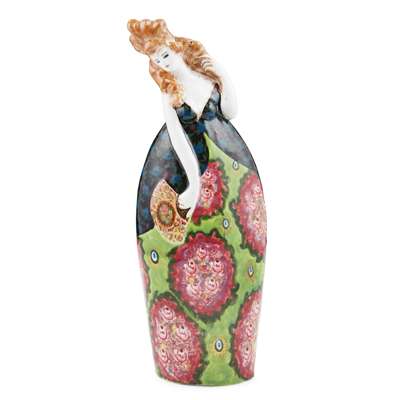
LOT 553
FRANCESCO NONNI (1885-1976) FOR MELANDRI E FOCACCIA, FAENZA
LADY WITH FAN, CIRCA 1920
SOLD FOR £1,125
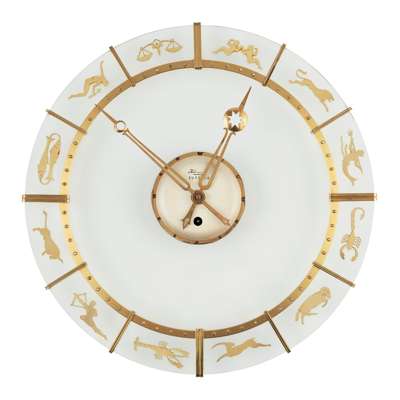
LOT 556
HEINRICH JOHANNES MÖLLER (1905-1983) FOR KIENZLE, GERMANY
ZODIAC WALL CLOCK
SOLD FOR £1,000

LOT 558
AXEL SALTO (1889-1961) FOR ROYAL COPENHAGEN
RIBBED BOWL, CIRCA 1975
SOLD FOR £813
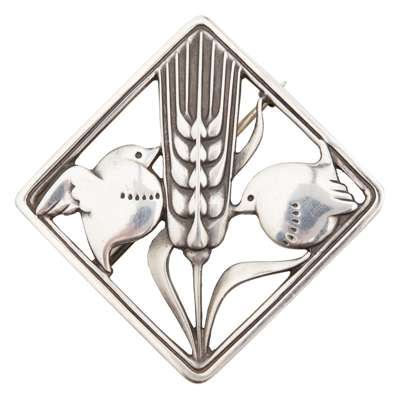
LOT 561
ARNO MALINOWSKI (1899-1976) FOR GEORG JENSEN
STERLING SILVER BROOCH, MARKS FOR 1933-1944
SOLD FOR £1,000

LOT 562
GEORG JENSEN (1866-1935)
SILVER AND AMBER BROOCH, MARKS FOR 1933-44
SOLD FOR £450
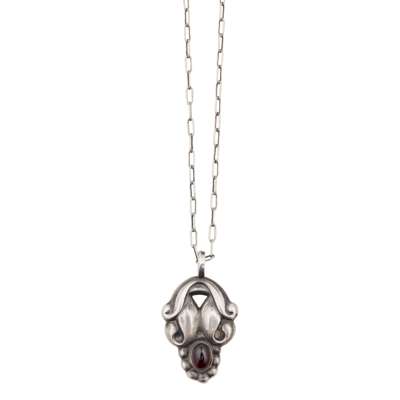
LOT 563
GEORG JENSEN (1866-1935)
SILVER PENDANT NECKLACE, POST 1945
SOLD FOR £275
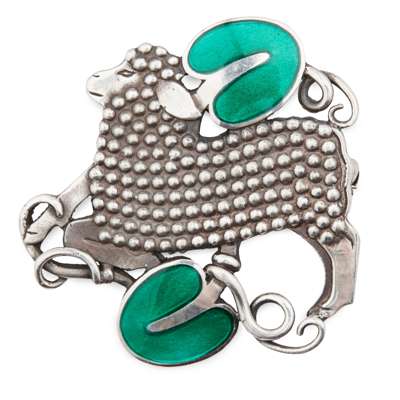
LOT 564
ARNO MALINOWSKI (1899-1976) FOR GEORG JENSEN
SILVER AND ENAMEL BROOCH, MARKS FOR 1933-44
SOLD FOR £380
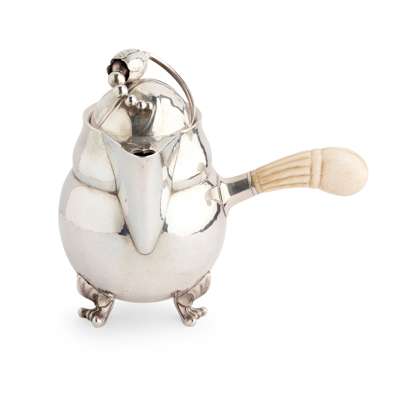
LOT 565
GEORG JENSEN (1866-1935)
SILVER & IVORY MOUNTED 'MAGNOLIA BLOSSOM' HOT MILK POT AND COVER, DESIGNED 1905
SOLD FOR £1,750
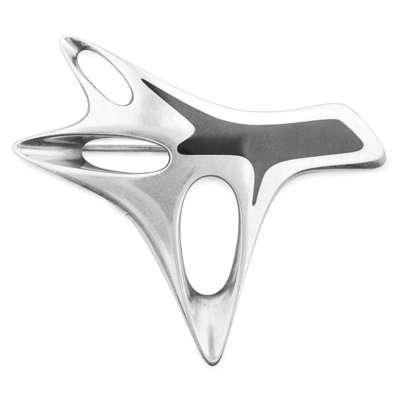
LOT 566
HENNING KOPPEL (1918-1981) FOR GEORG JENSEN
AMORPHIC STERLING AND ENAMELLED BROOCH, DESIGNED 1956
SOLD FOR £400
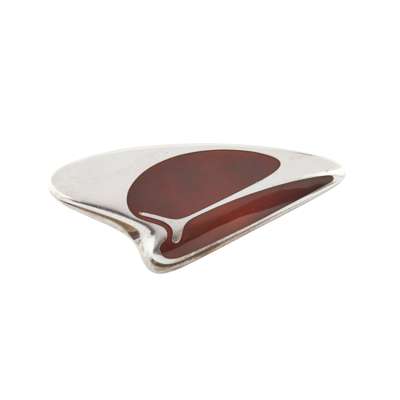
LOT 567
HENNING KOPPEL (1918-1981) FOR GEORG JENSEN
AMORPHIC STERLING AND ENAMELLED BROOCH, NO. 314, CIRCA 1964
SOLD FOR £475
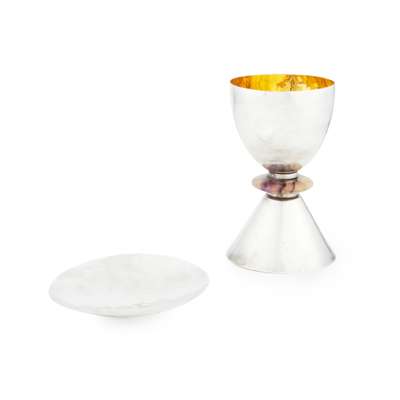
LOT 568
CONTEMPORARY BRITISH SCHOOL
SILVER GILT CHALICE & COVER, LONDON 1965
SOLD FOR £425
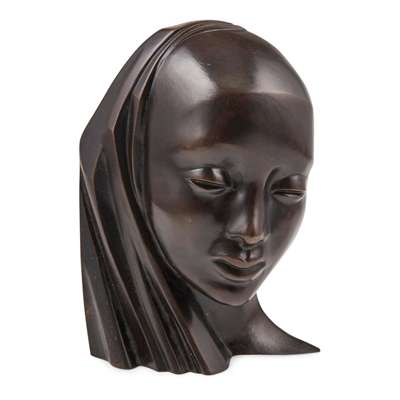
LOT 5692
HAGENAUER, VIENNA
BRONZE BUST, CIRCA 1950
SOLD FOR £688
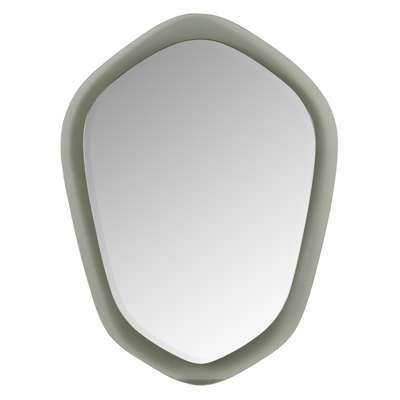
LOT 5702
ATTRIBUTED TO FONTANA ARTE
WALL MIRROR, MID-20TH CENTURY
SOLD FOR £350
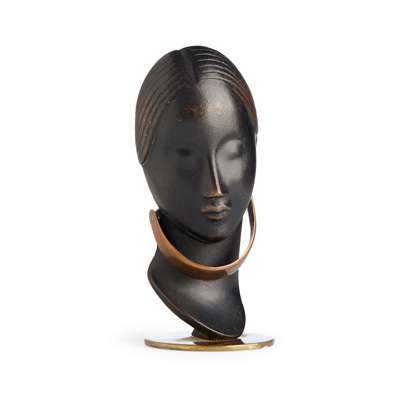
LOT 571
HAGENAUER, AUSTRIA
BRONZE BUST, CIRCA 1920
SOLD FOR £400
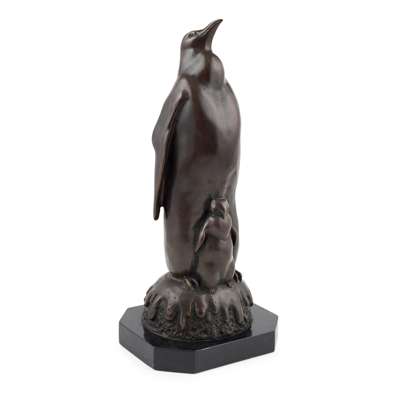
LOT 572
CONTEMPORARY
BRONZE FIGURE GROUP OF PENGUINS, DATED 1973
SOLD FOR £750
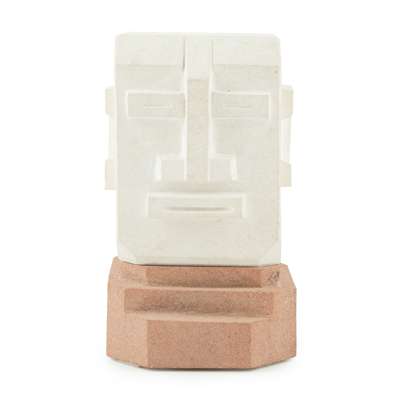
LOT 5732
ATTRIBUTED TO GEORGE INNES
STONE SCULPTURE OF A HEAD, 20TH CENTURY
SOLD FOR £300
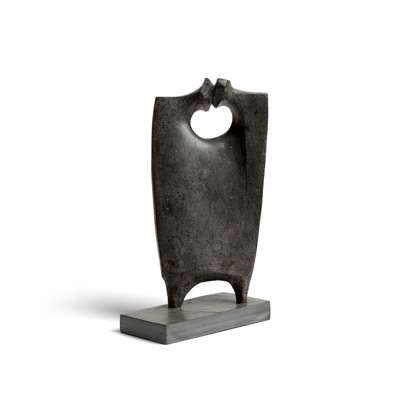
LOT 574
STEPHEN CLUTTERBUCK (B. 1932)
FLAT FIGURE II, 1993
SOLD FOR £400
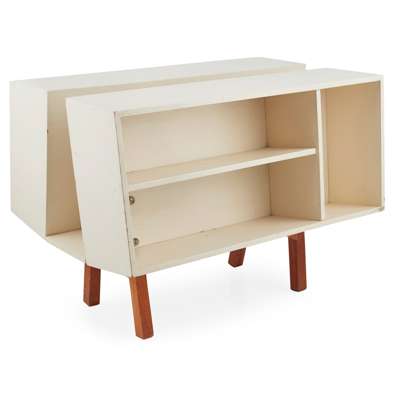
LOT 5752
ERNEST RACE (1913-1964) FOR ISOKON FURNITURE
`PENGUIN DONKEY` MARK II OPEN BOOKCASE, 1960S
SOLD FOR £350
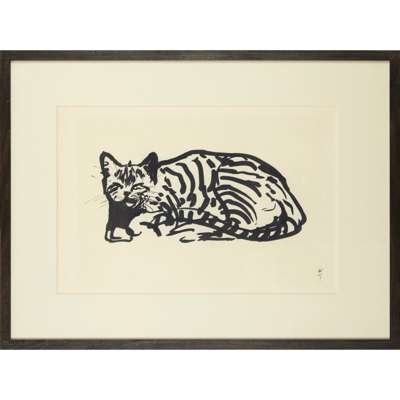
LOT 577
RENÉ GRUAU (1909-2004)
SEATED CAT
SOLD FOR £625
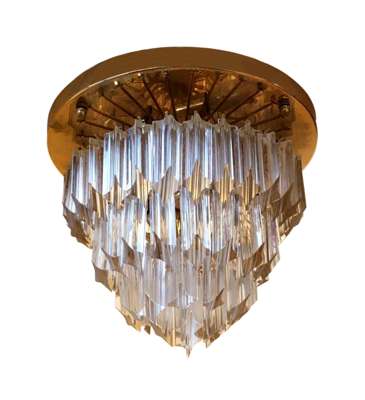
LOT 580
ATTRIBUTED TO VENINI, MURANO
PAIR OF 'ASTRA QUADRILOBO' CRYSTAL CHANDELIERS, CIRCA 1960
SOLD FOR £938
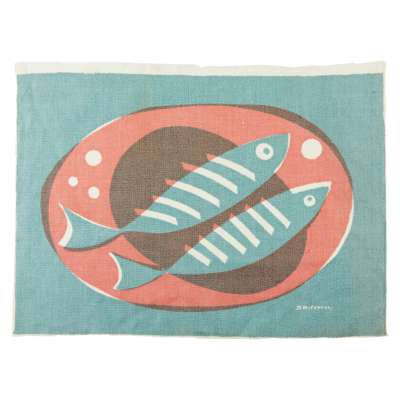
LOT 581
PORTHIA PRINTS, ST. IVES
GROUP OF TABLE LINENS, CIRCA 1955-60
SOLD FOR £4,500
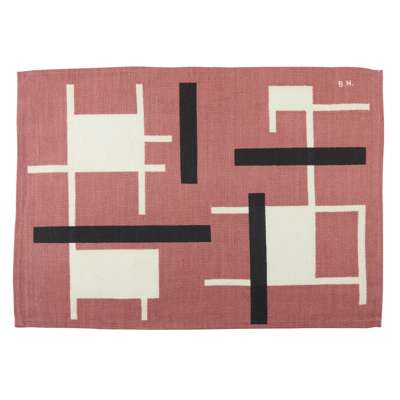
LOT 582
PORTHIA PRINTS, ST. IVES
GROUP OF TABLE LINENS, CIRCA 1955-60
SOLD FOR £5,000
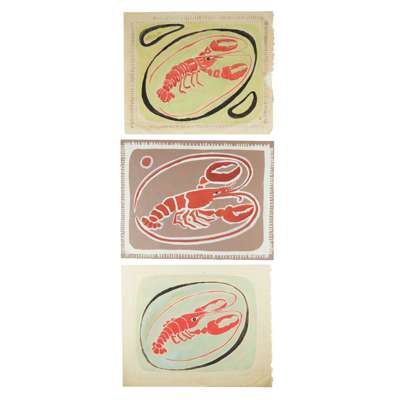
LOT 583
DENIS MITCHELL (1912-1993) FOR PORTHIA PRINTS, ST. IVES
FOLIO OF DESIGNS FOR TABLE MATS, MID-1950S
SOLD FOR £3,000
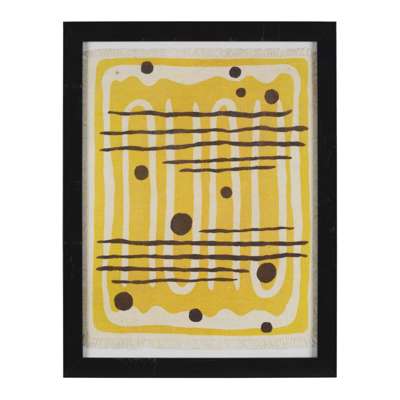
LOT 584
DENIS MITCHELL (1912-1993) FOR PORTHIA PRINTS, ST. IVES
FOUR FRAMED TABLE LINEN PANELS, CIRCA 1955-60
SOLD FOR £4,250
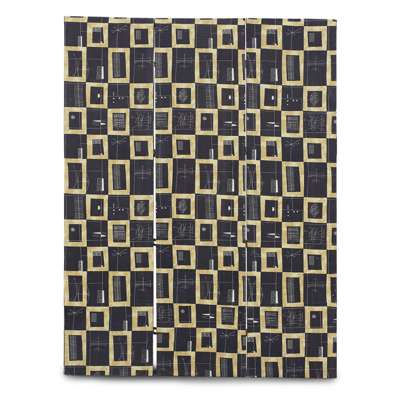
LOT 585
MANNER OF LUCIENNE DAY (FABRIC DESIGN)
THREE-FOLD SCREEN, 1950S
SOLD FOR £300
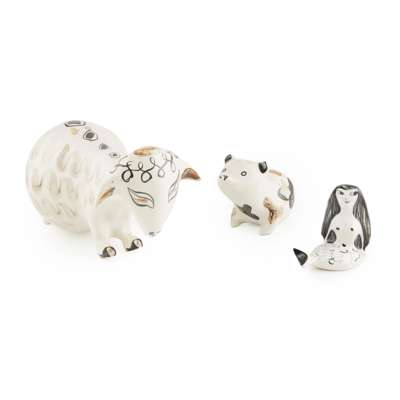
LOT 586
RICHARD PARKINSON (1927-1985) AND SUSAN PARKINSON (1925-2012)
SHEEP, MERMAID AND BEAR
SOLD FOR £325
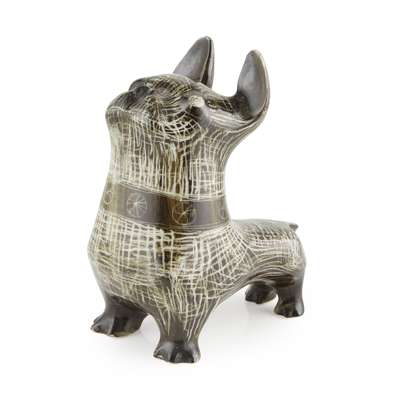
LOT 587
RICHARD PARKINSON (1927-1985) AND SUSAN PARKINSON (1925-2012)
'BEETLE' FRENCH BULL DOG
SOLD FOR £400
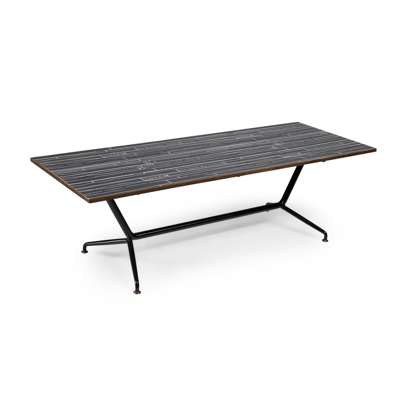
LOT 588
LUCIENNE DAY (1917-2010) (PATTERN DESIGNER) HEAL & SON (ATTRIBUTED MAKER)
COFFEE TABLE, 1950S
SOLD FOR £425
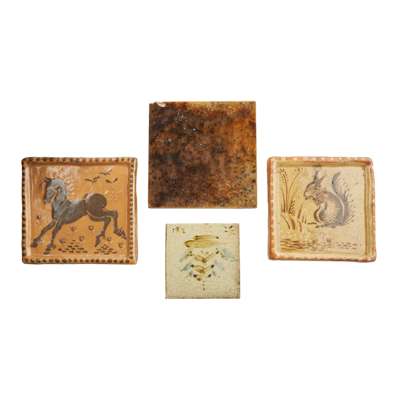
LOT 591
BERNARD LEACH (1887-1979)
ST IVES POTTERY STONEWARE TILE, MID 20TH CENTURY
SOLD FOR £425
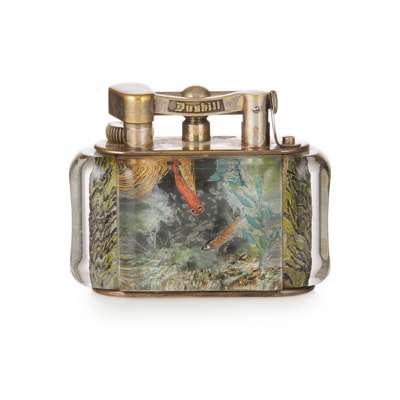
LOT 593
ALFRED DUNHILL, LONDON
'AQUARIUM' CIGARETTE LIGHTER, CIRCA 1950
SOLD FOR £2,500
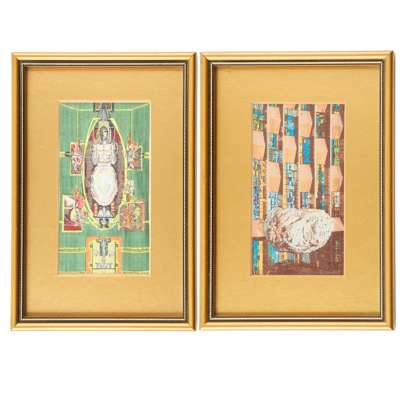
LOT 594
J. & J. CASH LTD. FOR COVENTRY CATHEDRAL
RARE JACQUARD-WOVEN SILK PANEL, CIRCA 1960
SOLD FOR £625
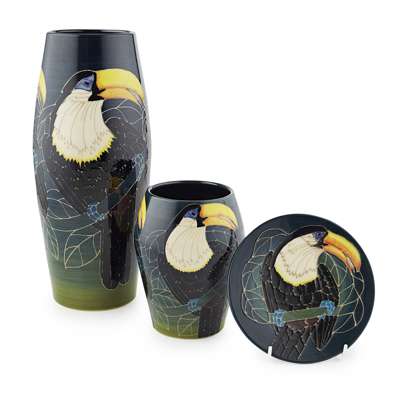
LOT 595
SALLY TUFFIN (B. 1938) FOR DENNIS CHINA WORKS
GROUP OF CERAMIC WARES
SOLD FOR £375
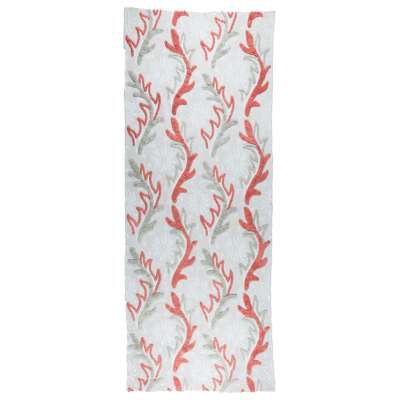
LOT 596
ALASTAIR MORTON (1910-1963) FOR EDINBURGH WEAVERS LTD.
‘FLORIAN’ FURNISHING FABRIC, DESIGNED 1949
SOLD FOR £400
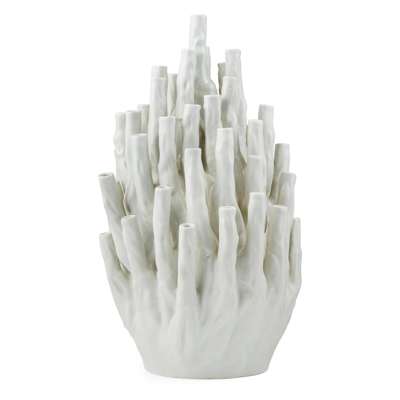
LOT 599
CONTEMPORARY MAKER
LARGE MULTI-STEMMED VESSEL
SOLD FOR £550
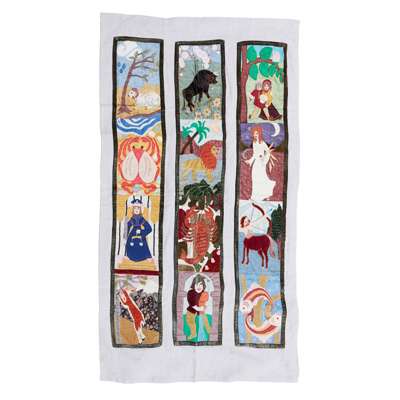
LOT 600
ENGLISH SCHOOL
ARTS & CRAFTS EMBROIDERED APPLIQUÉ PANEL, CIRCA 1950
SOLD FOR £475
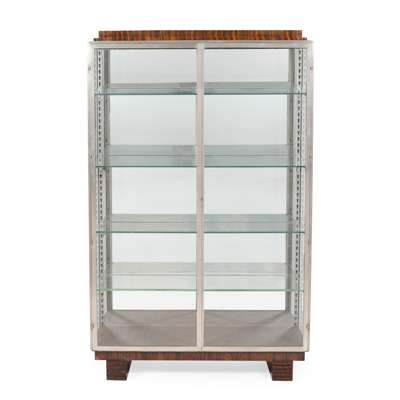
LOT 601
ENGLISH SCHOOL
CALAMANDER AND CHROME PLATED DISPLAY CABINET, MID-20TH CENTURY
SOLD FOR £2,250
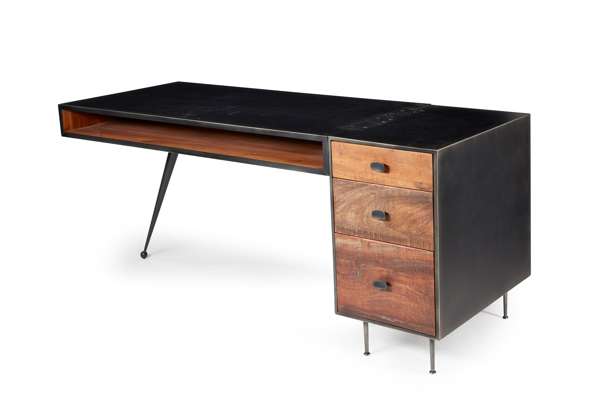
LOT 602
ENGLISH SCHOOL
DESK, CONTEMPORARY
SOLD FOR £1,375
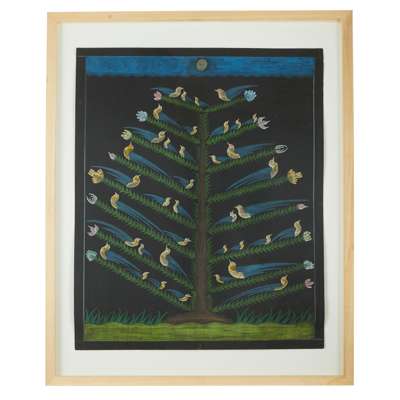
LOT 603
SCOTTIE WILSON (1890-1972)
UNTITLED - SW40
SOLD FOR £1,000

LOT 604
SCOTTIE WILSON (1888-1972)
PAINTED PLATE, CIRCA 1960
SOLD FOR £375
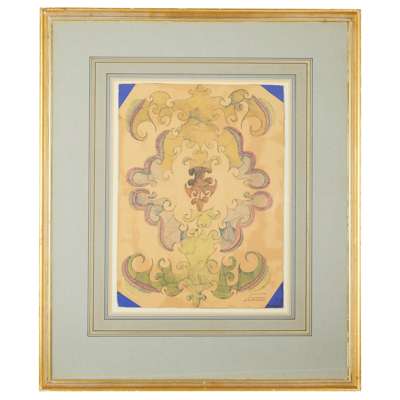
LOT 605
SCOTTIE WILSON (1890-1972)
COMPOSITION SW88
SOLD FOR £575
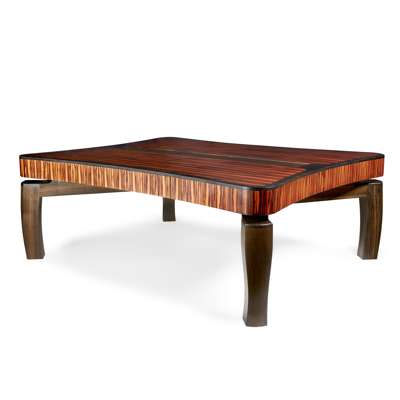
LOT 606
THE EDWARD BARNSLEY WORKSHOP
PARTNER'S DESK, CONTEMPORARY
SOLD FOR £7,500

